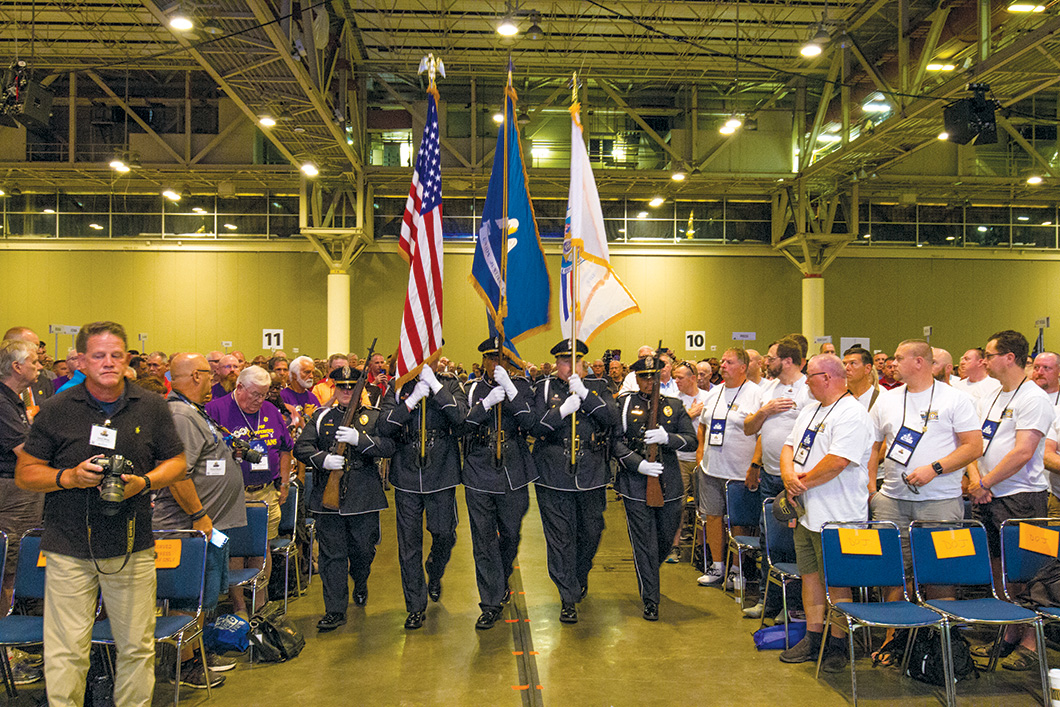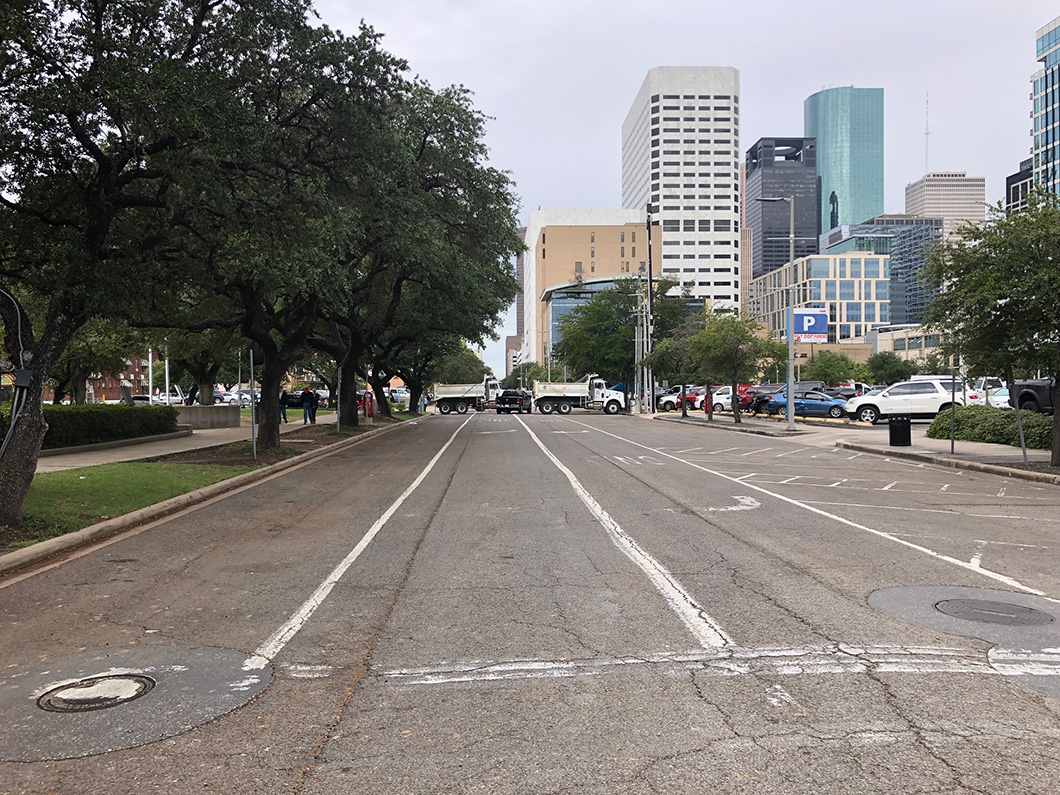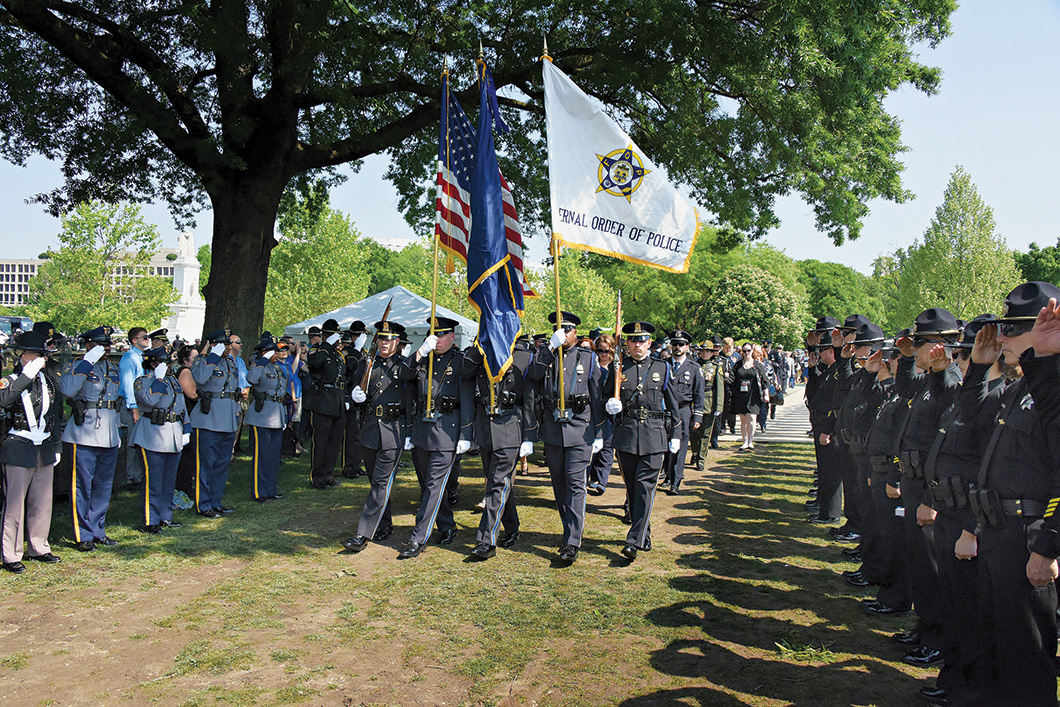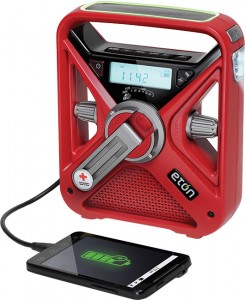Archives
Don’t Miss Out on Fun and Fellowship
Celebrating Freedom: Happy Independence Day!
See You in the Circle City!
Driving Innovation

Law enforcement vehicles aren’t your everyday family car. To meet the demands of police duty, they need room to haul lots of gear, house technology to support field operations, and provide protection for drivers and occupants under potentially tense circumstances. Every year, manufacturers design, test and release an assortment of products to meet those tough qualifications, from inserts and storage systems to racks and software programs. Get ready to roll with these selections from the latest generation of vehicle modifications and accessories, created to help you customize your space and work smart on the move.
 SoundOff Signal nFUSE Exterior Full Size Lightbar
SoundOff Signal nFUSE Exterior Full Size Lightbar
Raising the Bar
When you want to announce a law enforcement presence, colorful flashing lights send a clear message day or night. SoundOff Signal’s new nFUSE Exterior Full Size Lightbar modules alert all on scene with a slew of flash patterns, such as cruise mode or takedown. They can also be configured to shine in alley pattern or LRCO arrow. The bar’s sleek profile measures less than 2 inches in height, and departments can choose from a variety of lengths, from 36 inches to an expansive 72 inches. The outer lens is available in clear, amber, red or blue. The lightbar connects to the SoundOff Signal nERGY line of sirens and bluePRINT Control System. MSRP varies.
Get more information on this product ->
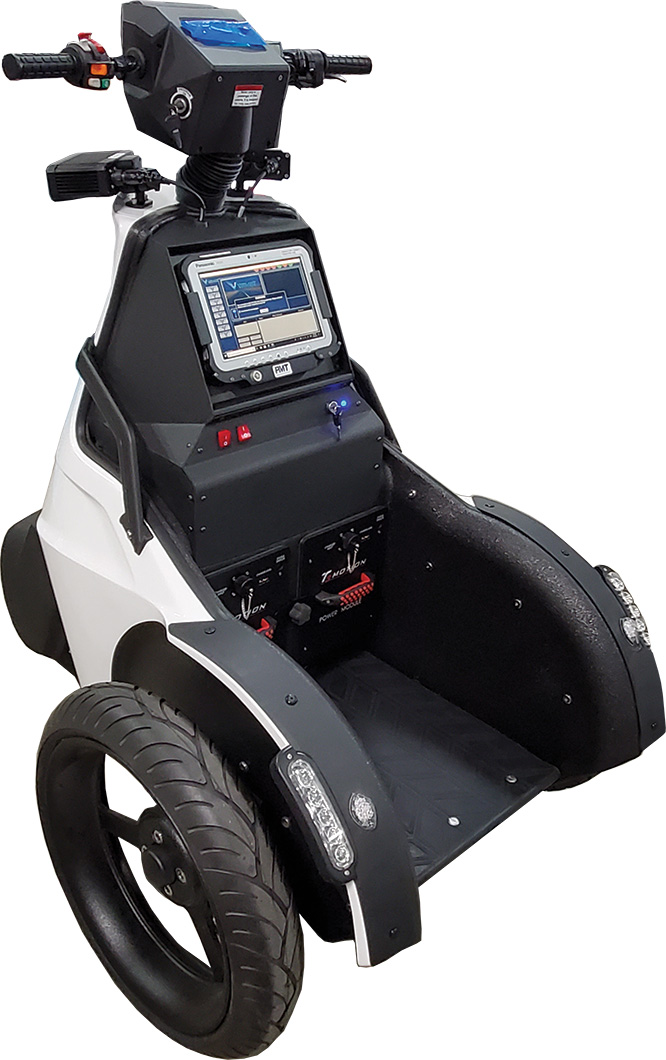 T3 Motion Vigilant ALPR
T3 Motion Vigilant ALPR
Standup Surveillance
Not your typical motorized device, the T3 Motion Vigilant ALPR combines the T3 Patroller electric standup vehicle with the Motorola Solutions Vigilant Mobile LPR license plate reader. The three-wheeled patroller handles curbs with grace, offers zero-degree turning radius and conveniently drives through confined spaces generally prohibitive to autos or even motorcycles. The quiet electric motor powers the vehicle up to 20 miles per hour and produces zero emissions. The addition of the LPR camera with 360 degrees of situational awareness enables users to scan plates in various environments and check for warrants and alerts, including scofflaw, against databases in real time for actionable intelligence and faster responses. MSRP varies.
Get more information on this product ->
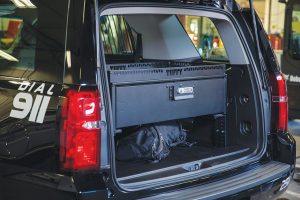 Tuffy Security Products Atlas Vault Lockable Drawer
Tuffy Security Products Atlas Vault Lockable Drawer
Mobile Vault
Whether you just want to keep valuables, paperwork or weapons away from prying eyes, or prevent items from being tossed around while taking turns at high speeds and bumping along unpredictable terrain, the Atlas Vault Lockable Drawer by Tuffy Security Products promises to protect its contents. Crafted out of 16-gauge steel, the heavy-duty drawer holds up to 100 pounds. The electronic 10-digit combination is set by the owner, but does come with a key override, too. The drawer rolls smoothly on stainless steel roller bearings. Mount the vault directly to the floor of any pickup or SUV with the steel mounting kit, or set it on risers 5–8 inches above the floor. MSRP less than $800.
Get more information on this product ->
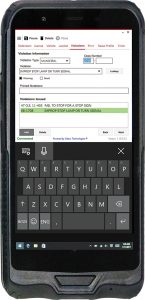 Saltus Technologies digiTICKET NS6 Ticket Writer
Saltus Technologies digiTICKET NS6 Ticket Writer
Ticket to Ride
The Saltus Technologies NS6 Ticket Writer elevates the functionality of the digiTICKET e-citations system and other public safety applications. For example, its onboard camera takes photos and pins them to e-citation files. It also notifies users of repeat offender status or scofflaw alerts. Because it runs on a Windows 10 OS, it’s compatible with many tablets and laptops if you prefer a larger screen than the handheld version. An optional 1D/2D barcode scanner can capture driver’s licenses, VINs and registration documents in a matter of seconds. The Gorilla Glass multi-touch screen responds quickly to a stylus and protects against water damage. The device also includes an accelerometer, gyroscope, e-compass and GPS. MSRP $1,650.
Get more information on this product ->
 Havis 2020 Ford Interceptor Utility K9 & Prisoner Transport Insert
Havis 2020 Ford Interceptor Utility K9 & Prisoner Transport Insert
Passenger Protection
Law enforcement professionals escort a variety of passengers, including suspects and prisoners who may become combative, as well as K9s that don’t conveniently fit into standard seatbelts. The Havis Next Generation K9 & Prisoner Transport Insert for the 2020 Ford Interceptor Utility Vehicle, including hybrid models, creates a safer environment for all. The front slider door exit has been redesigned to eliminate rattle, ensures a complete range of motion for full operability and boasts infinite locking points. Edges have been smoothed and gaps closed to prevent injuries for K9s. Dogs will appreciate the low-floor entry/egress, and their handlers will value the lack of chew points. The K9 compartment slides in on the passenger side, while the single-prisoner compartment, which includes a front bulkhead with upper clear polycarbonate guard, sits behind the driver. Fabricated from heavy-duty aluminum, the insert is available in white or black powder coat finish for easy cleaning. MSRP unavailable.
Get more information on this product ->
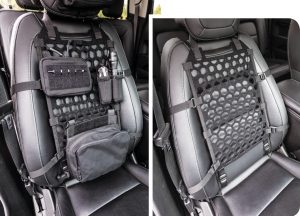 5.11 Tactical Vehicle Ready Hexgrid Platforms
5.11 Tactical Vehicle Ready Hexgrid Platforms
Space Saving
Law enforcement vehicles can get crowded very quickly. Finding extra storage space demands that you think beyond the usual suspects of trunk and floor. Designers at 5.11 Tactical seized upon the valuable real estate of a seat back to hold the Vehicle Ready Hexgrid Platforms. The patented multi-angle load-bearing system includes a headrest strap, removable side-seat straps and a quick-release padded seat wedge. Choose from a variety of MOLLE, hook-and-loop and Gear Set attachments to stash items for hassle-free retrieval. MSRP $44.99.
Powered Up

Software coded specifically for cops empowers law enforcement with time-saving efficiency and cutting-edge capability.
Like so many industries, policing has entered the world of Big Data and the Internet of Things. From the moment you’re dispatched on a call all the way through report writing, evidence logging and even reviewing investigation details to brief prosecutors or testify in court, there are heaps of data produced, collected and in need of organization. What differentiates law enforcement from other industries generating massive quantities of information is that officers — and, by extension, the communities they serve — depend on that information being delivered, processed and engaged in real time. Even on an administrative level, programmers have honed in on developing software solutions specific to the demands of running a police agency. So whether you’re the chief information officer or just a tech geek, you’re sure to appreciate the valuable impact the newest software options and enhancements to traditional law enforcement tools offer in the line of duty.
Nuance PowerMic III
 Speak Out
Speak Out
Writing reports is many police professionals’ least favorite aspect of the job. Typing out forms can be tedious and time-consuming. The PowerMic III speech-recognition microphone speeds up the process by translating dictation into the written word. Designed to work exclusively with the Dragon Professional Group software family, also produced by Nuance, this high-tech microphone is programmable to prefill standard report fields. Navigate within and between files with simple voice commands — in fact, it incorporates PC-mouse capabilities so there’s less switching between microphone, mouse and keyboard. Plus, the unidirectional microphone helps block out environmental noises for clear comprehension. MSRP $424.
Get more information on this product ->
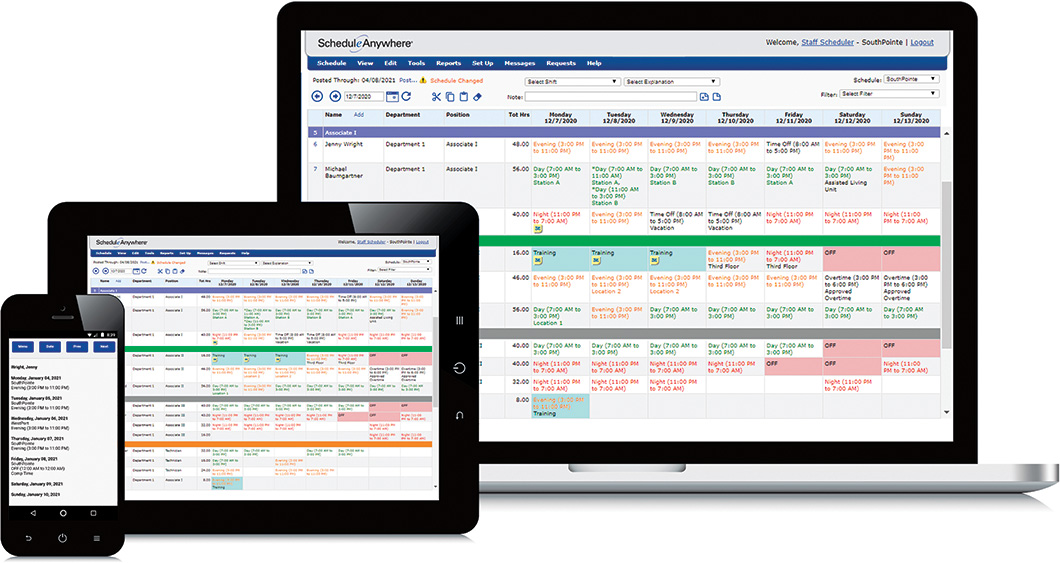 Atlas Business Solutions Inc. ScheduleAnywhere
Atlas Business Solutions Inc. ScheduleAnywhere
Managing Manpower
Deploying deputies, officers, detectives and other personnel isn’t just a function of command to cover law enforcement needs, it’s also a human resources responsibility. Tracking staff and the hours they work, including overtime, can get complicated — especially when crises crop up, as they tend to do. ScheduleAnywhere software by Atlas Business Solutions Inc. offers the flexibility to roll with changing circumstances. Key to the program is that users can log on from any computer or mobile device to rework schedules, assess staff availability, manage shift rotations and even request or approve time off. It also updates personnel files with new training and certifications. MSRP $25 per month.
Get more information on this product ->
![]() Envisage Technologies VaultRMS Exposure Tracker
Envisage Technologies VaultRMS Exposure Tracker
Handling Hazards
Police officers regularly come into contact with dangerous situations, but sometimes the danger arises from exposure to hazardous materials. Fentanyl, biological contaminants, environmental threats — these and so many other substances pose health risks that may require medical and other safety documentation. Envisage Technologies recently added VaultRMS’s Exposure Tracker to its FirstForward platform. A primary function of the software is to collect documents and other media related to exposure incidents, as well as recording use of protective gear and assessment of physical conditions before and after exposure. The system also automates management of training, policy and employment records, and even performance reviews. MSRP $10 per member.
Get more information on this product ->
 COBAN Command Center
COBAN Command Center
Virtual Vault
From crime-scene photos to emails to text messages to cryptocurrency — plus, of course, body-worn camera footage — more and more evidence is digital. But just like physical evidence, storage of digital files quickly becomes an issue, as does retrieval for case management purposes. COBAN’s Command Center is an integrated system that accepts various file formats, including video, across multiple sources. Departments can connect with local servers or engage a cloud option to house files, with easy access between each. Other features include case management organization and live policing applications, such as Interview Room. MSRP unavailable.

Get more information on this product ->
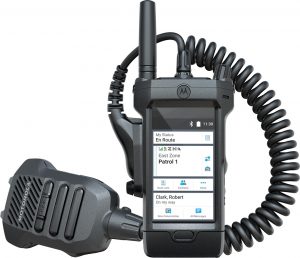 Motorola Solutions APX Next
Motorola Solutions APX Next
Smart Talk
Cops have been relying on radios for generations. Now, Motorola Solutions has redefined the communications device with the APX Next by adding several mission-critical apps. The ViQi program comprehends multiple natural language nuances for smoother voice-command operations. A secured cloud connection enables speech-to-text/text-to-speech queries as well as remote programming, so there’s no need for downtime to upgrade. Its platform augments data from the public safety landscape, such as traditional radio, broadband, video and various other sources. Plus, routing services send radio signals over broadband LTE for faster, more accurate officer locating. MSRP unavailable.

Get more information on this product ->
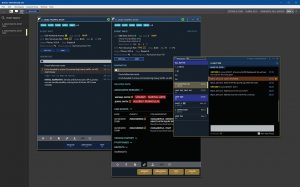 Mark43 Computer Aided Dispatch
Mark43 Computer Aided Dispatch
Real-Time Response
Any delays in dispatch can result in costly response delays. Even shaving off a few seconds can make a notable difference in emergencies. The Mark43 Computer Aided Dispatch system does just that by allowing operators to share pertinent details on screen with responders on site, as well as receiving feedback from the field in real time. GPS-AVL enables dispatchers to quickly map out units and direct the nearest officers to respond, another time-saver. An integration with E911 and emergency medical dispatch systems provides for multiagency coordination. Finally, the program accommodates personalized workflows for greater efficiency. MSRP unavailable.

Get more information on this product ->
Light ’em Up
 Law enforcement professionals rely on their senses to assess a scene and determine what actions must be taken to maintain safety for themselves and the public. Sight is especially critical for scanning surroundings, searching for evidence, observing suspects and watching the streets on patrol. Under less-optimal visual conditions like night, dusk, dawn or darkened buildings, it’s hard to confront what can’t be detected in the light of day. That’s why flashlights and other lighting gear have become invaluable tools for law enforcement. Still, not every illuminating device is fit for service. See how manufacturers are incorporating greater operability, reliability and durability into the latest lighting technology.
Law enforcement professionals rely on their senses to assess a scene and determine what actions must be taken to maintain safety for themselves and the public. Sight is especially critical for scanning surroundings, searching for evidence, observing suspects and watching the streets on patrol. Under less-optimal visual conditions like night, dusk, dawn or darkened buildings, it’s hard to confront what can’t be detected in the light of day. That’s why flashlights and other lighting gear have become invaluable tools for law enforcement. Still, not every illuminating device is fit for service. See how manufacturers are incorporating greater operability, reliability and durability into the latest lighting technology.
 PowerTac USA Patrol-LE10X
PowerTac USA Patrol-LE10X
/ Powered to Perform
Illuminating a scene, large or small, shouldn’t require multiple light sources. Thanks to the Patrol-LE10X from PowerTac USA, you can brighten things up with a wide-pattern flood-shaped beam that covers more than 400 meters. Users can count on long runtimes, more than 55 hours at the low of 155 lumens and more than six hours with strobe or SOS modes. Even at the highest brightness, 4,200 lumens, you’ll squeeze out nearly four hours of use. Recharge via a wall or 12-volt vehicle charging station. MSRP $229.95.
Get more information on this item ->
 Streamlight TLR-VIR II Tactical Illuminator
Streamlight TLR-VIR II Tactical Illuminator
/ Triple Threat
The Streamlight TLR-VIR II Tactical Illuminator combines three functions into one compact rail-mounted attachment for M17/M18 pistols or long guns. The first function produces a high-intensity white LED beam that burns at 5,000 candela and 300 lumens. The second, an integrated infrared illuminator, partners with the third, a Class 1 “Eye Safe” IR aiming laser, for precision shooting in low visibility. The infrared illumination is generated by an 850-nanometer LED emitter with 600 mW/sr radiant intensity. The laser technology includes adjustment controls for windage and elevation. Don’t worry about the powerful attachment throwing off aim by adding significant weight: It tips the scales at less than four ounces. MSRP $600.
Get more information on this item ->
 MF Tactical Delta Series XP-LHD LED
MF Tactical Delta Series XP-LHD LED
/ Updated & Upgraded
MF Tactical has incorporated numerous improvements into its redesigned tactical Delta Series XP-LHD LED flashlight. It measures less than six inches long (10% smaller) and less than six ounces (12% lighter), but housed within this petite profile is the power to run four distinctive modes, including strobe with memory capabilities and a stronger high beam (20% brighter). Its exterior consists of military-spec level III anodized aluminum, extra-thick, hardened mineral glass lens and a deep diamond, anti-slip knurling pattern handle that includes a magnetic base for hands-free use. MSRP $89.99.
Get more information on this item ->
 1TAC TC1200 PRO
1TAC TC1200 PRO
/ From Low to High
Officers will appreciate the utilitarian nature of the TC1200 PRO from 1TAC. Go from a high beam that shines upwards of two miles to low mode for a comfortable projection in close quarters with a few clicks of the recessed single-hand tail switch. Other modes include medium beam, strobe and SOS flashing. This tactical model also boasts a magnetic base and built-in utility clip for operation without impeding movement or demanding extra attention. An aircraft-grade aluminum casing offers protection against drops, impacts and corrosion. MSRP $96.

Get more information on this product ->
 FLIR Scion Professional Thermal Monocular
FLIR Scion Professional Thermal Monocular
/ Eyeing the Heat
Designers at FLIR Systems Inc. loaded the Scion Professional Thermal Monocular with a laundry list of features intended to enhance performance for public safety professionals. Most importantly, the FLIR Boson thermal core clearly captures images in low visibility. Additional components allow operators to zoom in on subjects incrementally and as a picture-in-picture option. Two gigabytes of internal memory plus microSD card accessibility store recordings of geotagged video and still images. Pair the monocular with FLIR’s truWITNESS technology for real-time encryption to protect digital files. MSRP $3,295.

Get more information on this product ->
 Maglite ML150LR
Maglite ML150LR
/ Fast Focus
Standard torches are great under standard circumstances, but demands on law enforcement don’t conveniently fit into standard parameters. There’s always the potential for the unexpected, and your light should respond accordingly. Maglite’s ML150LR rechargeable flashlight system is all about quick reactions. The QuickFocus and QuickClick features enable users to switch modes with minimal effort. Plus, a customizable interface encourages users to set preferred functions that speed up response times even more. Charge time is pretty quick, too, clocking in at less than three hours. Runtime is the only characteristic that purposefully slows down; operation lasts three hours on high and 79 hours on eco mode. MSRP $120.
Substance & Style
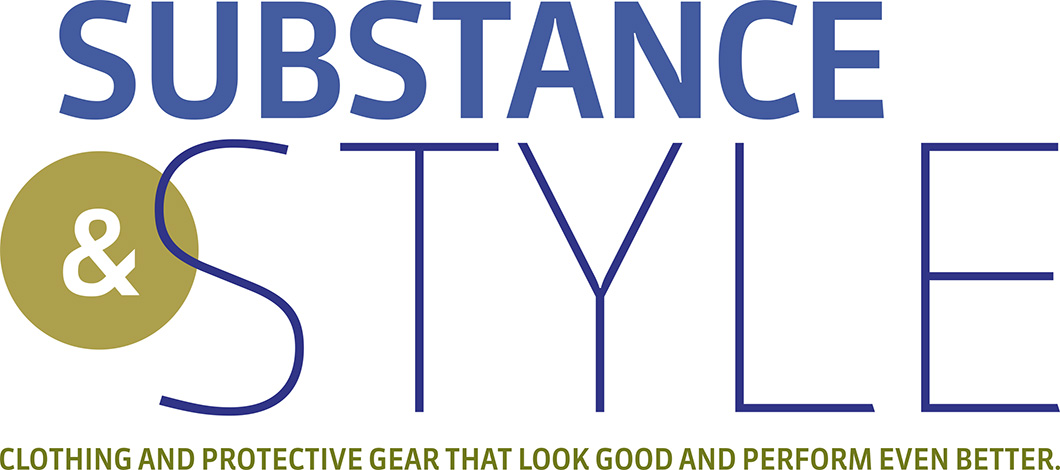
“Dressed for success” takes on a whole different meaning when you’re talking about tactical apparel. Law enforcement professionals expect their clothing to meet multiple standards. In addition to looking professional, tactical clothes and accessories must be constructed out of durable material, strong enough to take on the roughest of conditions. For added value, shirts, pants and vests should provide storage options, such as concealed pockets. Protective layers should never compromise an officer’s ability to freely move. And in order for accessories — such as belts, eyewear and footwear — to qualify as tactical, they need to offer functional features not found in civilian versions. See what else tactical apparel designers have created to enhance law enforcement officers’ ability to do the job.
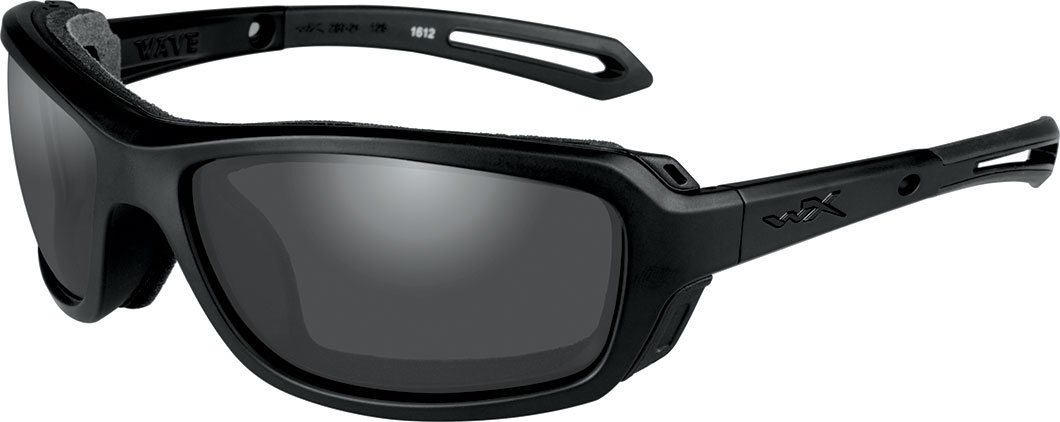 WILEY X
WILEY X
WX Wave Black Ops
Eye on the Job
Even in winter, sunglasses serve a vital role for officers. They can guard eyes from daytime glare and snow reflection, plus conceal where your attention is directed. The smoke gray lenses of the Wiley X Wave Black Ops glasses do just that while also meeting safety standards for optical clarity. They’re also prescription ready. The matte black frames are highlighted by half-rubber temples for both flexibility and a nonslip-grip fit. A T-Peg elastic strap is included to provide extra security. The glasses also satisfy standards for high-mass/high-velocity impacts. MSRP $100.
Get more information on this item ->
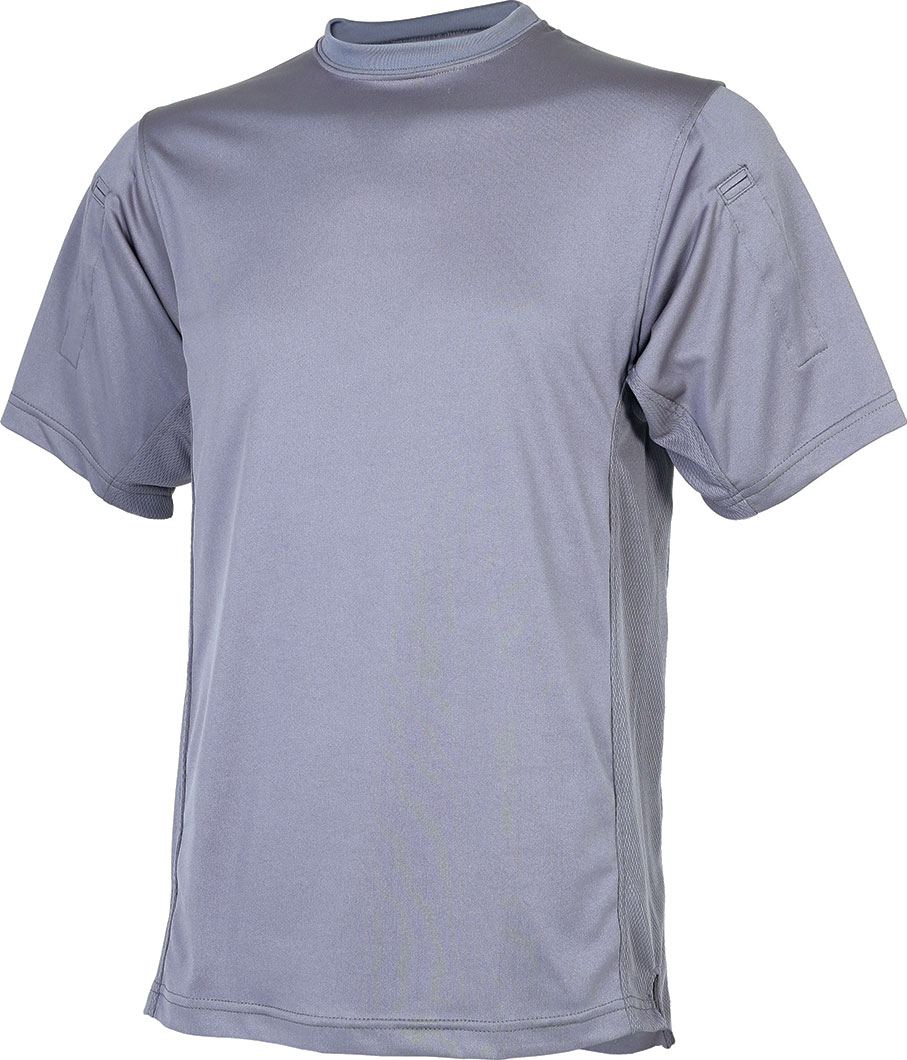 Tru-Spec
Tru-Spec
24-7 Series Eco Tec Tac T-Shirt
Material Matters
The 24-7 Series Eco Tec Tac T-shirt from Tru-Spec offers a lot of the features necessary to perform tactical tasks. The anti-microbial and moisture-wicking properties keep people dry even in cold temperatures. Each sleeve contains a convenient pen stall. Mesh side gussets allow for airflow, and a split drop-tail hem enhances back coverage. But it’s the material that makes the difference. The no-pill, no-snag, four-way stretch fabric contains Repreve polyester, which is made out of recycled plastic bottles and has been certified as one of most earth-friendly fibers. Sizes S–4XL. MMSRP $22.95.
Get more information on this item ->
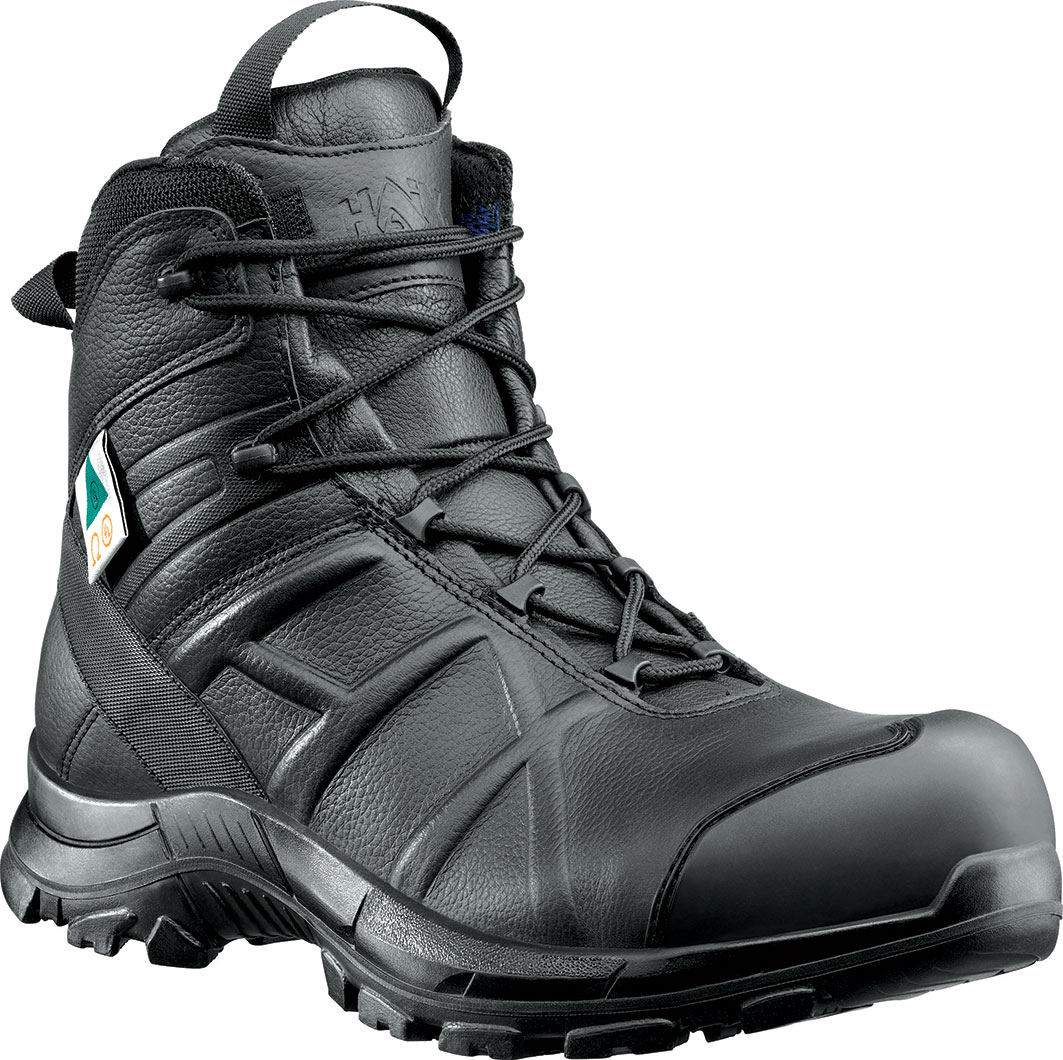 HAIX
HAIX
Black Eagle Safety 55 Mid SZ
Find Your Footing
From cold temperatures to slippery surfaces, winter can be tough on feet. Black Eagle Safety 55 Mid SZ boots from HAIX address many environmental and situational considerations, such as keeping feet warm and dry in the harshest weather conditions. While the Secura liner is sealed along the upper leather to keep cold out and heat in, the inner lining tackles many vital tasks. It’s watertight, abrasion resistant and prevents against blood and body fluids. The boot’s exterior handles multiple terrains — the sole is molded out of a nonslip, nonmarking rubber that’s also protected against heat, oil and gasoline. The Vario Wide Fit system allows for a more personalized fit for ultimate comfort. U.S. sizes 4–16. MMSRP $299.
Get more information on this item ->
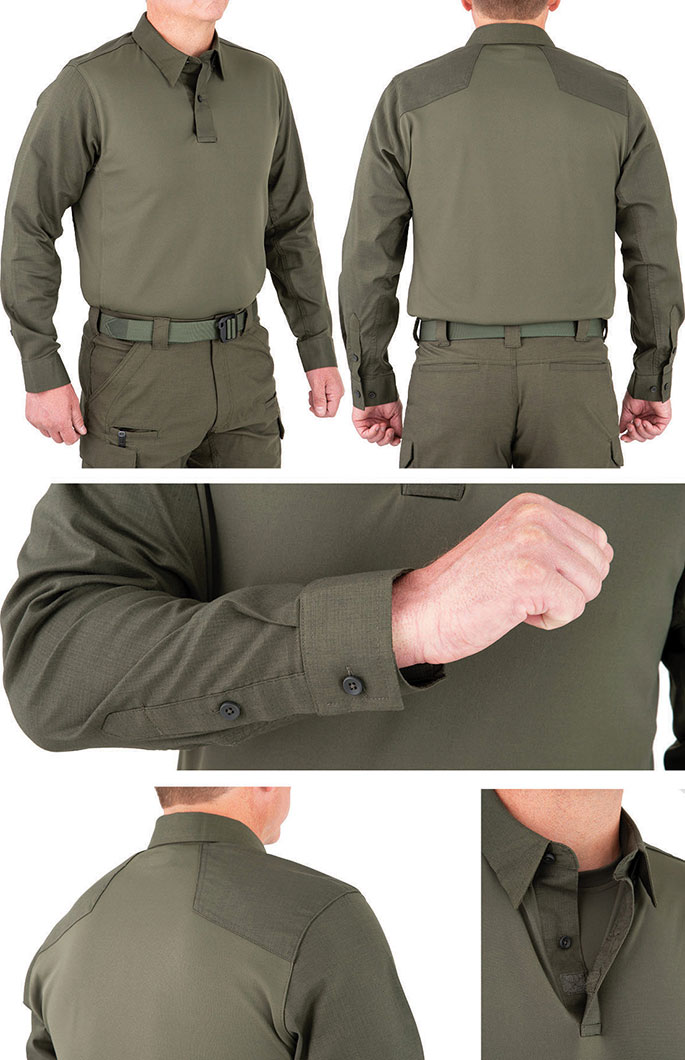 First Tactical
First Tactical
V2 Pro Performance Shirt
Look Good, Feel Great
First Tactical combined the classical features of its popular Performing Polo shirt with the utilitarian nature of its V2 shirt to create the hybrid V2 Pro Performance Shirt. The professional appearance is enhanced by a no-curl collar, hidden buttons and ID write bar. General wearability is complemented by an Arms Technology Mechanical Stretch, anti-snag jersey body material, which has a wicking and anti-odor finish. There’s also a double-layer woven yoke and running gusseted construction under arms to extend durability. It comes in midnight blue, green and black colors, as well as men’s and women’s sizes. MMSRP $49.99.
Get more information on this item ->
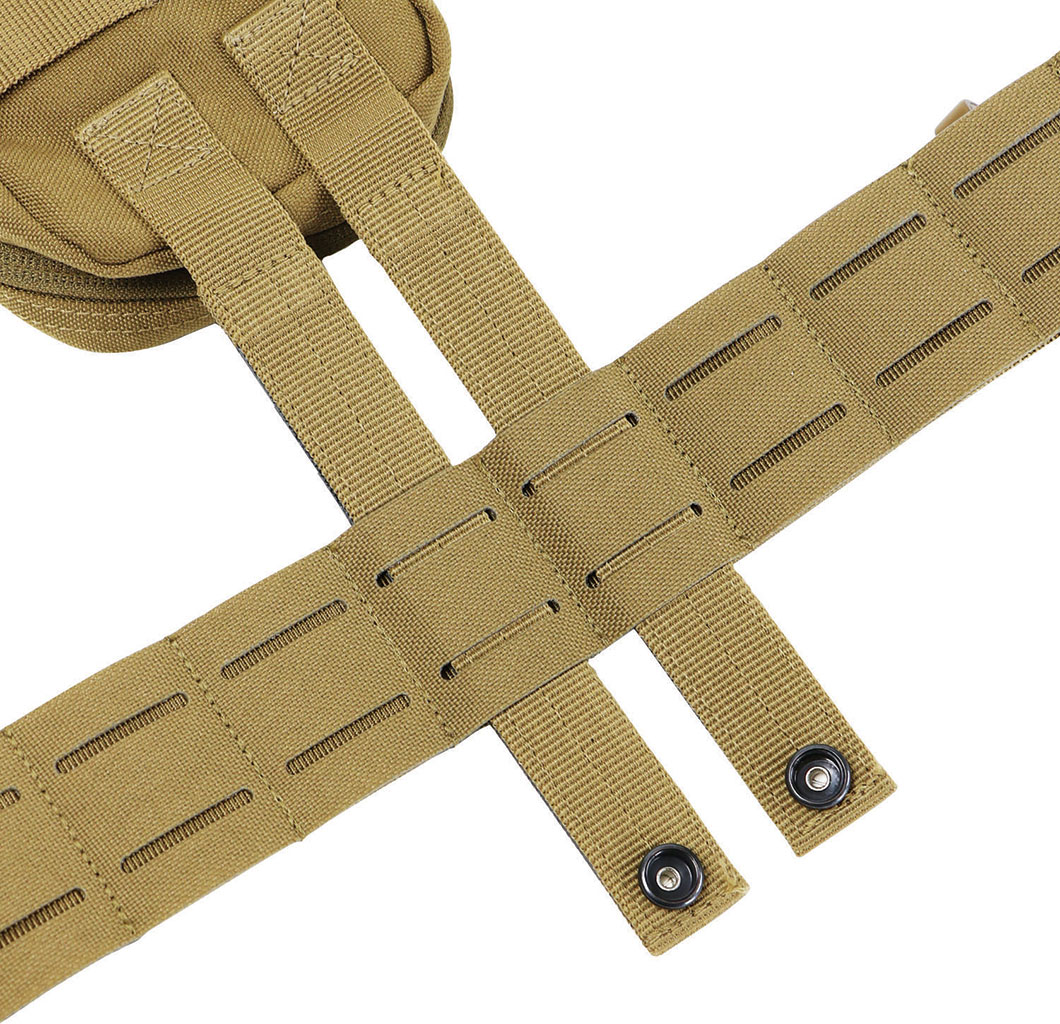 Condor
Condor
LCS Cobra Gun Belt
Belted In
With not one, but two layers of webbing, you know the LCS Cobra Gun Belt was built to take on big jobs. Condor designers started with a 2-inch heavy-duty webbing on which they layered SCUBA webbing. Combined, the materials increase the capacity to carry heavy loads. Laser-cut slots easily accommodate modular attachments. Also, the belt can be worn as part of a two-belt system. Users can remove the inner anti-slip pad if seeking a sleeker fit. The belt is available in OD, black and coyote brown, and measures from small/medium (up to 38.5 inches in length) to large/extra-large (up to 50.5 inches in length). MMSRP $80.95.
Get more information on this item ->
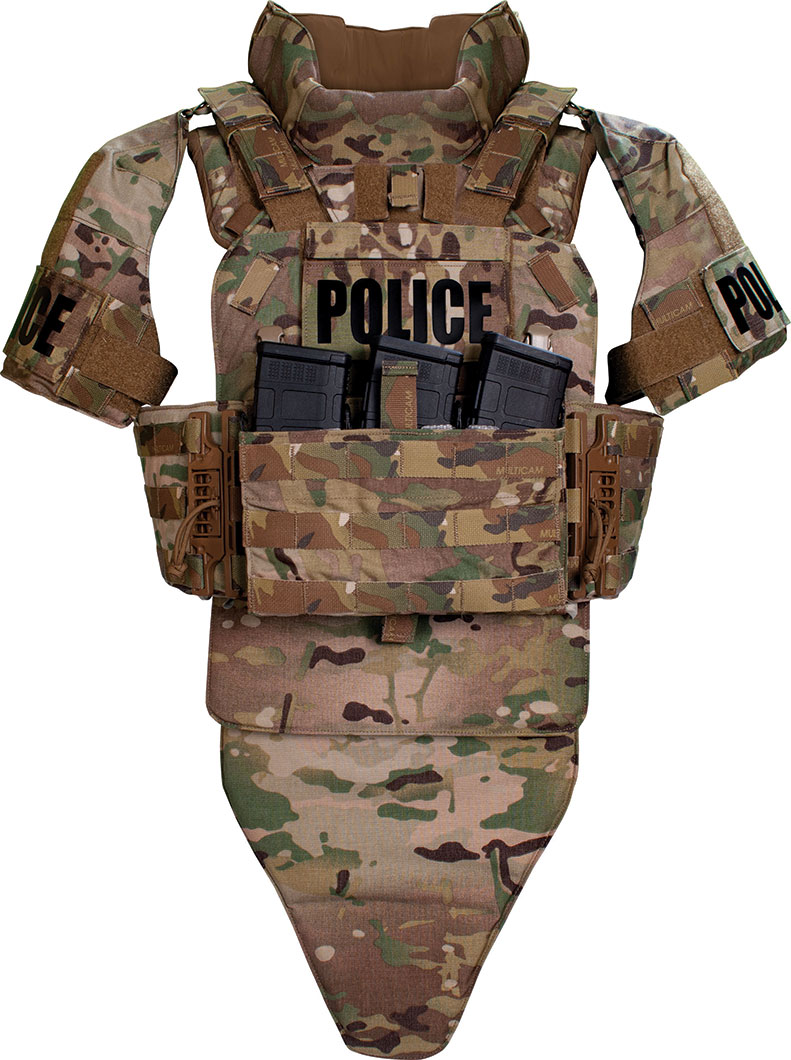 Point Blank Enterprises
Point Blank Enterprises
Paraclete Special Response Vest
Invested in Safety
Adaptable, multifunctional, durable and protective are all adjectives that describe the Paraclete Special Response Vest by Point Blank Enterprises. Users can configure the front panel to adapt to situational needs. Its hard armor plate pocket can house Shooter’s cut plates while the back armor plate compartment accepts Shooter’s or rectangle plates. The front ID panel hides an admin pocket. Several optional accessories can be added to the vest, such as a collar, yokes and other inserts. Additional features include Aspetto buckles for swift release and two hidden radio/magazine pockets on each side. The material is a MOLLE-compatible webbing, combined with a spacer mesh and Tweave liner for comfort. MMSRP base vest $1,740–$2,442; complete system $3,222–$4,665.
Get more information on this item ->
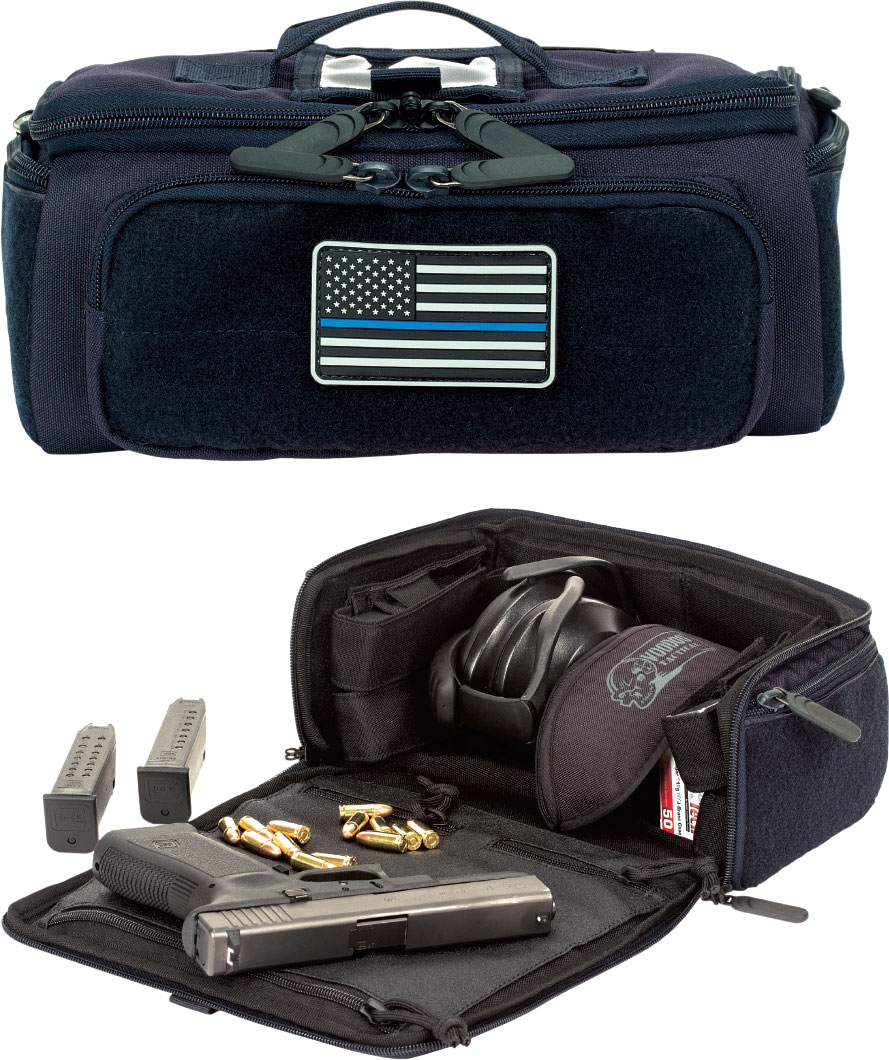 Voodoo Tactical
Voodoo Tactical
Valor Standard 10-Ring “Q” Bag
It’s in the Bag
Fashion gurus always suggest matching a bag to your outfit, and for law enforcement professionals, that means finding a carrying case specifically outfitted to hold necessary tactical gear. The Voodoo Tactical Valor Standard 10-Ring “Q” Bag was specifically crafted for field duty. It’s compact enough to easily be stashed inside a patrol bag, but large enough to safely store eye and ear protection, gun-cleaning items as well as ammunition and magazines. In fact, there are two removable double-mag pouches. A rollout mat creates a clean surface for weapons cleaning, and on the outside you’ll find side and rear pockets. Locking zippers protect contents. MMSRP $58.95.
Get more information on this item ->
Back-to-School Basics

The world of academia exploded in scandal this year when news broke of celebrities and wealthy parents allegedly cheating the system to get their children admitted to Ivy League schools. Such stories can make college admissions sound like an ultra-competitive nightmare, but never fear: If you want to pursue a degree as a working professional, you’ll find that most institutions — especially those tailored for adult learners, like the members of the National FOP University Consortium — recognize the demands of balancing school, work and family, and try to make the admissions process accessible and accommodating. Of course, it helps if you do a little studying of your own. Here, admissions officials and graduates guide you through the key steps along the path toward higher education.
1. Set Goals
Why do you want to earn a degree? How will education benefit your career? According to the Police Foundation, more than half of the nation’s law enforcement agencies offer at least one incentive for continuing education, such as mandating a degree for promotion or offering greater pay for a four-year degree.
“I wanted to do something to not only advance in my current career, but also to make myself marketable after retirement from police work,” says Jacob Morris of his decision to enroll in Ashland University for a bachelor’s degree in criminal justice. The Lorain Police Department sergeant, a member of Ohio FOP Lodge #3, graduated in 2017 and has since completed a master’s program at Bowling Green University.
This is the stage to determine the scope of your educational goals. Decide on type of degree, area of study and whether you want a specialized concentration within the field.
2. Research Schools
Degree programs differ in coursework and instructional formats. Some are taught exclusively online, others require in-person attendance and some provide a hybrid of the two. Ask yourself which arrangement will suit your study style as well as professional and personal demands.
“It is important they research the program offerings, learning modalities, university support services and financing options available to determine the best fit for their individual needs,” says Jamie Jaynes, vice president for admissions at the University of Maryland University College.
Also, it’s advisable to stick with accredited institutions. “Regional accreditation is the highest level, and nationally accredited is a much lower standard,” says Erik Fritsvold, Ph.D., professor of sociology and academic director for the Law Enforcement and Public Safety Leadership master’s degree program at the University of San Diego.
Next, study the curriculum. “Is it specifically designed to serve law enforcement, or is it masquerading as law enforcement-centric to attract students?” asks Fritsvold. “Make sure the skills and content have practical value.”
Before finalizing your top choices, inquire whether previously earned credits, military service and/or work experience will transfer. “We evaluate many forms of nontraditional credit, including military training, certifications and learning evaluated by the American Council on Education, and various forms of public safety training. We also have a Prior Learning Assessment program designed to evaluate learning gained while working, although transfer credit is not guaranteed and depends on the student’s degree program,” says Dennis Porter, senior law enforcement education coordinator for American Military University.
3. Calculate Finances
Higher education comes with a high price tag, so investigate financial resources. According to the Police Foundation, nearly 75% of agencies offer tuition reimbursement for work-related college courses. Approximately 30% reimburse for any college class. Be sure to read the fine print — some departments ask for proof of passing grades before releasing funds.
Have you served in the military? Per the U.S. Department of Veterans Affairs, post-9/11 veterans with at least 90 days of aggregate active duty are eligible for education benefits. Many universities have counselors or representatives well-versed in these details to guide applicants through the documentation.
Also, nontraditional undergraduate students may qualify for federal student aid, including grants that don’t need repayment — graduate students can receive loans, but generally aren’t eligible for grants. The application period opens each October for the following academic year, and applicants submit data from the most recent tax return. Schools determine amounts based on need, accounting for nontraditional students’ economic circumstances, including the number of dependents, employment status and even medical bills. Note that unsubsidized loans accumulate interest as soon as monies are dispersed; however, interest on subsidized loans is deferred while attending classes at least half-time. Terms of private loans vary.
 “I took out student loans because I didn’t want to work overtime to pay as I went. I thought that would be counterproductive,” says Kenneth Ehrman, an investigator for the California Department of Motor Vehicles, vice president of California FOP Lodge #77 in Sacramento and sergeant at arms for the California State Lodge. Ehrman received a master’s degree from the University of San Diego in 2017.
“I took out student loans because I didn’t want to work overtime to pay as I went. I thought that would be counterproductive,” says Kenneth Ehrman, an investigator for the California Department of Motor Vehicles, vice president of California FOP Lodge #77 in Sacramento and sergeant at arms for the California State Lodge. Ehrman received a master’s degree from the University of San Diego in 2017.
And, don’t forget about scholarships, available based on criteria such as organization membership, ethnic and cultural heritage, and financial need.
“If you spend 10 hours finding a scholarship that lands you $1,000, you just paid yourself $100 per hour,” notes Bernie Banning, director of graduate, online and adult admissions for Ashland University.
“The university awards a large number of scholarships once a year through a separate application process for Upper Iowa University students,” notes Dawn Novak, assistant vice president for enrollment management for Upper Iowa University.
“Tiffin University also offers a long list of corporate partnerships, including discounts to FOP members. Other large discount programs include active military and their families, reserves and military retirees,” says Nikki Hintze, executive director for online Enrollment Management for Tiffin University.
4. Apply
It’s finally time to apply. Online forms are self-explanatory, but be prepared with names of schools and dates of attendance for previous studies. In most cases, working professionals will not have to provide ACT/SAT scores or take the Graduate Record Examination for online graduate programs. That said, institutions may mandate testing for course placement.
“There are much better tests to see where a person is at in two areas all majors require: English composition and mathematics. They will be tested to see where they are at and need to start,” says Andrew Coggins Jr., assistant director of admissions for the University of Cincinnati.

Don’t hesitate to contact an admissions counselor with questions.
“I never had a problem getting an answer. They were always available and eager to help,” remembers Brian Meek of his application process for a master’s degree in intelligence studies from the American Military University. The U.S. Drug Enforcement Administration diversion investigator is a member of Arizona FOP Lodge #14 and retired from the Phoenix Police Department in 2017.
5. Prep for Class
“Because financial aid increases with the number of courses taken, many students attempt to take too many courses to maximize aid,” says Porter. “They end up needing to drop courses, or worse yet, fail courses because they took too many at the outset. Being realistic with the time you can devote to your studies is absolutely vital to academic success.”
Be sure to build a strong support network. Notify supervisors in case you need scheduling accommodations. Arrange a homework routine with family. Also, engage the formal services offered by the school.
“With the Admission Office and Advising Office working side by side, students at Tiffin University will have a go-to person every step of the way,” says Hintze.
No doubt going back to school requires a big commitment of time, energy and resources; however, the return on investment can pay off throughout one’s career, both in and out of law enforcement.
Body Conscious
 Since the 1970s, law enforcement officers have increasingly donned protective gear, from vests to helmets and shields, and for good reason. Evidence indicates that body armor makes a notable difference in lessening the impact of job-related injuries. According to a study conducted by the International Association of Chiefs of Police Center for Officer Safety and Wellness along with the Bureau of Justice Assistance, officers wearing body armor reported missing fewer days of work as well as spending less time in rehabilitation treatments after sustaining injuries on duty compared with those who hadn’t added the protective layers. What’s even more encouraging is that new designs incorporate advanced materials and user-friendly technology for greater efficacy and comfort. Here are a few examples of how the latest generation of body armor can keep officers safer on the job.
Since the 1970s, law enforcement officers have increasingly donned protective gear, from vests to helmets and shields, and for good reason. Evidence indicates that body armor makes a notable difference in lessening the impact of job-related injuries. According to a study conducted by the International Association of Chiefs of Police Center for Officer Safety and Wellness along with the Bureau of Justice Assistance, officers wearing body armor reported missing fewer days of work as well as spending less time in rehabilitation treatments after sustaining injuries on duty compared with those who hadn’t added the protective layers. What’s even more encouraging is that new designs incorporate advanced materials and user-friendly technology for greater efficacy and comfort. Here are a few examples of how the latest generation of body armor can keep officers safer on the job.
Angel Armor RISE 2.0 Armor System
Proper Weight Distribution
 Body armor shouldn’t have to feel as if you’re lugging around a heavy load. In updating RISE, Angel Armor designers used a ballistic suspension system to distribute the armor’s weight so that it provides comfort, too. The adjustable QuadCore Attachment System allows for a more custom fit. RISE can be worn externally, with optional low-profile PALS/MOLLE or Velcro chest and back sections, and is intended to be paired with the company’s Truth SNAP rifle plates. It also accommodates multiple plate sizes for concealed use. The outer shell materials resist abrasion, tearing and stretching. MSRP $679–$899.
Body armor shouldn’t have to feel as if you’re lugging around a heavy load. In updating RISE, Angel Armor designers used a ballistic suspension system to distribute the armor’s weight so that it provides comfort, too. The adjustable QuadCore Attachment System allows for a more custom fit. RISE can be worn externally, with optional low-profile PALS/MOLLE or Velcro chest and back sections, and is intended to be paired with the company’s Truth SNAP rifle plates. It also accommodates multiple plate sizes for concealed use. The outer shell materials resist abrasion, tearing and stretching. MSRP $679–$899.
Get more information on this product ->
Point Blank Enterprises K-9 Tactical K-9 Operations Vest
In Defense of Dogs
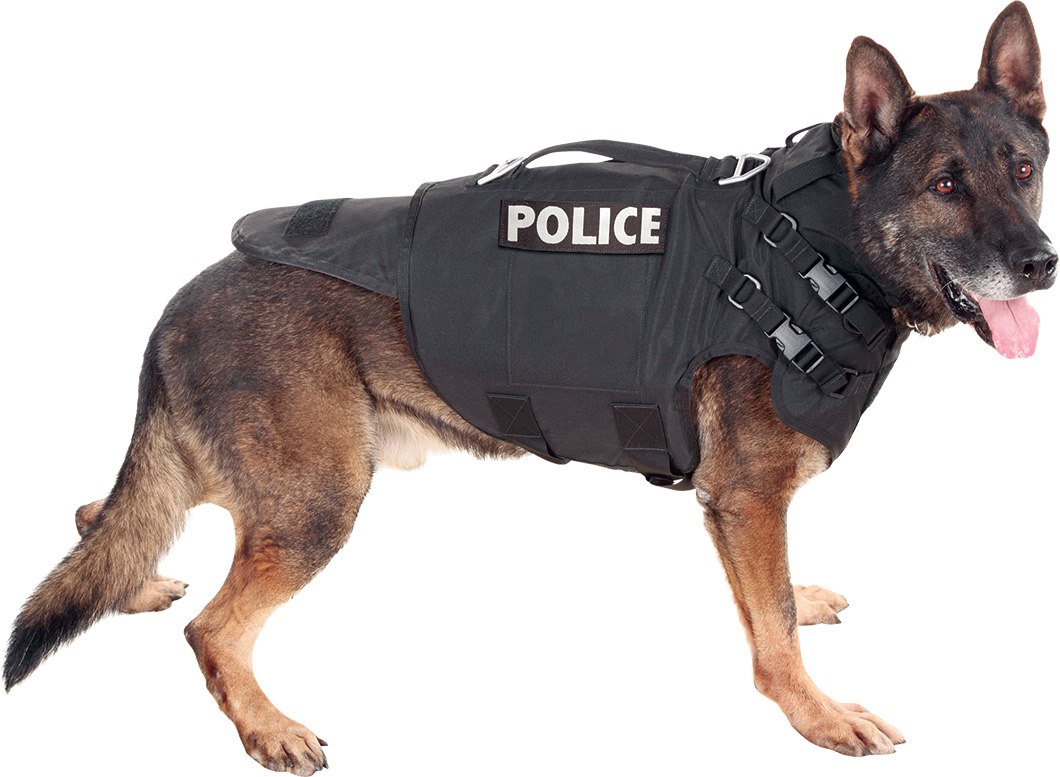 The K-9 Operations Vest by Point Blank Enterprises provides police dogs with extensive coverage via a body, chest and tail outer shell constructed from a durable, abrasion-resistant material. The split collar allows for a full range of motion. Handlers will appreciate the built-in harness guides and oversized mil-spec D-ring readied for quick lead attachment. The vest also can be put on and taken off quickly. MSRP unavailable.
The K-9 Operations Vest by Point Blank Enterprises provides police dogs with extensive coverage via a body, chest and tail outer shell constructed from a durable, abrasion-resistant material. The split collar allows for a full range of motion. Handlers will appreciate the built-in harness guides and oversized mil-spec D-ring readied for quick lead attachment. The vest also can be put on and taken off quickly. MSRP unavailable.
Get more information on this product ->
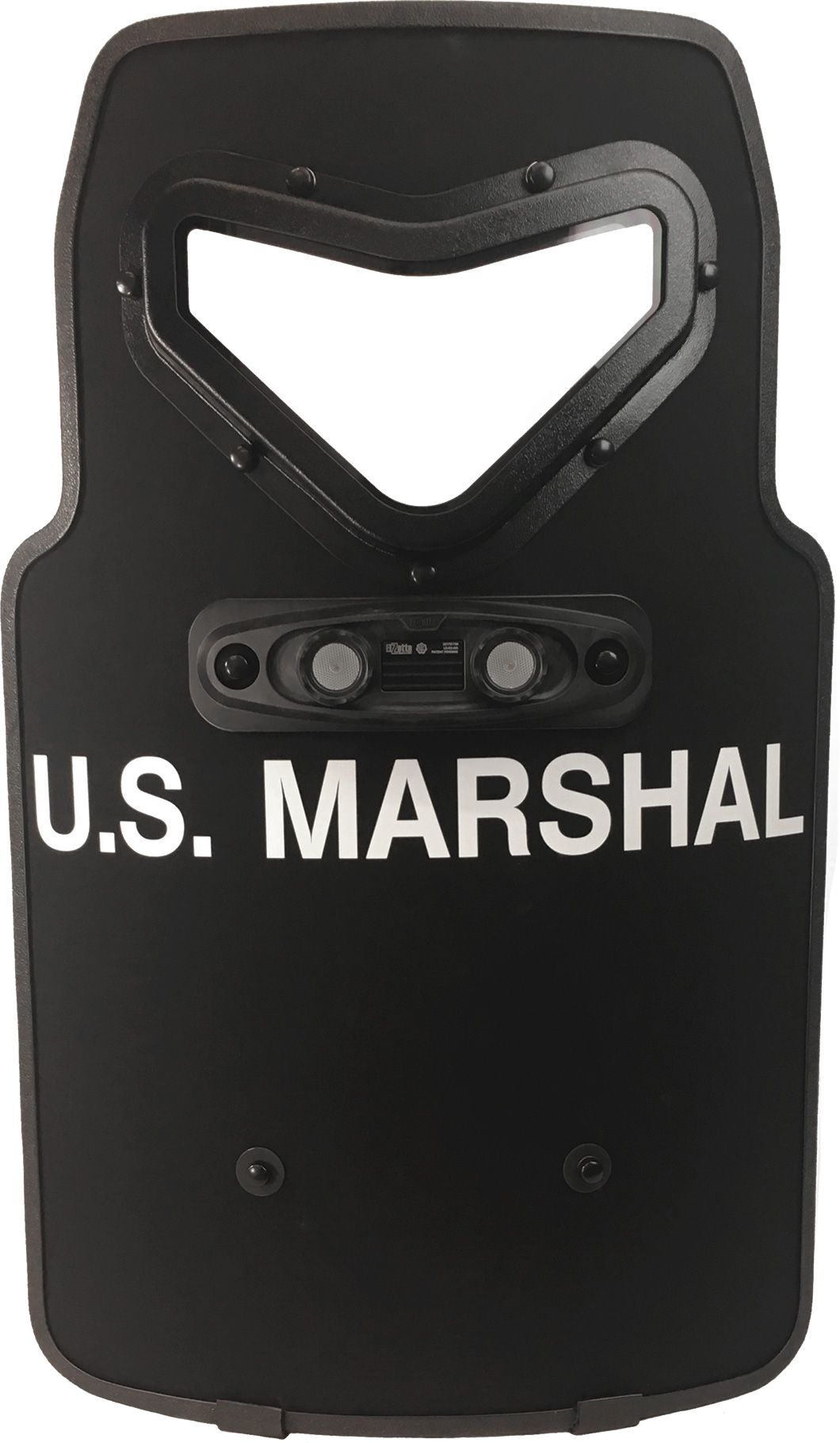 BlueRidge Armor Vengeance IIIA Ballistic Shield
BlueRidge Armor Vengeance IIIA Ballistic Shield
Shields Up
Crafted with input from experienced federal law enforcement professionals, the BlueRidge Armor Vengeance IIIA Ballistic Shield puts up a strategic barrier between officer and offender. This product line is distinguished by a patent-pending Vengeance Viewport, which permits a wide field of view, including greater peripheral vision to help users identify tripping hazards. The shield is made in the United States out of materials sourced from the U.S. MSRP $3,499.99.
Get more information on this product ->
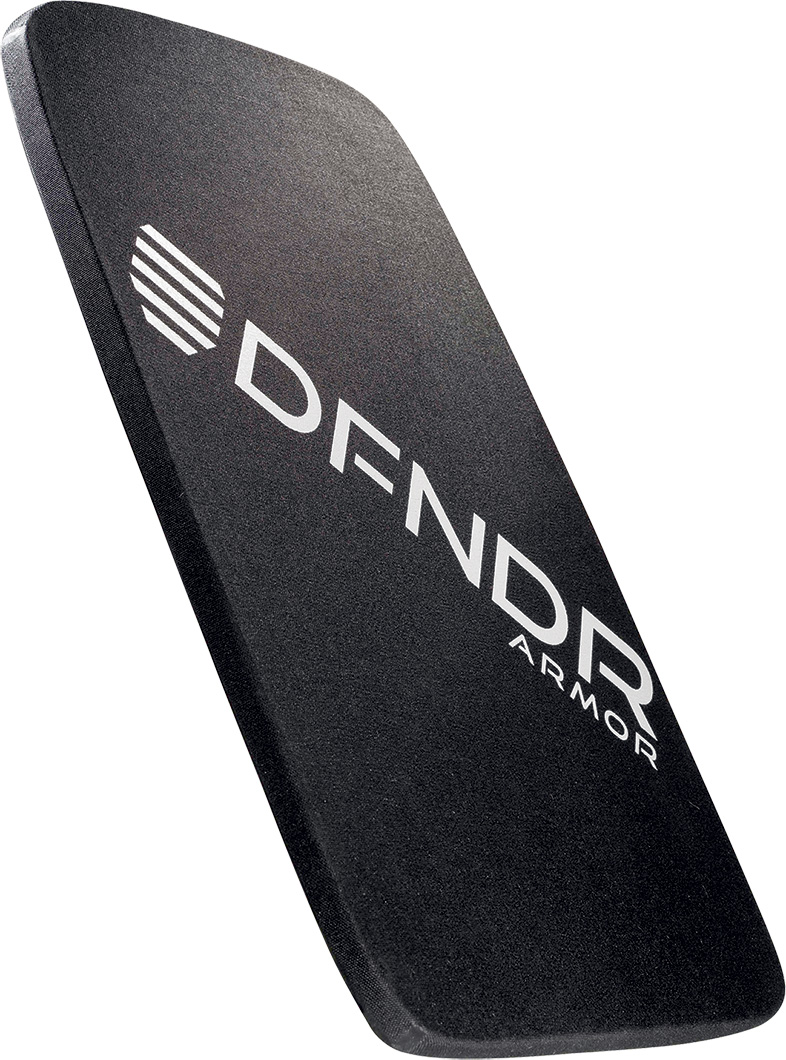 DFNDR Level IIIA Backpack Body Armor
DFNDR Level IIIA Backpack Body Armor
Packed and Ready
Although it only weighs a pound, the Level IIIA Backpack Body Armor by DFNDR, made with the highest grade of ballistic materials, earns top grades. Tested to meet NIJ 0101.06 Standard, the armor has proven to defeat multiple rounds of .357 SIG and .44 Mag SJHP. Plus, the hard-plate system is engineered with trauma-reduction technology to mitigate spall and deflect projectiles. The Backpack Body Armor fits most backpacks. MSRP $150–$215.
Get more information on this product ->
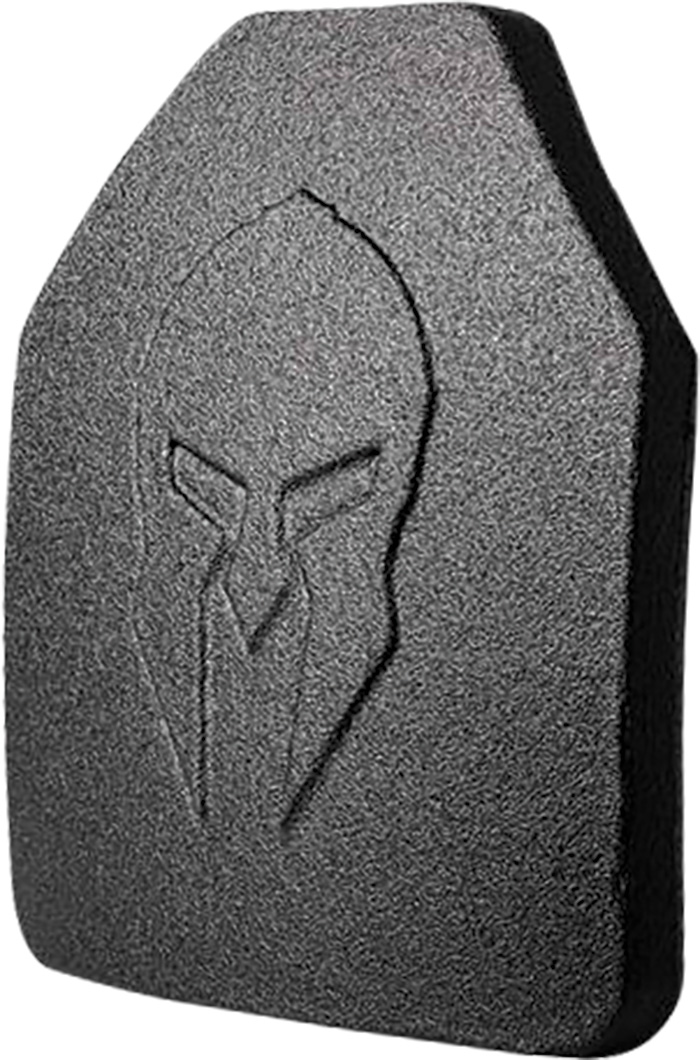 Spartan Armor Systems Elaphros Plate
Spartan Armor Systems Elaphros Plate
Lightweight Contender
In Greek, elaphros means light, quick and agile, all qualities considered essential to body armor worn in physically challenging situations. Tipping the scales at only 3.5 pounds — half the weight of traditional body armor — the Elaphros Plate by Spartan Armor Systems is produced from ultra-high molecular weight polyethylene hybrid fibers. It meets Level III standards, such as qualifying as stab-resistant and multi-shot rated. It measures 10 inches by 12 inches and has a half-inch profile and a multi-curve ergonomic design. MSRP $649.99.
Get more information on this product ->
Armor Express Traverse Overt Patrol Carrier
Polished, Put-Together Protection
 For a more uniformed appearance, try on the Traverse Overt Patrol Carrier by Armor Express. Available in black, LAPD navy, tactical gray and tan, the vest blends in with several uniform options. In fact, two dress pockets with faux button-down flaps and a pen slot, as well as the zipper concealed by faux buttons, class it up for a professional appearance. Protective plates placed into internal pockets or front and rear pockets enhance the heavy-duty outer shell. Utilitarian features include hidden identification and badge tab attachment points, adjustable shoulders with mic tabs and a camera mount. MSRP unavailable.
For a more uniformed appearance, try on the Traverse Overt Patrol Carrier by Armor Express. Available in black, LAPD navy, tactical gray and tan, the vest blends in with several uniform options. In fact, two dress pockets with faux button-down flaps and a pen slot, as well as the zipper concealed by faux buttons, class it up for a professional appearance. Protective plates placed into internal pockets or front and rear pockets enhance the heavy-duty outer shell. Utilitarian features include hidden identification and badge tab attachment points, adjustable shoulders with mic tabs and a camera mount. MSRP unavailable.
Get more information on this product ->
64th Biennial National FOP Conference
 The FOP celebrated its 64th Biennial National Conference in New Orleans from August 12 to 15, with 4,187 registered delegates and 534 registered alternates, plus guests, family members and supporters, making it one of the best-attended Conferences to date. Members enjoyed the many colorful floats of Mardi Gras, sampled a taste of Louisiana cuisine and Cajun music, and tested their football skills at the Manning Experience in the Superdome. A special thank-you to the Louisiana State Lodge for showing everyone such a good time!
The FOP celebrated its 64th Biennial National Conference in New Orleans from August 12 to 15, with 4,187 registered delegates and 534 registered alternates, plus guests, family members and supporters, making it one of the best-attended Conferences to date. Members enjoyed the many colorful floats of Mardi Gras, sampled a taste of Louisiana cuisine and Cajun music, and tested their football skills at the Manning Experience in the Superdome. A special thank-you to the Louisiana State Lodge for showing everyone such a good time!
Several guest speakers, including Louisiana Lieutenant Governor William Nungesser, New Orleans City Manager LaTonya Cantrell, U.S. Congressman from Louisiana Steve Scalise and U.S. Attorney General William Barr, addressed the delegation. The Expo was once again a huge success, with more than 130 vendors showcasing their products and services to the members. The President’s Award was presented to Larry James and Jim Pasco. The outgoing National Trustees received plaques for their service and dedication to the organization: Jim Crowley (29 years), Duane Phillips (23 years), Joe Perkins (19 years), Gary Wallace (14 years), Dave Mutchler (5 years), Tori Beauchemin (4 years), Joseph Greenya (3 years), Danny Overly (3 years), Steve Wolosin (3 years), Terry Fortenberry (2 years) and Jake Crowley (1 year). Cheryl Penoza received the Employee Award for her 20 years of service. Donations totaling $2,832 were taken up for Easterseals, and $11,154 was raised for Special Olympics. The Foundation held a silent auction and raffle, raising $9,622.
Two amendments were brought to the business floor, with both of them passing. Five resolutions were submitted; four passed and one was tabled. The delegates of the 64th Biennial National Conference elected the following members to the Executive Board for the next two years:
Vice President: Joe Gamaldi — Texas
Secretary: Jimmy Holderfield — Florida
Treasurer: Tom Penoza — Delaware
Second Vice President: Les Neri — Pennsylvania
Sergeant at Arms: Keith Turney — Illinois
National Trustees Chairman: Rob Pride — Colorado
Congratulations on your election, and thank you for being willing to serve the membership!
2019 FOP Member of the Year: Phil Wiggins
Phil Wiggins began his law enforcement career with the Durham Police Department in 1969 and joined Durham County FOP Lodge #2 in 1971. In 1974, he left the police department to pursue his degree in religious education. The Southern Baptist Association certified him as an ordained minister, and he went on to earn his Master of Religious Education degree. In 1983, Phil returned to the Durham Police Department as a public safety officer. He worked Uniform Patrol in District 1 and on a couple of street crimes units, being promoted to corporal. His next assignment was a Take Back the Streets initiative. A promotion to sergeant found him assigned to Uniform Patrol in District 1 once again, and then to the Organized Crimes Division. In 1999, Phil was promoted to the rank of captain and was the executive officer first for the administrative major, then for the chief of police. His last assignment was as commander of Uniform Patrol Support Services. Phil retired from the Durham Police Department in 2003 at the rank of captain.
Phil was appointed Grand Lodge chaplain in 2009 and has been reappointed each term since. Since his appointment as National chaplain, he has attended each Grand Lodge Peace Officers’ Memorial Service. Phil is also currently the elected chaplain for the North Carolina FOP State Lodge, having been re-elected continuously since 1994. In addition, he has been the elected chaplain for his local lodge since 1986, except for the years 1996–2000, when he was lodge president. He has participated in Durham County Lodge #2’s annual Peace Officers Memorial Services for the past 33 years. During his law enforcement career and service to the Durham Police Department, he also served as the department chaplain.
Phil Wiggins is continuously performing services for law enforcement officers, members of the FOP and citizens within the community. He is committed to enhancing the spiritual and emotional well-being of our members, officers and anyone he knows or meets. The FOP is proud to present him with the award for 2019 Member of the Year. Congratulations!
Next-Level Gear
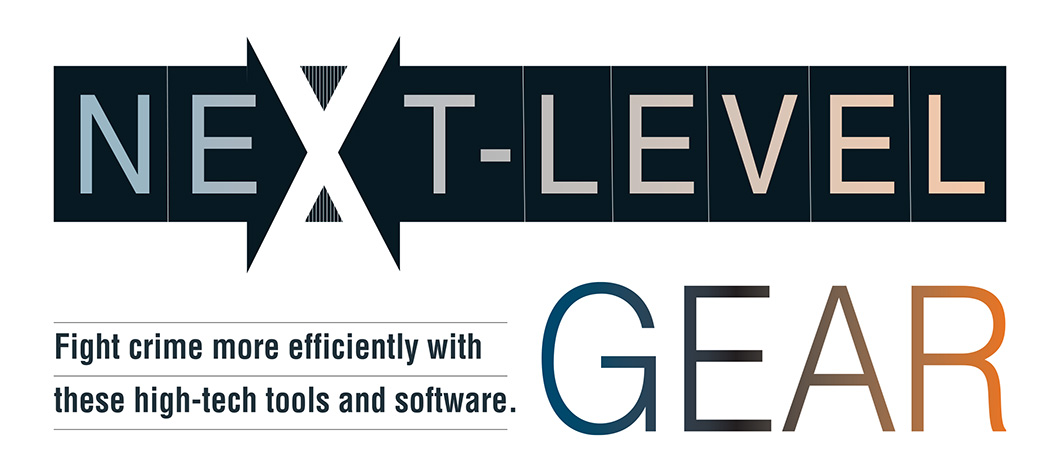 In recent years, departments and agencies nationwide have been increasingly leveraging hardware and software to better protect and serve their communities, and it’s easy to see why. Advances in mobile and stationary policing technologies have yielded sophisticated yet user-friendly tools that have helped officers do their jobs more effectively and efficiently. With bodycams that upload footage wirelessly, dictation programs that cut down report writing and apps that create incident maps on mobile devices, there are numerous devices and software to add to your department’s arsenal.
In recent years, departments and agencies nationwide have been increasingly leveraging hardware and software to better protect and serve their communities, and it’s easy to see why. Advances in mobile and stationary policing technologies have yielded sophisticated yet user-friendly tools that have helped officers do their jobs more effectively and efficiently. With bodycams that upload footage wirelessly, dictation programs that cut down report writing and apps that create incident maps on mobile devices, there are numerous devices and software to add to your department’s arsenal.
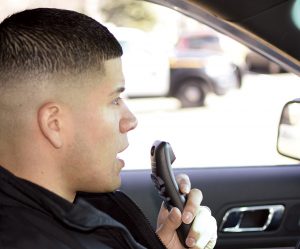 NUANCE DRAGON LAW ENFORCEMENT
NUANCE DRAGON LAW ENFORCEMENT
Voice Commands
Filling out paperwork can be tedious and time consuming. Although dictation programs have been around for a while, many have proved less than ideal for law enforcement use, often falling short of expectations. Recognizing this, engineers at Nuance designed the Dragon Law Enforcement speech recognition software to specifically meet officers’ needs. Tests indicate a 99% accuracy in real-time recognition with the handheld microphone. The Nuance Deep Learning feature compensates for accents and situational noise to increase accuracy. Also, users completed reports at least three times faster than typing. A built-in database of commonly used terms and phrases for police documentation also saves time as do programmable buttons. MSRP starts at $600.
Get more information on this product ->
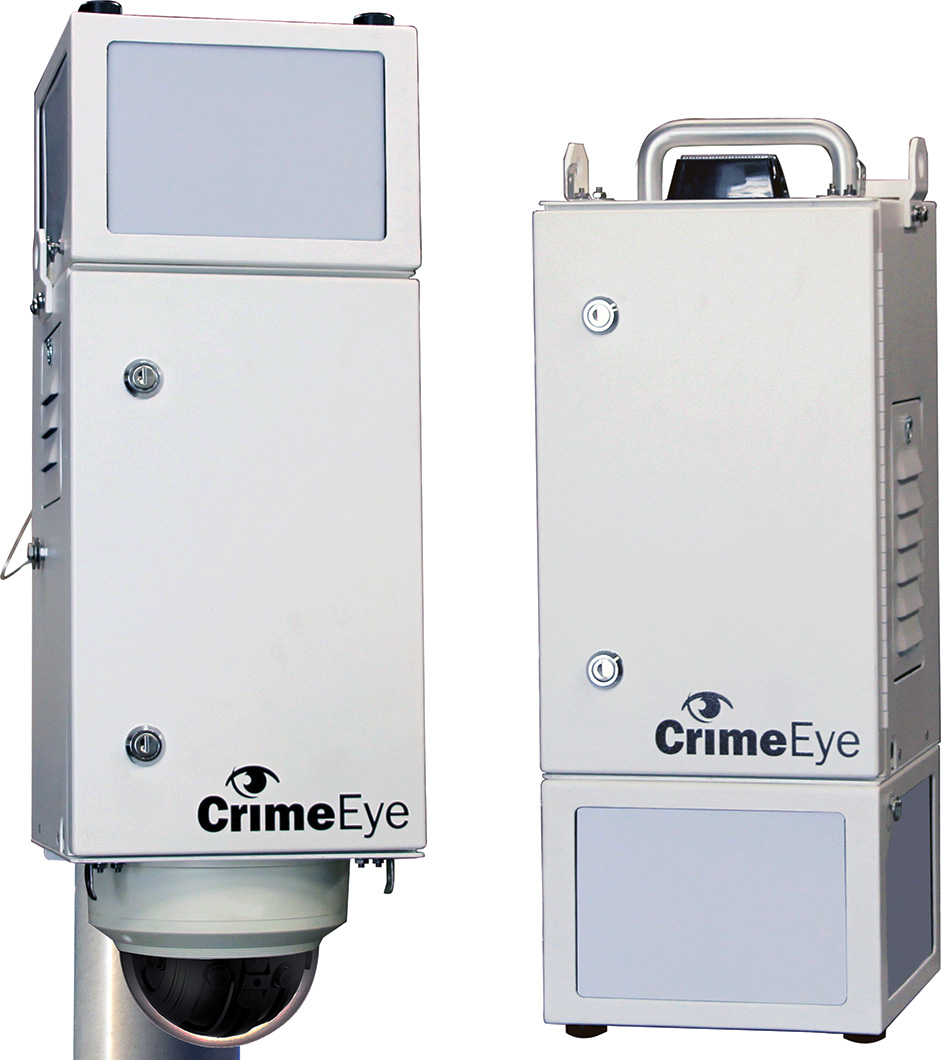 TOTAL RECALL CORP. CRIMEEYE RD-2
TOTAL RECALL CORP. CRIMEEYE RD-2
Eye on Crime
When you need an extra set of eyes discreetly watching the action, set up CrimeEye RD-2, a portable surveillance system by Total Recall Corp. Installation is easy, quick and essentially tool-free. The steady camera mount compensates for challenging environmental factors and the Axis low-light Mega Pixel HD camera produces superior images regardless of ambient light conditions. A UPS power supply with battery backup provides 1-2 hours runtime depending on location specifics. When the surveillance mission is completed, switch the system to transport mode and pack it up in its patented enclosure for secured storage. MSRP $16,448.
Get more information on this product ->
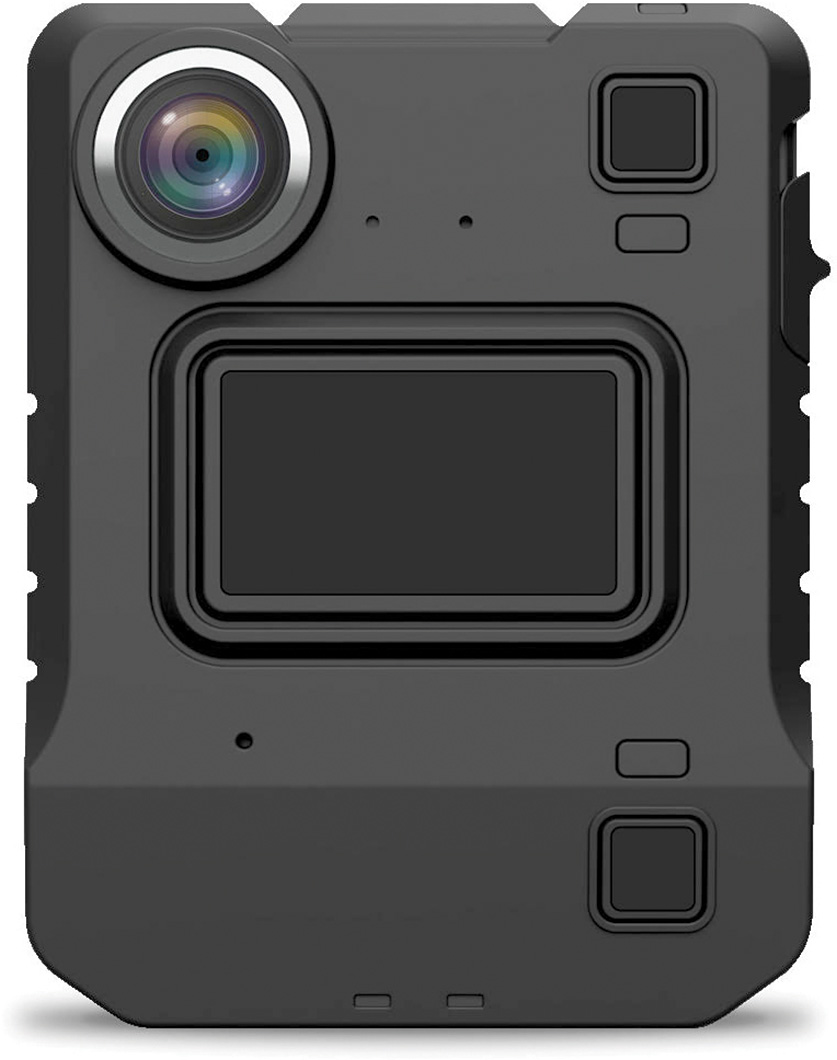 VIGILANT SOLUTIONS VIDEOBADGE VB-400
VIGILANT SOLUTIONS VIDEOBADGE VB-400
Compact Cam
Weighing in at a mere 160 grams and measuring 68mm x 89mm x 25mm, the VideoBadge VB-400 by Vigilant Solutions is small but mighty, with as much power and utility as its larger counterparts. A ruggedized exterior is ready to operate in any condition. The pre-record feature offers the opportunity to configure a pre-record period. A 140-degree diagonal field of view allows for an expanded perspective in full HD. On average, the device can capture up to 14 hours of recording, and the battery recharges in less than 8 hours. Images are transmitted via dual-band Wi-Fi, but only authorized individuals can access after downloading to a secure site. MSRP unavailable.
Get more information on this product ->
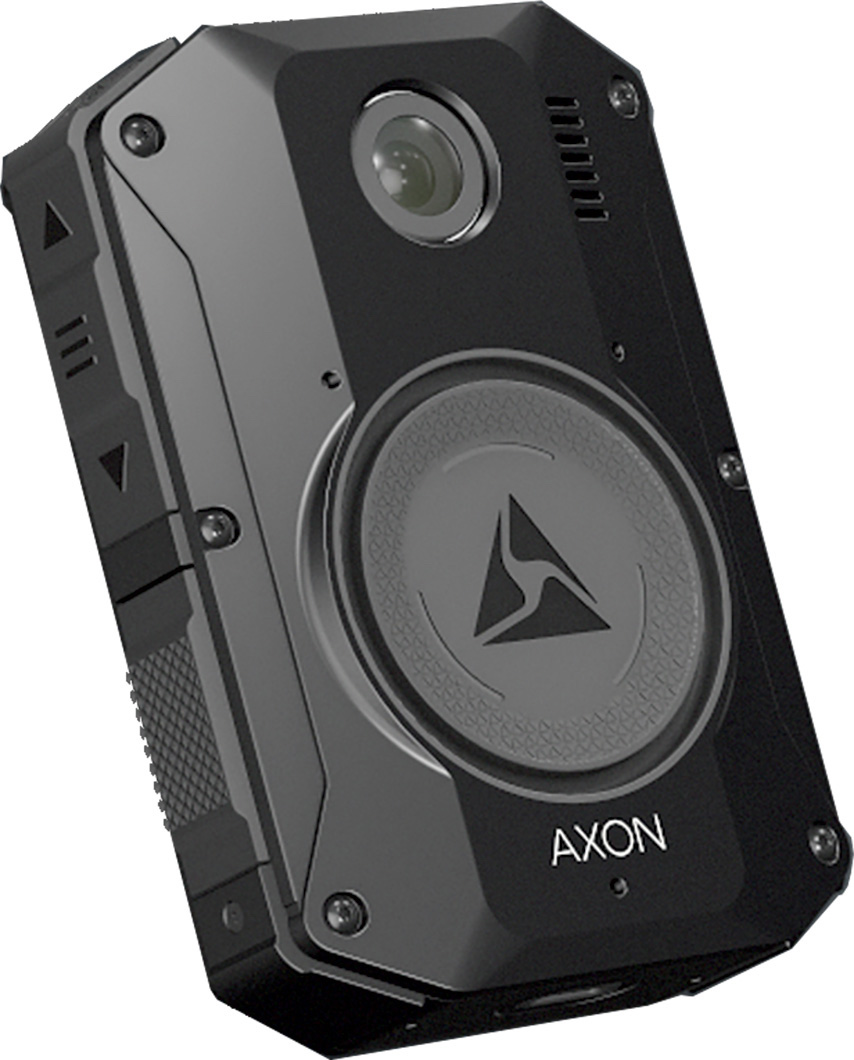 AXON BODY 3
AXON BODY 3
Video on Demand
Axon introduces the Axon Body 3, its first connected body camera device. In addition to memorializing a scene, this model reacts to action. For example, when detecting gunshots, it automatically alerts command staff and sends a live stream from the field for remote assessment and command oversight. Also, there’s no need to wait for the wearer to dock the camera before pulling up images. Previewing and uploading can be done wirelessly through connection with FirstNet, Built with AT&T, and Verizon. In addition to creating clear images in low light, the device also records crisp audio. Later this year, Axon will release new features, including transcription and license scanning directly into Axon Records, the company’s records management system. U.S. shipments are expected to begin this summer. MSRP starts at $699.
Get more information on this product ->
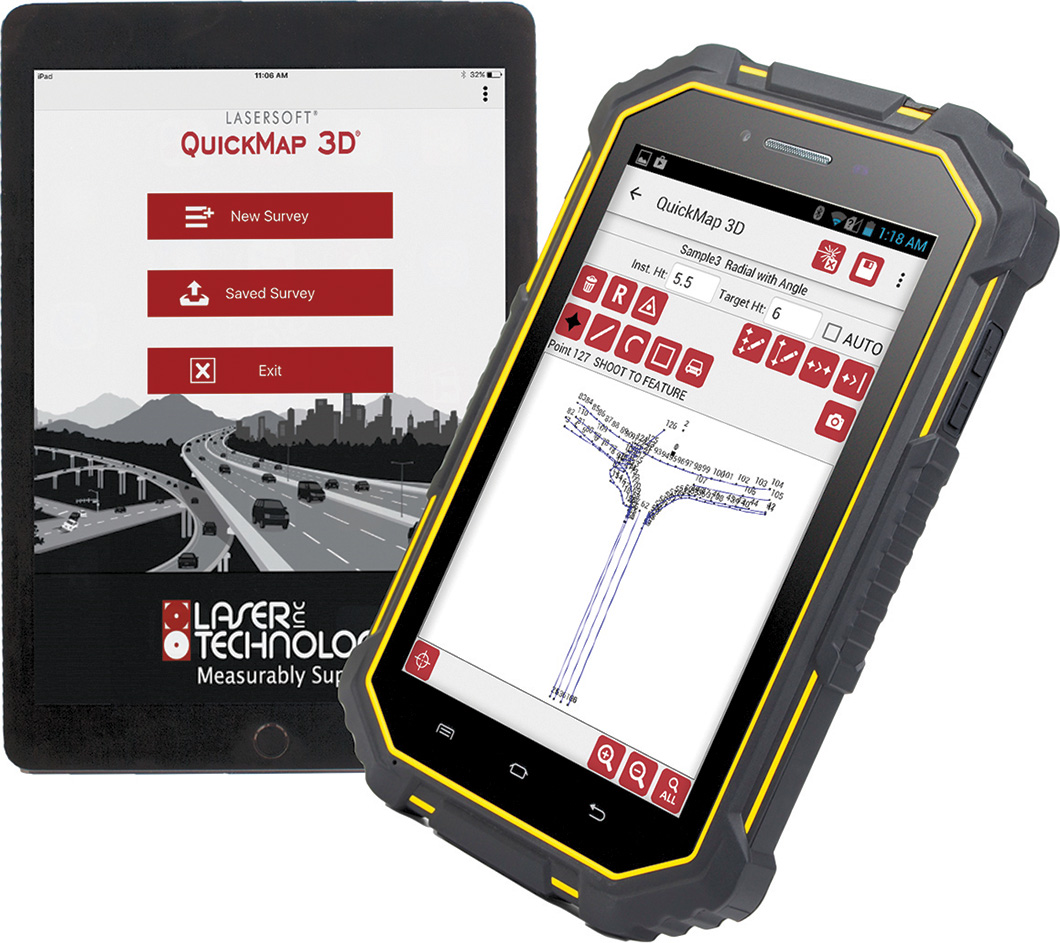 LASER TECHNOLOGY INC. QUICKMAP 3D
LASER TECHNOLOGY INC. QUICKMAP 3D
Precise Mapping
The QuickMap 3D incident mapping program from Laser Technology Inc. allows users to generate digital diagrams with pinpoint accuracy straight from an Android or Apple device. The program combines the best of the original QM3D with improved functionality, such as transferring field data via Wi-Fi and automatically pairing with the laser’s Bluetooth after initial hookup. Users can choose from three standard mapping strategies: baseline offset, range triangulation and radial with angles. Plus, straight lines can be converted into curves with the new advanced spline. The application also accommodates outlines of irregular shapes as well as matching photos to data sets. Yet another update is the customization option through individual or group point notation. MSRP $595 for software license.
Get more information on this product ->
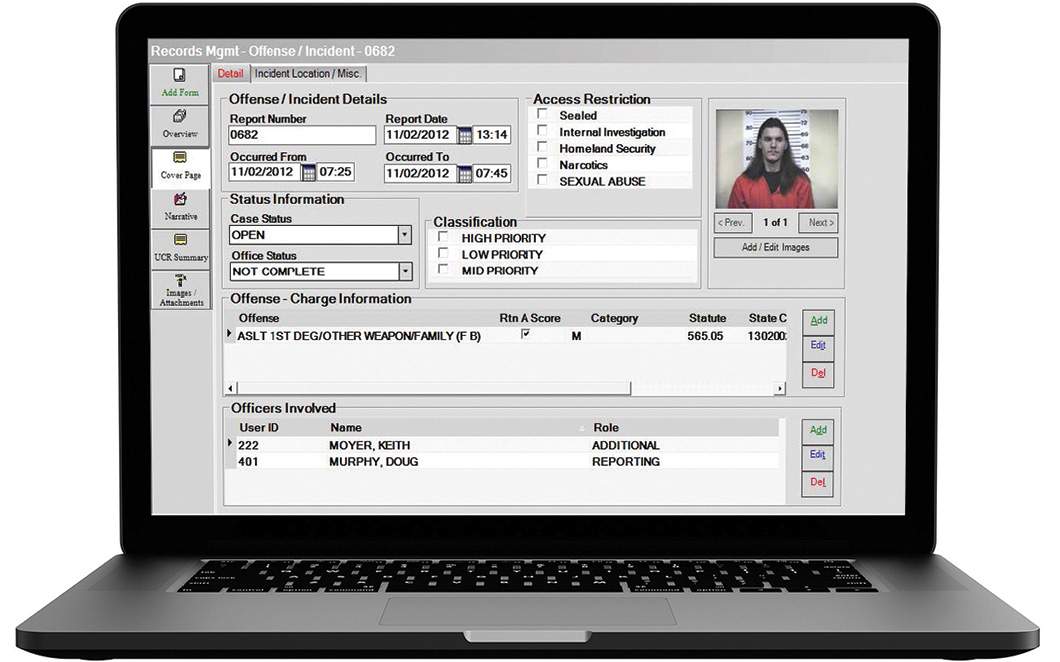 OMNIGO RECORDS MANAGEMENT
OMNIGO RECORDS MANAGEMENT
Streamline Data
The devil is in the details, and when it comes to today’s law enforcement, there are plenty of details to manage. Omnigo devised the Omnigo Records Management system to help departments collect, store, search, access and analyze vast amounts of data. To assist in the collection of information, common fields are automatically populated; however, custom fields can be added, too. Information is protected by a 256-bit Advanced Encryption Standard protocol. When it’s time to track trends for public reporting or to better allocate resources and plan budgets, the system is prepped with search-friendly functions. An added benefit is that Omnigo programmers have designed the software to help departments transition to the National Incident-Based Reporting System. MSRP unavailable.

Get more information on this product ->
See this story in the Spring 2019 FOP Journal issue.
Strategic Style
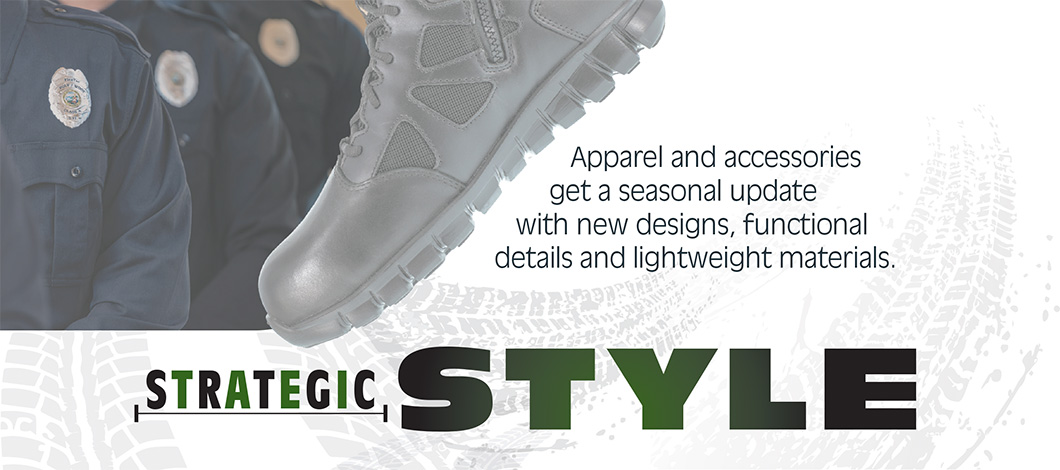
With the harsh cold of winter behind us, it’s time to enjoy the warmer, longer days of spring. That means trading in your heavier duty apparel for lightweight options that are breathable yet durable enough to withstand the season’s temperamental weather. This selection of products will provide you with the comfort and unbeatable protection you need to make the seamless transition into spring.
 FIRST TACTICAL DEFENDER SERIES UNIFORM
FIRST TACTICAL DEFENDER SERIES UNIFORM
Durable Defense
Police work is tough work, and it can be tough on your clothing. That’s why the designers at First Tactical prioritized durability for its Defender Series Uniform. For example, knees are reinforced with a double-layer kneepad pocket to extend the life of the pant. The same strategy has been applied to the shirt’s elbow area. Wearers will appreciate multiple layers of ventilation on top of the cotton/Cordura Nylon blend fabric for breathability. A total of 28 pant pockets offer more than enough storage opportunities while the Defender Shirt also features specialized pockets, including oversized ones on sleeves. MSRP: pant $149.99; shirt $89.99.
Get more information on this item ->
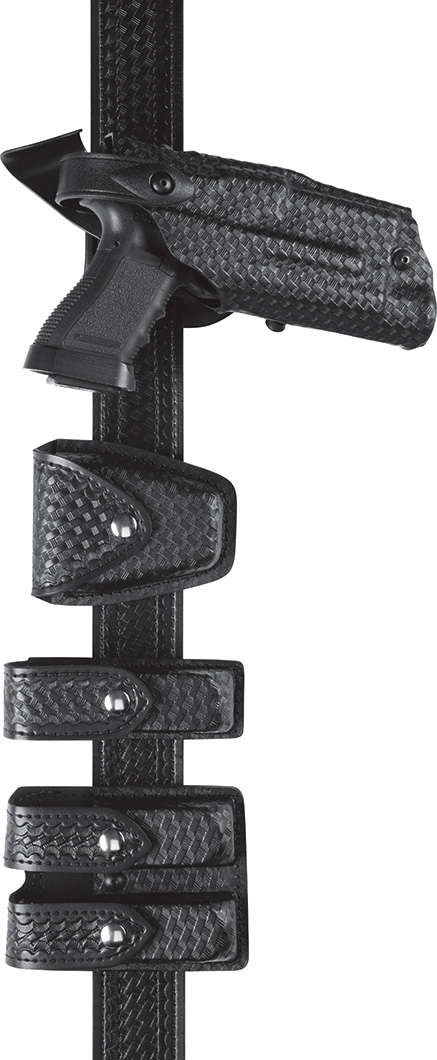 SAFARILAND STX DUTY RIG
SAFARILAND STX DUTY RIG
Safety Belt
With the amount of gear police officers have to don for duty, storage compartments that allow for easy, quick access are paramount. Safariland has produced the STX Duty Rig belt to enable individuals to pack on as many items as comfortable and effective. Officers can personalize their duty rigs by adding a variety of accessories, such as baton holder, double magazine pouch, flashlight holder and even a surgical glove holder. A SafariLaminate finish gives a professional presentation with a semi-gloss leather-like grain texture, but more importantly, offers durability and hassle-free maintenance. MSRP: belt $33–$118.50; accessories $4–$128.50.
Get more information on this item ->
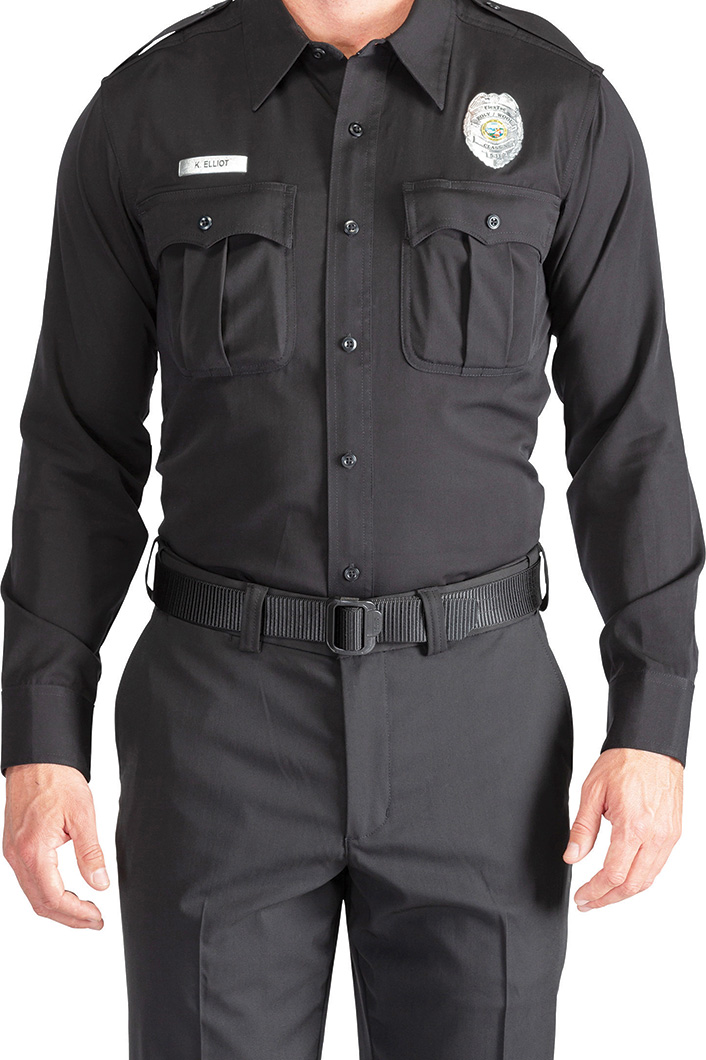 5.11 TACTICAL FLEX-TAC POLY/WOOL UNIFORMS
5.11 TACTICAL FLEX-TAC POLY/WOOL UNIFORMS
Material Witness
For occasions demanding a Class A uniform, you still can make comfort a priority. The Flex-Tac Poly/Wool Uniforms from 5.11 Tactical, in partnership with the Woolmark Company, work to keep officers warm and dry in rainy weather. Wool is renowned as a fabric that provides natural thermoregulation, but it also wicks moisture away, prevents abrasion and maintains its shape and color over time. Both shirts and pants feature a Teflon finish to fight against stains. Also, pants have permanent creases, two hip pockets and doubled-welted rear pockets. Uniforms include both men’s and women’s cuts, and come in black, midnight, silver tan and sheriff green. MSRP $99.99–$109.99.
Get more information on this item ->
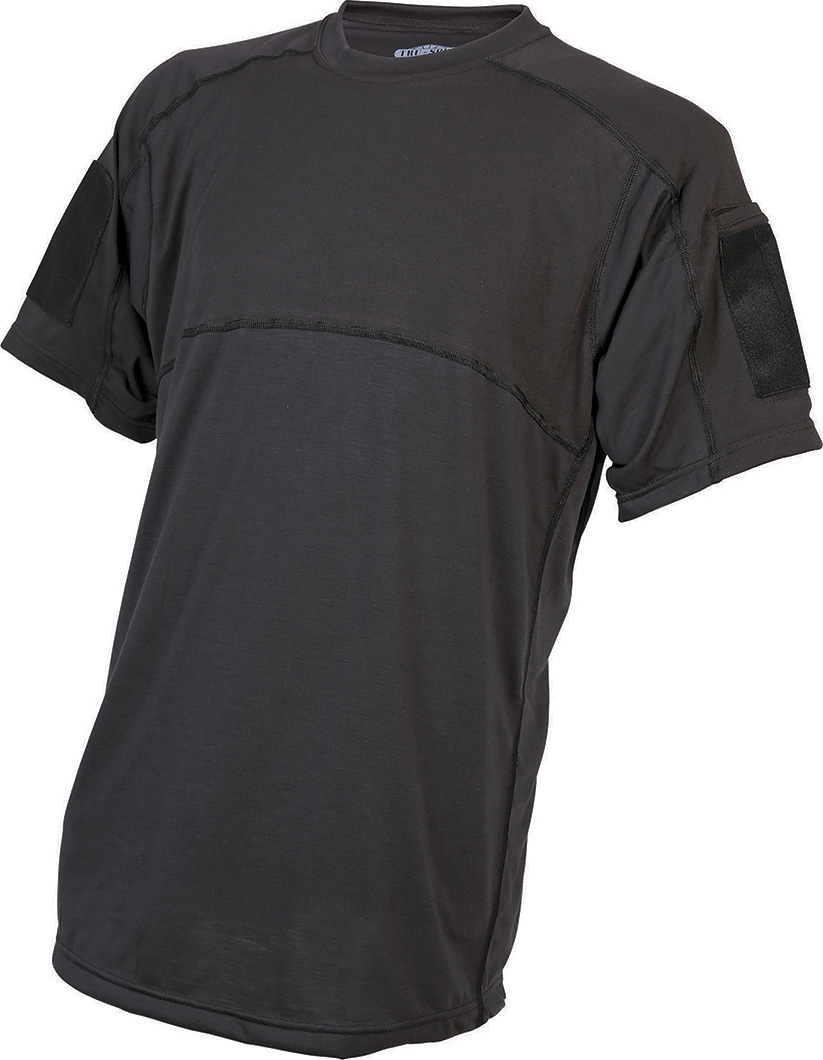 TRU-SPEC OPS TAC T-SHIRT
TRU-SPEC OPS TAC T-SHIRT
Temp Control
The best way to tackle the unpredictable transitional weather is by layering; you can remove layers when the day warms up and put layers back on when it feels cold or starts to rain. Start with a temperature-regulating shirt like the OPS Tac T-Shirt from Tru-Spec that can be worn as an under layer or on its own. Added to the company’s popular 24-7 Series, the Tac T-Shirt is made from drirelease fabric, which has proven to wick away moisture and dry quickly. The polyester-cotton blend also helps regulate body temperatures, up to seven degrees cooler on hot days. Tactically speaking, creators added a welted loop-pocket panel with hook-and-loop closure on the left sleeve. A three-loop panel on the right sleeve holds small items, such as pens. Sizes range from S to 4XL.MSRP $35.95.
Get more information on this item ->
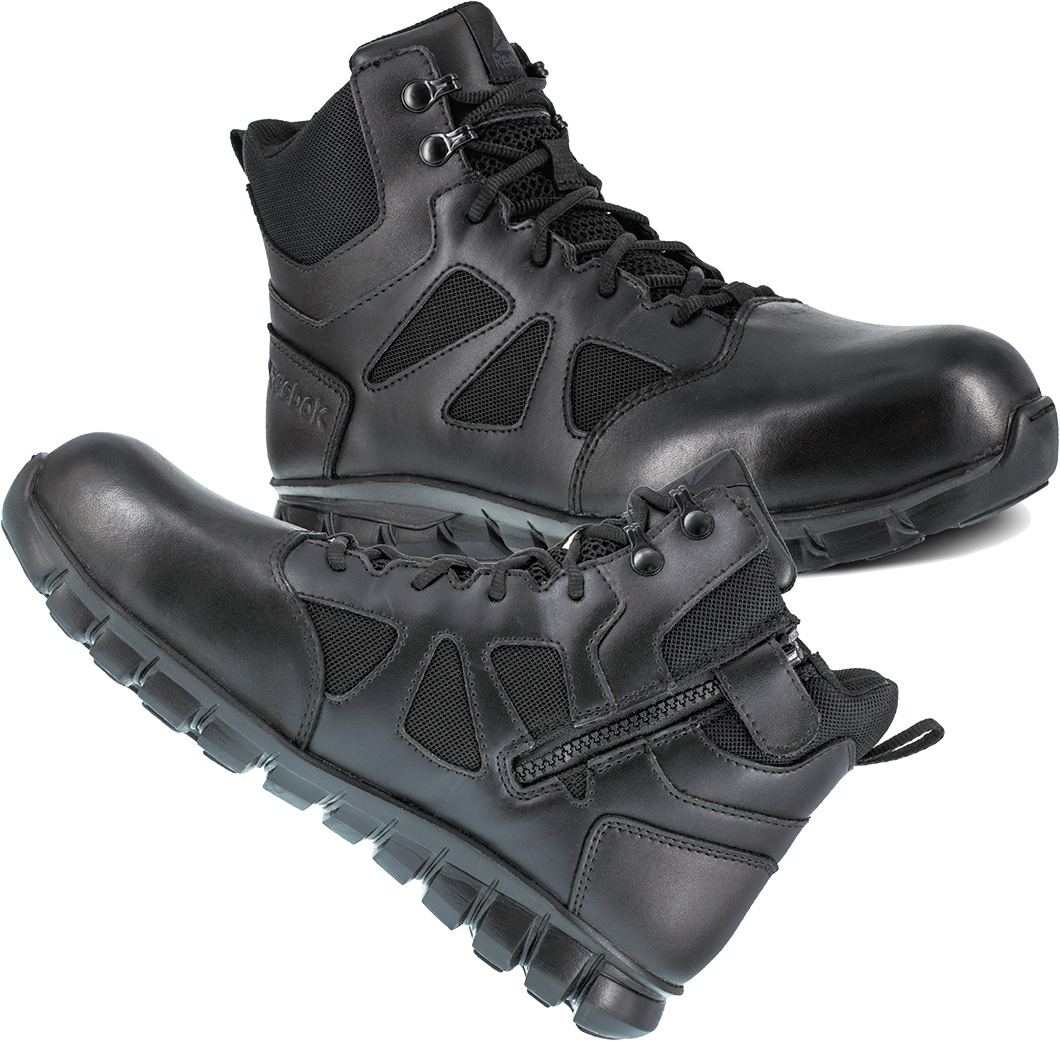 WARSON BRANDS REEBOK SUBLITE CUSHION TACTICAL RB8606
WARSON BRANDS REEBOK SUBLITE CUSHION TACTICAL RB8606
Foot Patrol
The latest Sublite Cushion Tactical boot from Warson Brands, the official Reebok licensee for duty and uniform footwear, features much-welcomed updates. The RB8606’s 6-inch design includes a composite safety toe added at the behest of law enforcement professionals. Another new feature is a side zipper for easy on and off. Back by popular demand is the Sublite foam midsole technology featuring deep-flex grooves that absorb shock while allowing for natural movement. Designers also brought back the MemoryTech massage removable cushion footbed that conforms to individual contours and provides slip resistance. MSRP $160.
Get more information on this item ->
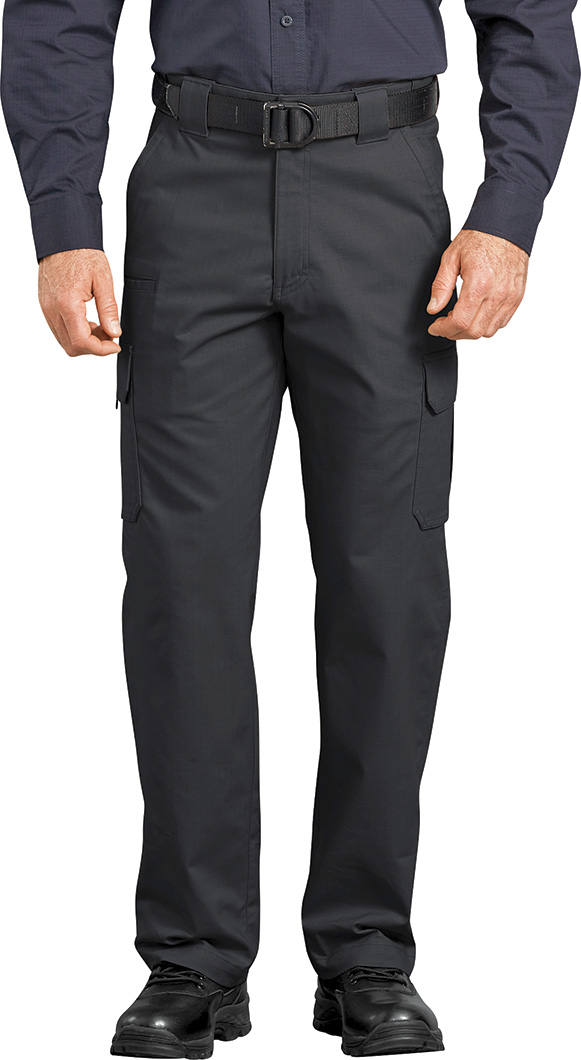 DICKIES RIPSTOP CARGO PANTS
DICKIES RIPSTOP CARGO PANTS
Pick Your Pocket
Ripstop Cargo Pants by Dickies offer a relaxed fit, but are totally equipped to tackle any tactical situation. Stash extra ammunition in the magazine pocket hidden within the large side cargo pockets. L-shaped front pockets hold small items officers need at the ready, including a spot to discreetly clip on a knife. There’s also a front leg pocket for phones. Constructed from a flexible performance-stretch material, these pants accommodate freedom of movement. Available in black, midnight blue and khaki. MSRP 42.99–$46.99.
Get more information on this item ->
See this story in the Spring 2019 FOP Journal issue.
Inside the Criminal Mind

According to the National Institute of Mental Health, nearly one in five U.S. adults lives with a mental illness. Based on the statistic, it’s no wonder that law enforcement professionals frequently encounter individuals struggling with a wide range of mental, behavioral or emotional disorders. Over the years, officers have increasingly become first responders for mental health crises — as many as 10% of police calls involve mental illness.
For example, in 2017, the Sacramento Police Department fielded more than 3,340 incidents related to mental health, according to statistics it provided to the Sacramento Bee. Officials from Johnson County, Kansas, told the Shawnee Mission Post they received a 448% increase in calls from law enforcement agencies for mental health assistance between 2016 and 2017. And Iowa State Police Department Chief Michael Newton confirmed to the Ames Tribune that the agency experienced an 18–20% increase in mental health–related calls between 2016 and 2017.
Many of these cases require law enforcement professionals to be as well-versed in psychology as they are in laws and statutes. The key is recognizing who deserves a mental health intervention versus who should be charged with an offense. It’s this unique intersection that’s the focus of forensic psychology. Traditionally, the specialty has been viewed from a clinical perspective, where practitioners evaluate individuals for competency hearings or child custody cases. However, law enforcement professionals also benefit from an in-depth knowledge of mental health disorders as well as other potential psychological impacts, such as the effects of interrogation and interview techniques. Many in law enforcement are turning to programs in forensic psychology to gain the valuable skills they need to meet the unique and ever-evolving demands of the job.

Officer Daniel Potts, EKU B.S. Forensic Psychology graduate
Degree: Bachelor of Science in Psychology, Forensic Psychology Concentration
Course sampling: Literacy in Psychology; Psychology of Personality; Adolescent and Adult Development
Key components: In addition to studying various fields within psychology, students choosing the forensic psychology concentration have the opportunity to participate in high-level discussions of course material with graduate students through a hybrid curriculum structure.
Faculty insight: “For every topic I teach, I have done as a case as a private practitioner. I often give students my case materials to review outside of class, and in class we talk about them. That makes for interesting conversations.” — Dustin B. Wygant, Ph.D., professor and Clinical Training program director
FOP member takeaway: “I knew I wanted to be a police officer, and I saw a growing trend with officers dealing with individuals with mental illness. I thought double-majoring in criminal justice and psychology would be very beneficial. I liked that the classes and assignments were able to integrate not only criminal justice to psychology, but psychology to criminal justice.” — Kentucky Lodge #75 member Officer Daniel Potts, Independence Police Department, 2013 graduate
 George Washington University
George Washington UniversityDegree: Master of Arts in Forensic Psychology
Course sampling: Psychology and the Legal System; Theories of Criminal Behavior; Investigative Psychology
Key components: Based in Washington, D.C., GWU faculty have developed an expansive network of contacts within numerous government agencies, including the U.S. Secret Service and the Bureau of Alcohol, Tobacco, Firearms and Explosives. Students can tap into these resources for the mandatory externship.
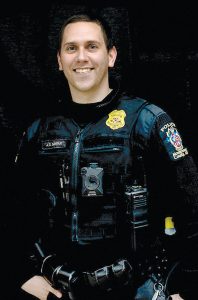
Officer Justin Saffar, GWU M.A. Forensic Psychology graduate
Faculty insight: “People working patrols who encounter mentally ill individuals don’t always understand what they’re looking at. Police officers who come back to school further their advantages, not because they’re getting a master’s degree, but because they’re getting skills they didn’t have.” — Richard A. Cooter, J.D., Psy.D., Forensic Psychology director
FOP member takeaway: “There are a lot of courses taught by experts in their fields. The interview and interrogation class was taught by an FBI agent of 30 years. They had a behavior profiling course taught by a U.S. Marshal who leads the psychology [department] for the entire service. It was nice to talk to them cop-to-cop.” — Maryland Lodge #35 member PO III Justin Saffar, Montgomery County Police Department, 2017 graduate

Detective Matt Jones, UND M.A. Forensic Psychology graduate
Degree: Master of Arts in Forensic Psychology
Course sampling: Behavior Pathology; Human Factors in Cyber Security; Foundations of Behavioral Data Analytics
Key components: The online program was ranked No. 1 among online master’s degree programs in forensic psychology by CollegeChoice.net last year. UND students have access to the same resources, lectures and curriculum as on-campus students. The degree culminates with a capstone project that includes a one-week on-campus experience, complete with face-to-face meetings with instructors
and classmates.
Faculty insight: “We have working professionals in the program, and it’s a unique learning experience for me to hear from them. At last year’s capstone, I learned about their jobs and now I can use that in more practical aspects for classes.”— André Kehn, Ph.D., associate professor
FOP member takeaway: “The main thing that appealed to me was the background of the instructors. I took the time to look at their CVs and the classes they were teaching.” — Arizona Lodge #11 member Detective Matt Jones, Tempe Police Department Homicide Unit, 2018 graduate
Degree: Master of Science in Forensic Psychology
Course sampling: Advanced Correctional Psychology; Quantitative Analysis; Seminar in Courts and Sentencing
Key components: The online advanced degree program has gained national recognition since its debut in 2017. Coursework explores various topics of mental health and human behavior and how they pertain to the criminal justice system, including courts and corrections.
Faculty insight: “We wanted the curriculum to give insight into all angles of the field. We have courses that have come from the law enforcement or criminology perspective, but with the psychological theory behind what goes on. It’s important to understand the needs of people with mental health [concerns] and how judges and juries weigh mental health concerns.” — Nick Schweitzer, Ph.D., associate professor and ASU Program on Law and Behavioral Science director and founding member
Degree: Master of Legal and Forensic Psychology
Course sampling: Forensic Assessment; Legal Reasoning; Violence and Psychopathology; Clinical Interviewing and Treatment
Key components: A collaboration between the Department of Psychological Science and the Department of Criminology, Law and Society, this graduate-level program examines the issues that cross from psychology to the legal realm and back, with a heavy emphasis on research and evidence-based practices.
Faculty insight: “I believe police officers are under enormous pressure of dealing with the public and community safety. They need more resources and support systems, and to have a better understanding of mental health to do the job. The goal is to bring the science to practice and have science drive solutions.” — Elizabeth Cauffman, Ph.D., professor and Center for Psychology and Law director
 Degree: Master of Science in Forensic Psychology
Degree: Master of Science in Forensic Psychology
Course sampling: Cognitive Psychology; Theories of Personality: Intersection of Law and Psychology
Key components: Students test their research and analysis assessment skills as well as develop in-depth understanding of key issues in the forensic concentration, such as eyewitness memory and recall, civil commitment and competency.
Faculty insight: “Law enforcement students are not only exposed to what types of roles forensic psychologists maintain in the justice system and the community, but also gain a more comprehensive understanding of the code of ethics that psychologists abide by.” — Vanessa Holtgrave, Psy.D., adjunct faculty
Click here “A Psychological Perspective” to read more FOP member insights on how forensic psychology degrees can benefit officers.
See this story in the Spring 2019 FOP Journal issue.
Restoring Public Trust
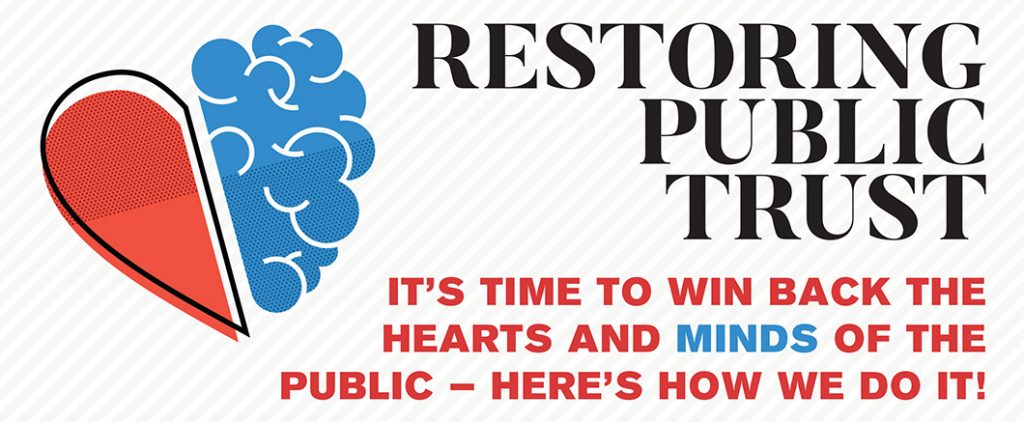
By Dr. Jeff Bernstein
I think most of you will agree that we are losing the public relations battle. You see it every day on every news channel; there are so many negative stories about the police. I’m tired of all the negative press. I’m sick and tired of all the hate directed toward the police. Something is seriously wrong in our society when the police are viewed as the bad guys, and the criminals as the poor victims. This thinking needs to change, and we really need to do something about it. I believe that we need a really good public/community relations campaign! An effective campaign will help improve our public image, especially if labor and management work closely together on it.
As a group, I believe we actually have the power to help stop all this hate. In order to start changing the hearts and minds of the public, a concerted national effort needs to be made by everyone in law enforcement. Years ago, I was in a meeting at the Miami Police Department headquarters with Chief John Timoney. He said, “The media loves a good story about a firefighter and a negative story about a cop doing something bad.” Wow, he was so right! Think about the stuff you see on the news every day. A group of firefighters rescuing baby ducks stuck in a storm drain or a firefighter putting an oxygen mask on a cat after a fire. I’m really tired of watching that stuff on TV, by the way. While watching one of these rescues on TV with my wife recently, she turned to me and said, “Isn’t that wonderful?” I said, “Yes, dear,” and I immediately had to leave the room to go throw up in the bathroom. I think we can all agree: firefighters get great media coverage, and cops don’t. My former chief, Lou Guasto, was fond of saying, “While what the fire departments do is so important, our free society could not exist without the daily efforts of our police officers.” So true. I’m hoping that we can make it our turn now to get some positive press. If we all work together on a public relations campaign, we can win back the hearts and minds of the public! We had it once, so I am quite sure we can have it again.
Here are five things that every officer and supervisor can do:
1 We have to make sure that our officers stop doing stupid s— that ends up on TV. We have all seen a police pursuit on TV. A helicopter flies overhead, the pursuit ends in a crash, the bad guys bail out and then are caught, there’s no resistance, until, wait for it, wait for it, thump, an officer uses a bit more force than necessary. Stop the officers you work with from doing this. Save them from being arrested. Save their jobs and pensions. Stop the act, and these images won’t have a chance to appear on TV. It really hurts us when they do. We are the good guys, and we need to be seen that way.
2 Don’t get baited by people who dislike the police. Understand what these people are trying to do. The people who record officers on video are trying to get them to say or do something inappropriate. They are often hoping for a negative reaction from you. Remain calm and deal with the situation professionally. Think: If you respond in a professional manner, will that make for good video? Consider these two options.
Option A: “Sir, you are interfering with a lawful investigation. Please step back now and stop obstructing. If you continue, I am going to place you under arrest for obstructing. Please move over to the corner location now.” Now, contrast that with Option B: “Hey, asshole, I’m not going to tell you again. This is police business, get out of my face, and get the f— out of here now, or I will knock the dog s— out of you!”
I believe Option A is the better choice. And for those of you who are not sure which option to choose, just pick Option A, please.
3 Give good customer service. Most people who call the police are honest, hardworking citizens who deserve good customer service. Most have a legitimate problem or question and need your help. When they receive good treatment from the police, they tell people. When they receive bad treatment from the police, they tell 10 times as many people. That’s just how it is. Think about how you would want an officer to treat your family. If it were your mom who just got knocked down by a purse snatcher, how would you want the responding officer to treat her? You certainly would want someone who is caring, concerned, compassionate and comforting. For the most part, it’s just following the Golden Rule: treat people the way you would want to be treated. Always remember, giving good customer service makes for good video.
4 Use departmental social media effectively. Most of you who are actively employed are from Generation X and Y (millennials) and already know how to use social media. Just to be clear, I’m not talking about swiping on Tinder or liking pictures on Instagram. We need to keep the public informed about emergency situations, such as missing kids and bad guys on the loose. Facebook, Twitter, Instagram, whatever! We need to use it, and use it effectively. Get the good news out as often as possible. Do what you can to improve the image and reputation of your department. Feed the public information officer good stuff.
5 Get those really good body camera videos to your public information officer. This is so important, and it really is the key to swinging the pendulum back toward respect for the police. Recently, Florida Sheriff’s Deputy Jeremie Nix did a great job saving the life of an infant. He was driving home and was flagged down in his patrol car by Nechole Cromwell, who told him that her 4-month-old son, Kingston, was completely unresponsive. After trying to revive the baby and not seeing any results, Deputy Nix decided to drive the baby directly to the hospital. He saved baby Kingston, and 100 million people saw him do it! He was hailed a hero and hugged by mom Nechole. Deputy Nix said, “God put me in the right place at the right time.” Wow, it doesn’t get any better than that!
These are just five things that all officers can do to help end this hate toward law enforcement. We certainly can do more. For example, if you see a firefighter put an oxygen mask on a cat and the TV cameras are there, just walk over and insert yourself into the frame. Then, immediately start CPR on the cat, and make sure your departmental patch is clearly visible to the camera! A similar technique will also work with the baby ducks stuck in the storm drain. While the firefighters are rescuing the baby ducks, you should personally bring the mother duck over so that she can reunite with her baby ducklings. Again, just make sure your police departmental patch is clearly visible to the cameras. The baby ducks will instinctively follow you and the mother duck, which is what we want. Also, don’t be afraid to just push the firefighters out of the way. We need to let the public see us continually doing good things, in person and on video! It works for the firefighters. Heck, even letter carriers had a kick-ass public relations video after 9/11. Yes, letter carriers. The U.S. Postal Service made one of the best public relations videos that I have ever seen. That video should have been about cops and firefighters, not the people who deliver my mail. (Watch it on Youtube here: www.bit.ly/2BlAUFk.) We desperately need to improve our public image. If we try hard enough, we absolutely and positively can change the hearts and minds of the public. It’s up to you to help make that happen!
Note: In the interest of full disclosure, no firefighters’ or postal workers’ egos were harmed during the writing of this article.
Dr. Jeff Bernstein is a police psychologist who holds a doctorate in clinical psychology. He worked for the Miami Beach Police Department for 15 years as an officer, detective and supervisor. He is a Medal of Valor recipient and a member of both the FOP and the PBA’s Retired Police Officers Council. Additionally, he is a co-author of the best-selling book, Supervision of Police Personnel. Dr. Bernstein serves as a promotional exam resource expert for FOP lodges and PBA locals throughout the country.
See this story in the Spring 2019 FOP Journal issue.
A Psychological Perspective
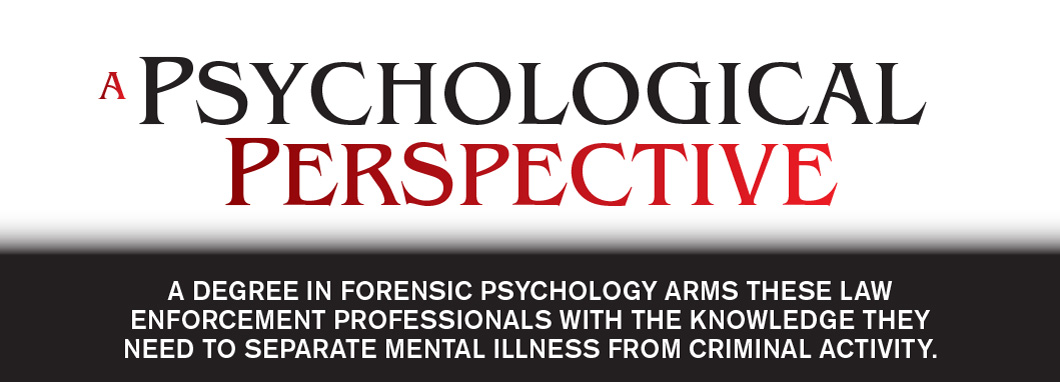 From individual agency reporting to large studies conducted by forensic psychology researchers, evidence indicates law enforcement professionals (LEPs) oftentimes are the first responders to mental health incidents, whether identified as an emotional crisis or simply as an element of a possible criminal situation. We asked the following FOP members why having an understanding of the psychological aspects of human nature, especially in stressful circumstances, is as important to success on the job as comprehension of statutes and well-practiced tactical maneuvers.
From individual agency reporting to large studies conducted by forensic psychology researchers, evidence indicates law enforcement professionals (LEPs) oftentimes are the first responders to mental health incidents, whether identified as an emotional crisis or simply as an element of a possible criminal situation. We asked the following FOP members why having an understanding of the psychological aspects of human nature, especially in stressful circumstances, is as important to success on the job as comprehension of statutes and well-practiced tactical maneuvers.

 MATT JONES graduated with a master of arts in forensic psychology from the University of North Dakota in 2018. He is a detective in the Tempe (Arizona) Police Department’s Homicide Unit and a member of FOP Tempe Lodge #11.
MATT JONES graduated with a master of arts in forensic psychology from the University of North Dakota in 2018. He is a detective in the Tempe (Arizona) Police Department’s Homicide Unit and a member of FOP Tempe Lodge #11.
 DANNY POTTS graduated with dual majors in criminal justice and psychology from Eastern Kentucky University in 2013. He is a police officer with the Independence (Kentucky) Police Department and a member of the Kentucky State FOP Independence Lodge #75.
DANNY POTTS graduated with dual majors in criminal justice and psychology from Eastern Kentucky University in 2013. He is a police officer with the Independence (Kentucky) Police Department and a member of the Kentucky State FOP Independence Lodge #75.
 JUSTIN SAFFAR graduated with a master of arts in forensic psychology from George Washington University in 2017. He is a police officer with the Montgomery County (Maryland) Police Department and a member of the FOP Lodge #35.
JUSTIN SAFFAR graduated with a master of arts in forensic psychology from George Washington University in 2017. He is a police officer with the Montgomery County (Maryland) Police Department and a member of the FOP Lodge #35.
POTTS: We need more officers with psychology backgrounds. It can assist them to properly inform family members and medical professionals when bringing in someone with a mental illness or who may possibly be abusing substances that are contrary to their prescriptions.
SAFFAR: When you’re talking to someone who has been schizophrenic their whole life, you know what medications they’re talking about and the symptoms. You can connect with them better. It comes down to understanding people and where they’re coming from and seeing them as unique individuals.
POTTS: Forensic psychology was definitely my favorite. It delved deep into criminal justice and psychology. It talked about mental illness in criminal justice [and how it] plays a part in the court system.
SAFFAR: One of the introductory courses was psychology and the law. Before, I didn’t really understand why a case couldn’t go forward because of [the person’s] mental health status. Now I understand where it comes from and why lawyers are doing what they’re doing.
JONES: Diversity and the law was a class I didn’t think I would enjoy, but it turned out to be my favorite. It talked about adverse populations for discrimination I never thought of or considered, such as the lesbian and transgender community, and how the population is discriminated against in psychology [and criminal justice].
SAFFAR: Absolutely. It’s helped throughout my career. I was interested in the crisis negotiation team, and forensic psychology is much of what they do. When we go to do a mental health evaluation and decide when someone should have the hospital involved, I volunteer to write the petitions because I enjoy that.
JONES: It has impacted my job a lot in terms of dealing with eyewitness identification procedures and how I listen to statements of individuals involved. I better understand how memory works. Just because a person can’t remember all the details, it doesn’t mean they’re lying.
JONES: The more I network with researchers, [the more] I’m drawn into how much I enjoy research. I’m considering going for my Ph.D.
SAFFAR: I may consider a Ph.D. A lot of supervisors and upper management in my department have degrees in higher education, and it’s a competitive process. Having my masters will help if I lean toward management. I’m also interested in becoming a homicide detective, which involves psychology.
POTTS: I will probably get an advanced degree. I’m lucky that my department has a continuing education program. Last year, they sent me to a crisis intervention training conference to learn more about how to talk to and document people in crisis. They’re sending me to a class this year because I expressed an interest. That not only benefits me, but it benefits the department, too.
JONES: Make sure the curriculum has classes in the area you want to study. Also, look at the background of instructors. Are they experienced? Have they done research in the classes they’re teaching?
POTTS: Look for the freedom to integrate criminal justice ideas or situations into psychology classes, papers and essays. I was given a lot of freedom because my professors understood I wanted to be a police officer.
SAFFAR: The most helpful thing for me was speaking with the department chair. I explained my career goals and ambitions, and I knew within an hour that it was the right program for me.
For more about these programs, read “Inside the Criminal Mind.”
See this story in the Spring 2019 FOP Journal issue.
Take Aim

If you’re in the market for a new gun, pay attention to the details. The latest generation of firearms provides greater customization. Advancements in materials protect against corrosion and lessen the load on shooters. Even gun accessory makers have updated designs of holsters, slings and other accompaniments to make carrying a firearm more comfortable and less visible. What do you value most in a new duty weapon or personal firearm? Precision? Durability? Size and ease of use? Check out some of the finer details on these new offerings that enhance accuracy and safety.
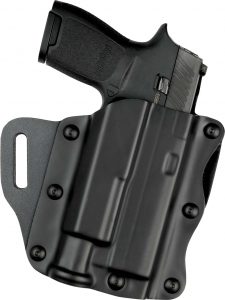 Safariland Model 557 Open-Top Concealment Holster
Safariland Model 557 Open-Top Concealment Holster
Safely Secured
Many recent handgun models allow for lighting devices, including lasers, to be attached, but most previous holster designs can’t accommodate the combination. The Safariland Model 557 Open-Top Concealment Holster, however, makes room for both pieces of gear. Released this year, the holster safely secures a firearm with or without a light attachment. An ejection point detent protects the weapon with a gripping mechanism but allows for quick release. Its low profile cleverly keeps the gun concealed, and the wide design distributes the weight more evenly to provide a comfortable fit. The holster’s utilitarian design houses a number of gun makes. MSRP $50.
Get more information on this product ->
 Blackhawk Multipoint Sling
Blackhawk Multipoint Sling
Weight Distribution
The weight of a concealed weapon during a long shift can become physically tiring and muscle straining. The Multipoint Sling from Blackhawk prioritizes comfort as well as safety. The nylon weave material is strong enough to withstand hours of wear and tear. A wide webbing helps distribute the weight to prevent strain while also allowing freedom of movement. A patented rapid-adjust slider enables quick changes to sling length as needed. The sling also easily converts into multiple configurations. Available in black and coyote tan. MSRP $39.95–$79.95.
Get more information on this product ->
Mossberg 590M Mag-Fed
Pumped for Action

Earlier this year, Mossberg introduced the 590M Mag-Fed 12-gauge shotgun, building on the company’s tradition of creating top-quality pump-action platforms. This model is characterized by nonbinding twin action bars, a steel-to-steel lockup, dual extractors and a heavy-walled barrel. Total round capacity maxes out at 10+1. Unique engineering created integral stabilizing ribs to directly engage the magazine via notches that ensure a positive lockup. The double-stack magazine’s patented design consists of hardened steel feed lips, over-molded steel shell ramps and an anti-cant rounded follower. Magazine capacities are available in 5, 10, 15 and 20 rounds. MSRP $721.
Get more information on this product ->
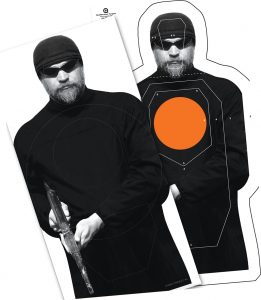 Qualification Targets Inc. USMC-THREAT
Qualification Targets Inc. USMC-THREAT
Target in Sight
Qualification Targets Inc. intended the USMC-THREAT-PL to aid soldiers in firearms training, but law enforcement can easily adopt it, too. Measuring 20 inches by 40 inches, the target is printed directly onto corrugated plastic, protecting it from weather conditions. The USMC-THREAT-HALO is a paper target featuring specified chest zones, an outer halo zone and head zone. MSRP $67.50 for bundle of 10 PL; $35 for bundle of 100 HALO.
Get more information on this product ->
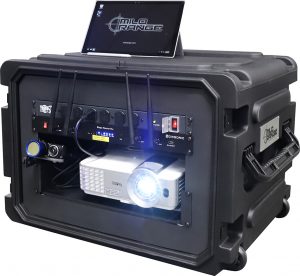 MILO Range M-SATS
MILO Range M-SATS
Situational Awareness
Firing-range training is great for developing accuracy, but those controlled circumstances don’t translate to the real world, where various conditions can affect accuracy. That’s why MILO Range programmed the M-SATS (Mobile-Situational Awareness Training System) to present more than 800 video scenarios and 60-plus skill builders to test a shooter’s situational assessments, reactions and accuracy. The program automatically memorializes training sessions to generate reports. The hardware system contains the MILO Range CPU with a Windows operating system, MILO laser and flashlight detection cameras, stereo speaker system and a transport case. Its portability allows training teams to set up the system in various environments, which can make the experience more situationally realistic. MSRP $24,995.

Get more information on this product ->
Savage 110 Tactical
Shooter Specific
 Designers of the 110 Tactical rifle by Savage believe a touch of customization gives users a notable advantage in accuracy. The AccuFit system enables users to customize the length of the pull to achieve consistency shot after shot. They can fine-tune the AccuTrigger system to deliver as light a pull as possible or as preferred. The AccuStock feature adds accuracy by securing the action up and down the full length of the stock. Finally, a soft grip fore-end paired with a soft pistol grip ensures comfortable handling. Available in right- and left-hand models. MSRP $769–$784.
Designers of the 110 Tactical rifle by Savage believe a touch of customization gives users a notable advantage in accuracy. The AccuFit system enables users to customize the length of the pull to achieve consistency shot after shot. They can fine-tune the AccuTrigger system to deliver as light a pull as possible or as preferred. The AccuStock feature adds accuracy by securing the action up and down the full length of the stock. Finally, a soft grip fore-end paired with a soft pistol grip ensures comfortable handling. Available in right- and left-hand models. MSRP $769–$784.

Get more information on this product ->
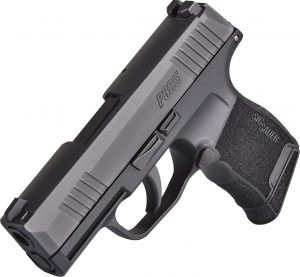 Sig Sauer P365 Nitron
Sig Sauer P365 Nitron
Micro Managed
Sig Sauer engineers don’t believe compact pistols need to sacrifice firing power. The P365 Nitron packs a lot of bang into a small design. The 9mm handgun measures less than 6 inches in length, is slightly more than 4 inches in height and weighs approximately 18 ounces. The slide is produced from stainless steel and finished with Nitron to prevent corrosion. Designers incorporated the standard SIGLITE Night Sights, and the trigger is striker fired. MSRP $599.99.

Get more information on this product ->
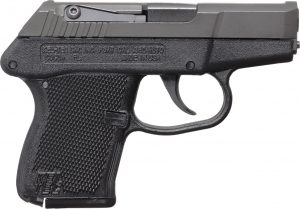 Kel-Tec P-3AT
Kel-Tec P-3AT
A Firing Force
Don’t let the light weight (8.3 ounces) of the Kel-Tec P-3AT handgun fool you into thinking it’s a lightweight gun. The semiautomatic, locked breach pistol boasts incredible power with a double-action firing mechanism. Also, the locking dynamics reproduce a recoil similar to that of larger guns. Magazine holds a capacity of six. MSRP $338.18.

Get more information on this product ->
 Smith & Wesson M&P M2.0 Compact
Smith & Wesson M&P M2.0 Compact
Compact Power
Although slight in size, the M&P M2.0 Compact pistol by Smith & Wesson is full of precision engineering to enhance shooters’ accuracy. For example, the lower barrel bore axis helps reduce muzzle rise and promotes quicker aim recovery. An 18-degree grip angle encourages a more natural point of aim. What’s more, palm swell grip inserts come in four interchangeable sizes (S, M, ML, L) to provide optimal fit. An extended, rigid, embedded stainless steel chassis helps to reduce flex and torque during firing. Lastly, the handgun features a tactile and audible trigger reset. MSRP $569.

Get more information on this product ->
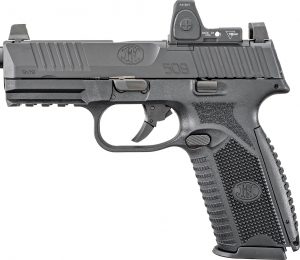 FN America FN 509 Tactical MRD
FN America FN 509 Tactical MRD
In Sight
This summer, FN America introduced its new FN 509 Tactical MRD handgun. The 9mm model’s barrel is constructed of cold hammer-forged stainless steel. An enhanced grip texture and interchangeable back straps provide a confident grasp, complemented by an ambidextrous slide stop lever and magazine release. Also featured is the patent-pending FN Optics Mounting System along with a fixed three-dot night sight. FN 509 Tactical MRD is compatible with several brands of optics. MSRP $1,049.

Get more information on this product ->
See this story in the Winter 2018 FOP Journal issue.
Tactical Trends

Being selected to serve on a tactical team often means you’ve acquired an advanced skill set to carry out high-risk duties, so you expect your clothing to meet that tough challenge, too. When choosing tactical apparel, there are a lot of factors to consider, with the first always being comfort. Tight, binding fabric for shirts, pants or jackets could inhibit movement, which is absolutely unacceptable. Another key characteristic is whether the item has been winterized. Does the material provide protection against the elements, be it wind, rain, snow or frigid temperatures? A third factor is functionality, from extra pockets to store gear or conceal a weapon, to boots designed to prevent foot fatigue, to vests for added layers. Finally, don’t forget about style — there’s no reason why tactical apparel can’t look good, too. The items highlighted here are designed to meet these and many other criteria, helping law enforcement professionals dress for success.
Galati Gear Deluxe Tactical Vest
Invested in Safety
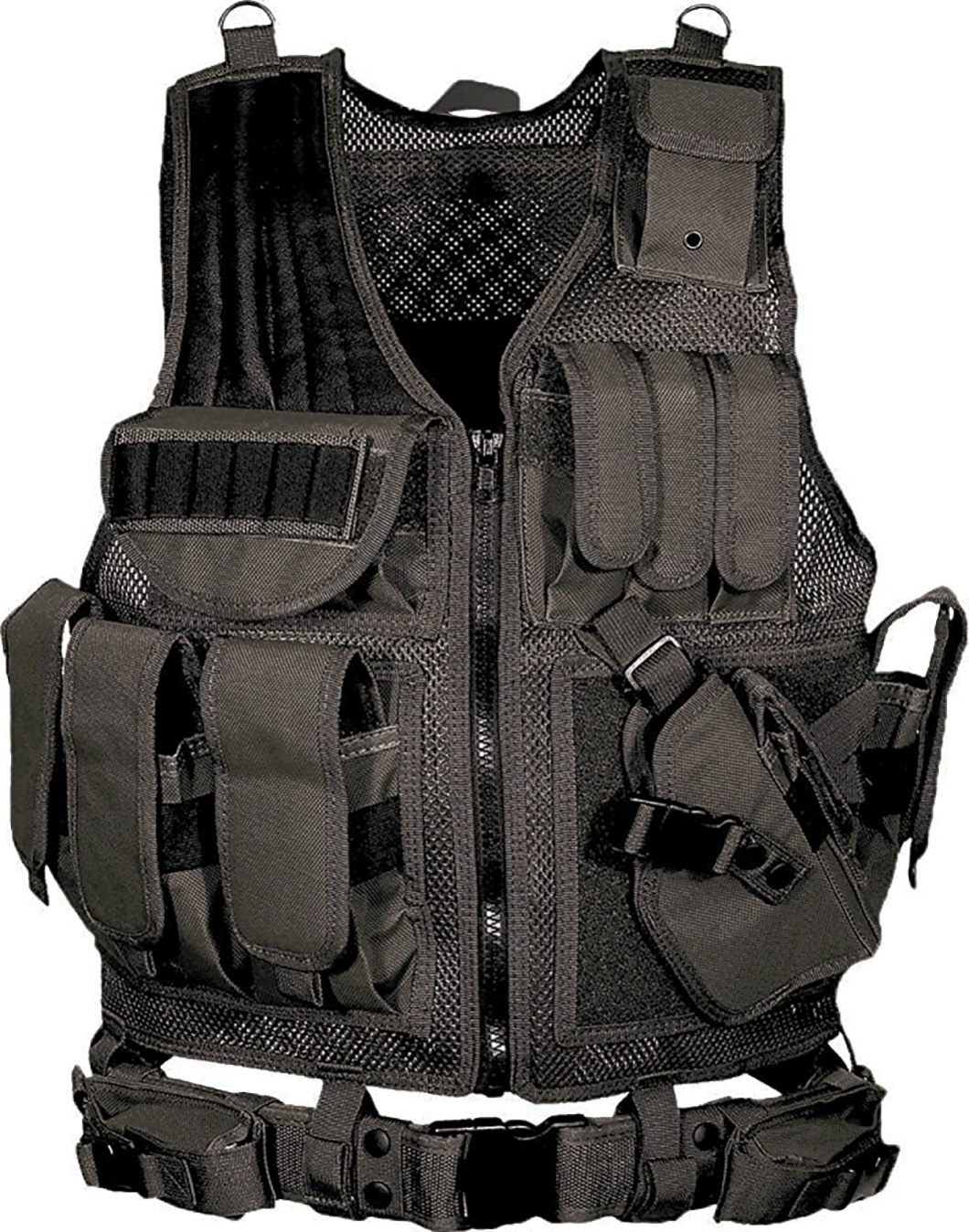 In 2018, Galati Gear introduced the Deluxe Tactical Vest with a removable mag belt. This new design is loaded with options to efficiently organize your gear the way you want it — for example, owners can remove the deluxe universal holster, pistol web belt and shot shell holder to attach patches or additional accessories. It also holds three height-adjustable pistol mag/flashlight pouches, a radio pouch, a sniper shoulder pad, two internal zippered map/document pockets, and a heavy-duty back-loop system to hold even more gear if necessary. It’s available in standard left- or right-hand versions, plus a husky right-hand design.
In 2018, Galati Gear introduced the Deluxe Tactical Vest with a removable mag belt. This new design is loaded with options to efficiently organize your gear the way you want it — for example, owners can remove the deluxe universal holster, pistol web belt and shot shell holder to attach patches or additional accessories. It also holds three height-adjustable pistol mag/flashlight pouches, a radio pouch, a sniper shoulder pad, two internal zippered map/document pockets, and a heavy-duty back-loop system to hold even more gear if necessary. It’s available in standard left- or right-hand versions, plus a husky right-hand design.
MSRP $50–$104.95
Get more information on this product ->

Tru-Spec Men’s 24-7 Series Guardian Pants
Fit for Duty
Keeping the foundation of its popular tactical pant style, Tru-Spec has upgraded the design for its latest, the 24-7 Series Guardian Pants for men. The slider waistband offers a more wearable fit, but still contains the original PRYM snap with YKK brass zipper. Side cargo pockets have been elongated with hook-and-loop closures. These are topped with an additional utility pocket. Another update is the easy-access DropN pocket behind each cargo pocket. Knees have been reinforced to endure intense physical activity. Colors include black, coyote, khaki and ranger green.
MSRP $62.95
Get more information on this product ->
HAIX Black Eagle Tactical 2.0 GTX High Side Zip Boot
Fancy Footwork
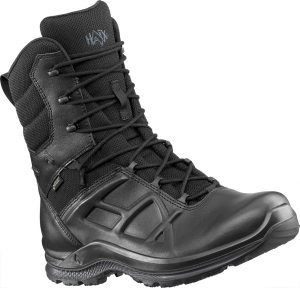 The latest in footwear from HAIX USA appears heavy-duty but feels lightweight. For the Black Eagle Tactical 2.0 GTX High Side Zip Boot, designers paired trail-running technology with nonslip soles, which are also are shock-absorbing to insure footing when giving chase. Extra padding in the ankle zone provides support and stability. This version contains Sun Reflect technology for breathability, a GORE-TEX inner liner for dry comfort and a waterproof zipper. The boots are completely metal-free, which gives you a leg up on security surveillance or metal detectors.
The latest in footwear from HAIX USA appears heavy-duty but feels lightweight. For the Black Eagle Tactical 2.0 GTX High Side Zip Boot, designers paired trail-running technology with nonslip soles, which are also are shock-absorbing to insure footing when giving chase. Extra padding in the ankle zone provides support and stability. This version contains Sun Reflect technology for breathability, a GORE-TEX inner liner for dry comfort and a waterproof zipper. The boots are completely metal-free, which gives you a leg up on security surveillance or metal detectors.
MSRP $199
Get more information on this product ->
Dickies Tactical Softshell Jacket
Withstand the Weather
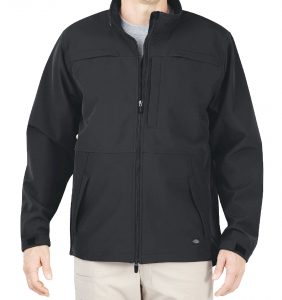 On the outside, the Dickies Tactical Softshell Jacket functions like typical winter outerwear; it’s both water-repellent and water-resistant as well as wind-resistant. On the inside, you’ll find smart tactical options, including hidden front and back ID panels and storage pockets to keep items out of sight. Plus, concealed weapons can be quickly accessed through a side holster. Designers included front slash hand-warmer pockets for extra comfort.
On the outside, the Dickies Tactical Softshell Jacket functions like typical winter outerwear; it’s both water-repellent and water-resistant as well as wind-resistant. On the inside, you’ll find smart tactical options, including hidden front and back ID panels and storage pockets to keep items out of sight. Plus, concealed weapons can be quickly accessed through a side holster. Designers included front slash hand-warmer pockets for extra comfort.
MSRP $99.99–$109.99
Get more information on this product ->
Propper 1/4 Zip Job Shirt
Total Coverup
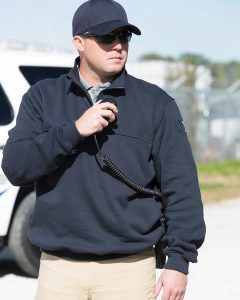 When you need a shirt to be much more than just a fashion statement, Propper’s 1/4 Zip Job Shirt is designed to get the job done. The cotton/polyester fleece fabric wraps the wearer in a warm, cozy layer. When dressed for duty, utilize the tactical specifics, such as mic clips located on the shoulders, dual-depth chest pockets and a two-channel pen pocket. It’s constructed to withstand lots of wear and tear, with anti-abrasion canvas reinforcements strategically located at elbows, side pocket and inside the collar. Sizes range from XS to 5XL.
When you need a shirt to be much more than just a fashion statement, Propper’s 1/4 Zip Job Shirt is designed to get the job done. The cotton/polyester fleece fabric wraps the wearer in a warm, cozy layer. When dressed for duty, utilize the tactical specifics, such as mic clips located on the shoulders, dual-depth chest pockets and a two-channel pen pocket. It’s constructed to withstand lots of wear and tear, with anti-abrasion canvas reinforcements strategically located at elbows, side pocket and inside the collar. Sizes range from XS to 5XL.
MSRP $44.99
Get more information on this product ->
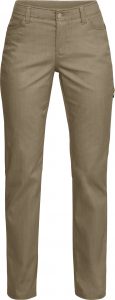
Under Armour UA Enduro Tactical Pants
Practical Tactical
The UA Enduro Tactical Pants from Under Armour are styled for doing the job in winter’s harsh elements. The UA Storm technology embedded in the material helps repel water, such as melting snow, while an anti-odor technology blocks the growth of nasty microbes. Plus, the pants are constructed from ultra-durable ripstop fabric, so they can withstand just about any activity required in the field. Offset belt loops make room for proper holster placement, and the stretch-engineered waistband accommodates movement. Available in both women’s and men’s cuts.
MSRP $75–$80
Get more information on this product ->
Original S.W.A.T. Chase 9” WP Side-Zip Boot
A Step Forward
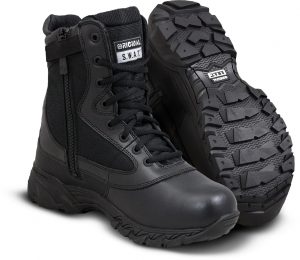 Everything about the Chase 9” WP Side-Zip boot by Original S.W.A.T. has been created for safety, durability and, of course, a comfortable fit. Safety precautions start with materials treated to be waterproof and bloodborne-pathogen-resistant. What’s more, a moisture-wicking lining contains AEGIS, an antimicrobial, and the Chase outsole exceeds the ASTM standard for slip resistance. Durability comes from proven material choices, including full-grain leather and long-lasting nylon. Comfort is due in part to a perforated collar for breathability, custom-molded thermoplastic heel counter and toe box, and a gusseted tongue to block dirt and debris.
Everything about the Chase 9” WP Side-Zip boot by Original S.W.A.T. has been created for safety, durability and, of course, a comfortable fit. Safety precautions start with materials treated to be waterproof and bloodborne-pathogen-resistant. What’s more, a moisture-wicking lining contains AEGIS, an antimicrobial, and the Chase outsole exceeds the ASTM standard for slip resistance. Durability comes from proven material choices, including full-grain leather and long-lasting nylon. Comfort is due in part to a perforated collar for breathability, custom-molded thermoplastic heel counter and toe box, and a gusseted tongue to block dirt and debris.
MSRP $129.99

Get more information on this product ->
See this story in the Winter 2018 FOP Journal issue.
Why Human Services?

As a supplement to our print story on criminal justice and human services degree programs, faculty experts explain the benefits to a holistic approach for today’s policing.
Traditionally, criminal justice degrees have focused on the legal and tactical aspects of a career in law enforcement, from the streets to the courthouse. But nowadays, many educational institutions are adding human services concentrations and electives to both undergraduate and graduate programs. We asked faculty members from a variety of universities to discuss this evolution and how law enforcement professionals can benefit professionally and personally by learning more about the human aspect of police work.
Meet the Faculty
 DAN BARRY, program chair of Criminal Justice and Security, University of Phoenix, Las Vegas Campus, retired from the Las Vegas Metro Police Department as a captain, having worked in SWAT, intelligence, patrol and internal affairs.
DAN BARRY, program chair of Criminal Justice and Security, University of Phoenix, Las Vegas Campus, retired from the Las Vegas Metro Police Department as a captain, having worked in SWAT, intelligence, patrol and internal affairs.
 KIMBERLEY BLACKMON, Ph.D., is the program director for all criminal justice degrees at Walden University. She also worked as a police officer and detective for more than six years.
KIMBERLEY BLACKMON, Ph.D., is the program director for all criminal justice degrees at Walden University. She also worked as a police officer and detective for more than six years.
 JACK HAMLIN, J.D., department chair for National University’s criminal justice program, has served as a police officer, evidence technician and lawyer.
JACK HAMLIN, J.D., department chair for National University’s criminal justice program, has served as a police officer, evidence technician and lawyer.
 SCOTT HAWKINS, Ph.D., is the director for the Master of Arts in Human Services program at Liberty University.
SCOTT HAWKINS, Ph.D., is the director for the Master of Arts in Human Services program at Liberty University.
 DAVID HOPPE helped develop the Bachelor of Science in Child Protection and Juvenile Justice degree at Bellevue University.
DAVID HOPPE helped develop the Bachelor of Science in Child Protection and Juvenile Justice degree at Bellevue University.
 AMY TROUT, Psy.D., is an associate professor and program director for the Regent University human services program. She helped establish the various concentrations, including criminal justice.
AMY TROUT, Psy.D., is an associate professor and program director for the Regent University human services program. She helped establish the various concentrations, including criminal justice.
 SHERYL VICTORIAN, Ph.D., functions as both an adjunct professor at Southern New Hampshire University and assistant chief for the Houston Police Department.
SHERYL VICTORIAN, Ph.D., functions as both an adjunct professor at Southern New Hampshire University and assistant chief for the Houston Police Department.
Why is being knowledgeable about human services, such as mental health, trauma and juvenile justice, important to law enforcement professionals (LEPs) today?
BARRY: I can’t emphasize enough the importance of education, especially human services. Without the human services component, you are at a disadvantage — 99.9% [of what we do] involves people.
TROUT: In law enforcement, you’re dealing with stressed situations where you’re not getting the best version of the people you’re meeting. That makes it more important to have that foundation of a good working knowledge of people and how to work well with them in light of situational barriers.
HAWKINS: We discuss how when people are anxious, fearful or uncertain, their behavior may escalate or increase irrationality. Human services can help police professionals in recognizing the signs and remaining calm themselves so they can move to desired outcomes of their own behavior that are more likely to produce desired outcomes for the situation.
VICTORIAN: Human services education in law enforcement is very important. It teaches us how to deal with victims and address the needs of victims. It also shows that law enforcement professionals have a compassionate side.
HAMLIN: Not all crime necessarily involves criminals. What crimes do have in common is a certain spiral of shame with that individual. If we can break that cycle and get them back up to operational levels, maybe we will see a drop in crime like we’ve seen over the past few years.
HOPPE: Adolescents who are incarcerated, who have had traumatic childhoods, psychopathology … grow up and go into the adult system. If we could intervene earlier, then maybe we could be lowering the adult prison population.
Recently there’s been reporting on how often police and corrections officers encounter individuals struggling with mental illness. Do human services courses help prepare LEPs to more effectively cope with this population?
BARRY: A high percentage of what police deal with is people suffering mental illness. Here at the University of Phoenix, we hosted a symposium [in] partnership with human services on how to de-escalate situations. As a former SWAT officer, I can tell you firsthand, crisis negotiations work to deescalate individuals. You spend the time to talk and de-escalate individuals and maybe bring them to medical professionals if they need it. We don’t need to arrest and make them go to jail.
BLACKMON: That’s so critical right now in the criminal justice field. We are adding that element to our undergraduate and master degrees. We’ve gone through our academic programs to review it with experts to change certain elements, such as crisis identification and intervention.
Can an education in human services improve LEPs’ wellness?
TROUT: They’re dealing with hard situations, and oftentimes, you do not have the opportunities for debriefing. It’s good to know how to do a self-assessment of how well you’re functioning in light of job stress. That can help prevent burnout and let you know how you can get resources.
VICTORIAN: Officer wellness is a big issue in law enforcement right now. There is a high percentage of suicides in the profession. A background in human services education does allow officers the opportunity to be able to identify within themselves when they’re struggling and recognize they may need help. If they’re not properly dealt with, then our behavior could lead to destruction to our careers and families.
How would you advise LEPs who may be considering studying human services to advance their professional development?
HAWKINS: Determine if you’re looking for knowledge in a niche area. Do you want more knowledge of substance abuse and how different substances affect individuals? Would you like more knowledge in terms of resiliency and working with the military, understanding triggers of PTSD and knowing what the cues are?
HAMLIN: Look at what your department needs and the direction of law enforcement you want to go. Also, consider the practical aspects, such as the time and cost required to obtain your degree.
TROUT: Look at the quality of instruction and instructors. Who is directing the program and teaching the classes? Are these people you can grow through?
For more about these programs, read “The Human Touch.”
The Human Touch

Criminal justice degrees emphasizing human services can help officers help others.
As a public servant, you regularly come in contact with a variety of people — witnesses and victims of every age as well as offenders. Each encounter presents unique circumstances that call for situational-specific responses. Traditional training emphasizes the legal, safety and tactical parameters of a scenario, but what about the human behavior aspect? “Without the human services component, you are at a disadvantage — 99.9% [of what we do] involves people,” says Dan Barry, a retired law enforcement officer who chairs the Criminal Justice and Security program (which includes the option for a human services concentration in its B.S. in Criminal Justice Administration degree) at the University of Phoenix’s Las Vegas campus.
Many members of law enforcement are attracted to the profession specifically because they want to have a positive impact on people’s lives. And the expectations on officers to address issues of community policing, mental illness, homelessness, domestic violence and juvenile justice are greater than ever. In response, more and more criminal justice degree programs are offering a human services concentration for a holistic approach to policing. Whether you’re interested in honing your people skills in your existing position or transitioning to a specialized field like child welfare or victim advocacy, pursuing higher education in this area can better equip you to answer the call for help.
 WALDEN UNIVERSITY
WALDEN UNIVERSITYDEGREE: Bachelor of Science in Criminal Justice: Human Services for Criminal Justice
COURSE SAMPLING: Restorative Justice; Mobilizing and Coordinating Community Response; Victimology
KEY COMPONENTS: Walden’s human services concentration arms students with the power to advocate for victims and juveniles by learning to assess needs and identify community resources as well as studying trends, such as restorative justice strategies.
FACULTY INSIGHT: “What makes us different is our mission statement of making positive social change, and we incorporate that into the curriculum. For capstone projects, we encourage students not just to summarize their experience, but also how they will apply what they learned to their daily lives.” — Kimberley Blackmon, Ph.D., Criminal Justice program director
DEGREE: Bachelor of Science in Criminal Justice, Human Services Concentration
COURSE SAMPLING: Communication Skills for Human Service Professionals; Family and Community Systems; Ethics and Laws in Child Welfare
KEY COMPONENTS: Coursework for this online degree helps students learn skills to manage crises, identify the impact of trauma and spearhead coordination with other agencies.
FACULTY INSIGHT: “We have a responsibility to give victims the help they need and we need to build relationships to improve [community policing].” — Sheryl Victorian, Ph.D., adjunct professor and assistant chief of the Houston Police Department
DEGREE: Bachelor of Science in Child Protection and Juvenile Justice
COURSE SAMPLING: Interviewing and Negotiating; Victimology and Trauma; Freedom and Responsibility
KEY COMPONENTS: Offered online only, courses for this accelerated degree are divided into sequential cohorts to advance skill sets. Lessons examine adolescent welfare and juvenile justice, psychological disorders affecting young people, and the complexity of family dynamics.
FACULTY INSIGHT: “For law enforcement officers who work in schools, such as resource officers, this would be an ideal degree. Courses discuss how to confront adolescents under the influence of drugs or with mental illness.” — David Hoppe, assistant professor and program director
DEGREE: Master of Art in Human Services, Criminal Justice & Ministry
COURSE SAMPLING: Helping Skills & Techniques; Multicultural Awareness & Individual Diversity; International Trafficking in Persons
KEY COMPONENTS: A partnership between the School of Psychology & Counseling and the Regent University School of Law, this master’s degree addresses pertinent topics in law enforcement today. Each course runs eight weeks, often including small-group projects, podcast lectures and asynchronous chatroom discussions.
FACULTY INSIGHT: “Even if topics aren’t ministry-specific, such as criminal justice, our core classes in human services do have integrated components. You’re studying the specifics, but we’re also talking about ways on how to enhance that from a ministry perspective.” — Amy Trout, Psy.D., associate professor and Human Services program director
DEGREE: Master of Science in Juvenile Justice
COURSE SAMPLING: Leaders at National University are restructuring the curriculum, with input from juvenile probation departments, for this advanced degree. Starting in spring 2019, courses will reflect restoration and other proven practices to prevent juveniles from becoming adult offenders.
KEY COMPONENTS: National University awards students with credit for classes completed at the police academy and general education units from community colleges to reduce the time needed in the classroom.
FACULTY INSIGHT: “We’re looking at ways to educate people with a look at juvenile offenders from a broader, holistic view rather than just an offender in an incident.” — Jack Hamlin, J.D., professor and Criminal Justice department chair
 DEGREE: Bachelor of Science in Criminal Justice Administration, Human Services for Criminal Justice Concentration
DEGREE: Bachelor of Science in Criminal Justice Administration, Human Services for Criminal Justice Concentration
COURSE SAMPLING: Mental Health and Crisis Intervention in Criminal Justice; Case Management and Services Provided in Criminal Justice; Collaborative Services in Criminal Justice
KEY COMPONENTS: Enrollees gain an in-depth knowledge of theories and principles. Plus, the curriculum and faculty challenge students to exercise leadership and managerial skills typically required for career advancement.
FACULTY INSIGHT: “I love teaching communication. How we communicate isn’t necessarily just about the words we use, but how we say them and how they come across to others.” — Dan Barry, Criminal Justice and Security program chair, Las Vegas Campus
 DEGREE: Master of Art in Human Services Counseling, Criminal Justice
DEGREE: Master of Art in Human Services Counseling, Criminal Justice
COURSE SAMPLING: Human Growth & Development; Studies in Interpersonal Communication; Group Dynamics
KEY COMPONENTS: Students gain a comprehensive perspective of how behavioral sciences complement criminal justice practices with real-world examples illustrating principles in counseling and mental health.
FACULTY INSIGHT: “Law enforcement and military personnel have gravitated to this degree. They appreciate that the core counseling classes give them a higher set of people skills … and insight into mental health issues at the practical level.” — Scott Hawkins, Ph.D., MA Human Services director
Click here to read more faculty insights on how human services degrees in criminal justice can benefit officers.
For more programs, along with faculty insights on how human services degrees in criminal justice can benefit officers, visit fopconnect.com/education-connect.

See this story in the Winter 2018 FOP Journal issue.
Protecting the Castle


The Mandalay Bay resort and casino in Las Vegas, site of the deadliest mass shooting by an individual in modern U.S. history, is just one example of how public venues can be vulnerable to attack.
It seems as though nothing is off limits to individuals and groups intent on doing harm to others. The Los Angeles County Sheriff’s Department Temple Station, NYPD’s 52nd Precinct and Texas Tech University Police in Lubbock are only a few of the law enforcement agency locations that have fallen victim to attacks in recent years. There have also been cowardly attacks at concerts and other entertainment events around the world, including the Las Vegas mass shooting and the Manchester bombing. These incidents have forced law enforcement to re-evaluate their current tactics, techniques and procedures for mitigating threats to public sites and their own workplaces. Additionally, critical infrastructure facilities and entertainment venues alike are examining their physical security postures to assess their readiness to combat these types of violent attacks. Law enforcement must place great emphasis on securing their own houses as well as public places that may be targets, developing facility-specific strategic response plans that work in conjunction with the venues’ existing security measures.
For many years, active killers and terrorist organizations have claimed victims from all walks of life on a global scale. These threats are very real, and law enforcement must maintain a constant state of readiness and conduct ongoing training and evaluations. Terrorists will indiscriminately seek soft targets and exploit vulnerabilities in an attempt to claim as many victims as possible. These attacks are not random or by accident; they are calculated acts of violence with the intent of achieving a specific outcome. The Federal Bureau of Investigation defines terrorism as “the unlawful use of force or violence against persons or property to intimidate or coerce a government, the civilian population, or any segment thereof, in furtherance of political or social objectives.” Therefore, law enforcement, entertainment venues and music touring personnel, like anyone else, must face the potential threat of global terrorism just as much as they must face random acts of violence.
The tactics, techniques and procedural lines of physical security and personal security are often blurred or confused by personnel not specifically trained in the two disciplines. To clarify this misconception, physical security is the act of protecting assets, whereas personal security focuses on the protection of personnel. Although these are completely separate procedurally, they both have common ground and therefore the security model must work in harmony between the two. This article will focus on the physical security aspects for maintaining a high level of security at a public venue, with the primary focus of creating a harder target and enhancing the level of protection of the site and its occupants.
Military and law enforcement operations all start with information pertaining to a particular operation or event. Once that information is collected, it is then vetted to determine whether it will yield any benefit to the operation. If it is determined to be beneficial, it is considered intelligence and categorized accordingly. The intelligence is then used to build a target package through the utilization of intelligence assets and other resources. Let’s examine the social media aspect of active-shooter incidents. Several case studies show that the attackers either posted their intent on social media prior to the attack or livestreamed during it. There is never a perfect solution to these types of incidents. However, data shows that the use of open-source intelligence (OSINT) may have proved beneficial in mitigating some of these attacks, thereby potentially saving lives. There are numerous companies that provide software platforms for the collection of OSINT. These platforms collect data from the dark web, social networks, public records and numerous other online locations, using keyword searches, geofencing, historical searches and SMS real-time alerts to quickly locate people.

A typical sight in most office buildings, a door being propped open is a simple example of a security vulnerability that has the potential to compromise an entire facility. (Photo by Darren Norris)
The first thing that should be assessed is the physical security posture of each specific potential target, whether it be a law enforcement agency, entertainment venue or critical infrastructure site. This starts with a thorough physical security assessment of the site by examining three key components: risk, vulnerability and real or perceived threats. This is often referred to as a threat and vulnerability or risk assessment. It is important to note that “threat,” “risk” and “vulnerability” are not interchangeable terms. Although they have similarities, each is very different in nature and is part of the overall paradigm for assessing risk and vulnerability.
Threats can often be a very challenging element to factor into a security plan. In most cases, a threat is viewed as the “X-factor” when it pertains to physical security. Threats are typically outside of total control and therefore are usually assessed on a theoretical basis, unless specific threats have been made to a specific site. However, once a threat has been identified, the validity must then be evaluated to determine whether the threat is real or perceived, and then the physical security plan can be tailored to meet it as required.
The risk assessment element is designed to clarify the nature of a risk. Additionally, it is designed to gauge the probability of occurrence, its intensity and what impact it will have on people, property and the surrounding environment. By decreasing existing onsite vulnerabilities, risk can be effectively managed and theoretically mitigated through proper assessments, planning and corrective action.
A vulnerability exists when there is degradation in the physical security design. An inoperable barrier, eroded berm or broken fence are all examples of vulnerabilities in the physical security design. These, coupled with existing threats, may result in a loss of life or catastrophic damage to the venue if existing vulnerabilities aren’t identified and the appropriate corrective actions taken.
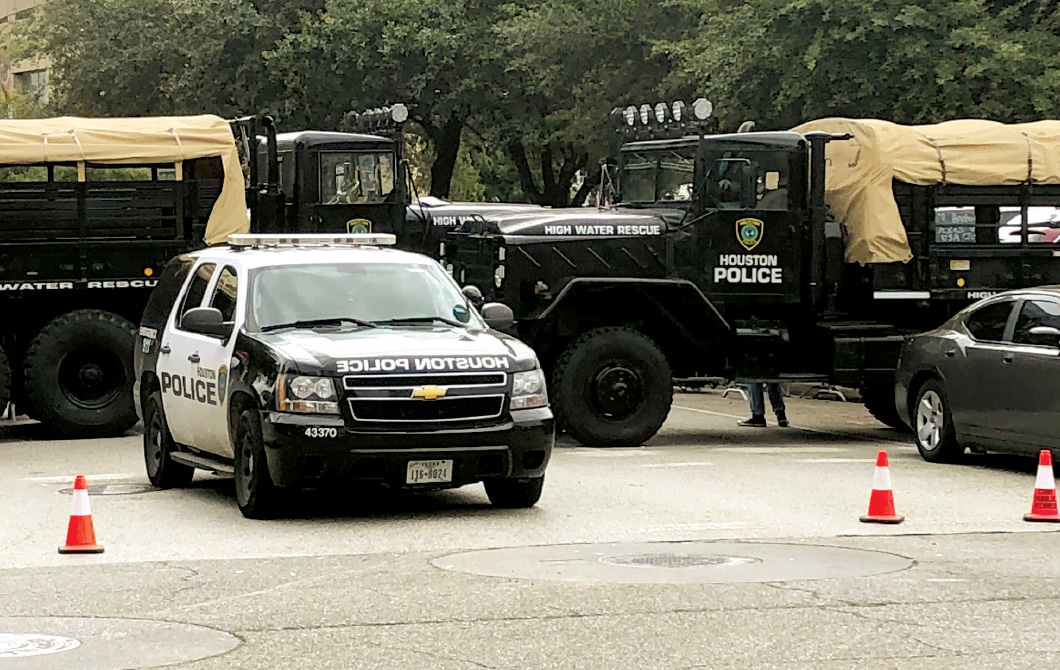
For added perimeter security at a recent rally held by President Trump, Houston Police created barriers with M35 2½-ton (aka “deuce and a half”) cargo trucks and dump trucks to close roads around the venue. (Photo by Darren Norris)

A walk-through magnetometer at a concert venue is an example of access control.
In order to determine what level of physical security is required for a facility, a thorough physical security assessment must be conducted in order to identify what vulnerabilities exist. The simplified baseline for this assessment is to deny unauthorized persons access to the facility, equipment or resources. The singular focus is to protect lives and property at the location being assessed. There are seven basic elements that should be evaluated during the assessment. These multilayered elements are interdependent and must be assessed and maintained on a continuous basis.
- Perimeter security: The perimeter is the boundary that separates the secure areas from those the public can access. There are numerous types of perimeters that are used to security a facility, ranging from fences to solid walls. The physical security assessment will aid in identifying which perimeter control measures should be added or enhanced for each individual location. This should also include the perimeter or security buffer zone.
- Security guard force: Security guards with the appropriate jurisdictional authority to enforce the laws on the property in which they are paid to protect. In most cases, a properly deployed guard force will serve as a deterrent for those with the intent to do harm.
- Access control: Access to any facility should be restricted to persons authorized to be in specific areas of the property. Access control is typically designed to allow access through the use of human-controlled methods such as a receptionist or security guard, or through mechanically controlled methods such as key locks or biometrics.
- Intrusion detection system (IDS): Intrusion detection monitors the security system for both malicious activity and violations of facility policy. The system network will immediately alert security personnel in the control center of any irregularities. Typically, the intrusion detection system will integrate with other systems, such as perimeter control and video monitoring systems.
- Video monitoring system (VMS): Video monitoring systems are a valuable asset because they can function as a facility-wide force multiplier when sufficient guard force does not exist to patrol the facility. Additionally, they serve as a visible deterrent and provide video documentation that can be used for analysis of previous events.
- Security lighting: Proper security lighting must be utilized to protect persons and property from criminal activity. Proper lighting also serves as a deterrent and gives the perception of an increased security posture. Security lighting should be installed along perimeters, buildings, pathways, parking lots and any other area determined to be a potentially vulnerable zone.
- Occupant emergency plan (OEP): Law enforcement or a physical security specialist should assist in the development of a comprehensive OEP for agency as well as all civilian sites. This is done through the physical security assessment process. The OEP is a critical part of the security plan, as it instructs personnel on how to respond during an incident. Comprehensive incident response guidelines for personnel should include the following elements:
- Supervisory role
- Rally points
- Accountability of personnel
- Communications
- Medical aid
- Law enforcement response and how personnel should interact during an incident
All personnel who work within the facility should be educated on the OEP so that they have a complete understanding of how they should respond to an incident, either individually or in a group.

Landscaping should be designed to deny access to the facility. This berm providing easy access to the roof is an example of what not to do. (Photos by Darren Norris)
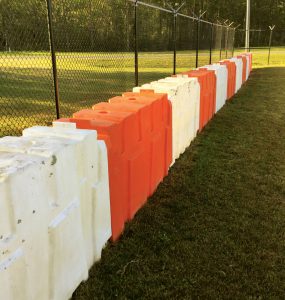
Jersey barriers should be properly placed and properly filled. Empty barriers will not provide the required level of protection to deny access to unauthorized vehicles.
Crime prevention through environmental design is a widely used technique in the physical security design process. Not every facility has the fiscal means within its budget to purchase state-of-the-art security equipment or pay personnel for security staffing. The CPTED method is widely used in conjunction with all security designs, as it provides an additional layer of security for facilities with existing physical security assets. For facilities with limited budgets, CPTED will provide a fundamental layer of security. CPTED is not designed as a means to deny access to any location, but as a means of redirecting direct access to certain areas and deterring crime. The CPTED concept consists of four basic principles:
-
-
- Natural surveillance is the “see and be seen” concept. A person is less likely to commit a crime if they believe that someone can see them committing it. During the design process, lighting and landscape should be assessed to provide maximum site-wide visibility.
- Natural access control is a method to direct pedestrian and vehicular traffic to a desired location through a predetermined route. In order to achieve the desired result, landscape, signage, fencing, lighting and walkways are used.
- Territorial reinforcement is used to create a sphere of influence giving the perception of an increased security posture at the facility. Public and private areas are clearly distinguished. The physical security design process may include the use of concrete planters, landscaping, signage or other devices to make a statement of proprietorship on the facility grounds.
- Maintenance is an often-overlooked component in all security programs. The “broken window theory” implies that if one broken window exists, it will lead to others. Neglected and poorly maintained properties will ultimately become an attractive target for the criminal element. Therefore, scheduled and as-needed repairs and preventive maintenance should be ongoing.
-
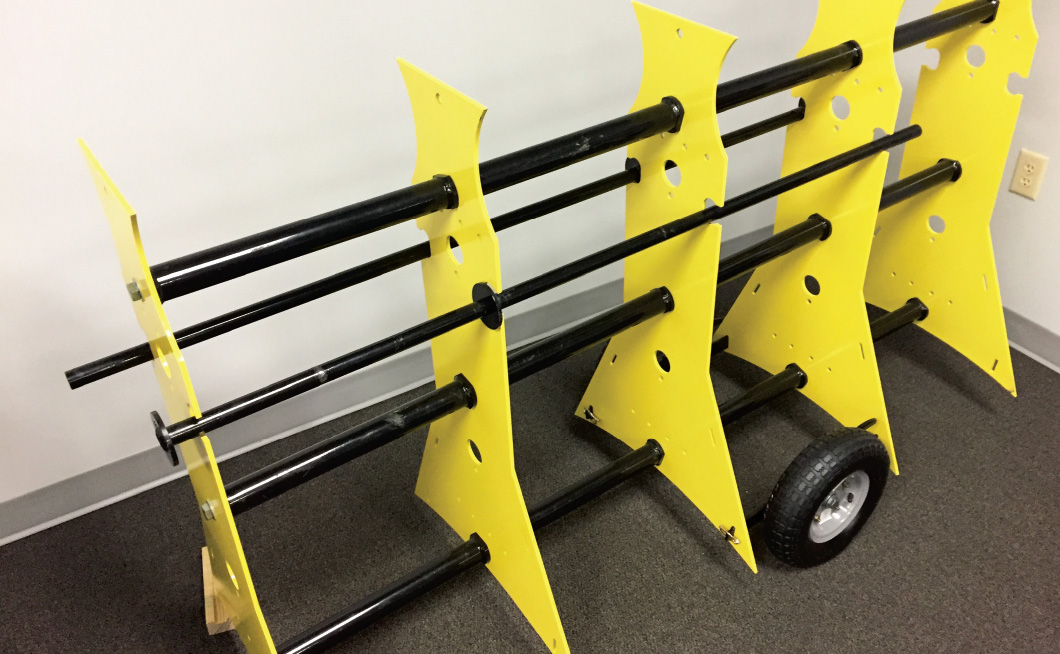
Portable barriers are an outstanding method for controlling access in the absence of fixed equipment.
Physical security assessments are not a “one and done” concept. Law enforcement should conduct regular training and evaluations at their own agency as threats against law enforcement continue to increase. Additionally, training and security assessments should be conducted on a regular basis with partner agencies and designated high-value targets within the community at locations such as stadiums, arenas, schools, water treatment facilities and other facilities that would be detrimental to the public and community infrastructure if attacked.
Unfortunately, numerous facilities have allowed their onsite equipment assets to degrade and essentially become ineffective. A good example is a cracked water-filled Jersey barrier that allows the water to drain out. A Jersey barrier, depending on design, ranges in weight from 1,500 to 2,000 pounds when full, versus an empty weight of approximately 150 pounds. Another good example would be the triple strand of barbed wire atop a chain-link fence. The triple-strand wire routed through the “Y” arm atop the fence post creates an ominous sight to most. However, the majority of fences are easily defeated, as many of the arms are not welded in place, thus rendering them ineffective from an access-control standpoint.
Officers tasked with conducting physical security assessments must be certified as a physical security specialist, train regularly, and build a comprehensive network with open lines of communication with the various high-value entertainment venues, educational sites and infrastructure facilities within the community.
Darren Norris retired as the assistant chief of police with the Pelion Police Department. He is the chief operations officer with MUR Strategic, a company that specializes in protective security operations. He has over 28 combined years of military and law enforcement experience. A state-accredited law enforcement instructor since 1995, he has served in command, patrol, K-9, SWAT and investigations assignments throughout his career and is an active member of Midlands Lodge #1.
See this story in the Winter 2018 FOP Journal issue.
Safe, Sound and Secure

When hard work pays off and you’re able to purchase a family home and fill it with treasured belongings, you want everything, and everyone, to be protected from intruders and thieves. And as law enforcement professionals, you certainly want assurance that weapons are safely stored. How you go about creating that security, however, has radically changed in recent years. The Internet of Things (IoT) — the connection and sharing of data between devices embedded with electronics, sensors and other programs to track activity — has drastically expanded home security options. Smart doorbells show you who’s knocking. Cameras record activity and store it, potentially becoming evidence in the event of a crime. Even traditional safes have added IoT capabilities. Here’s a sampling of what’s new and high-tech in home security these days.
 It’s only human nature to become absentminded from time to time and forget to lock the door on your way out, especially when in a hurry. Then there are those occasions when you can’t remember whether you did or didn’t lock the door. Now you’re left wondering if your home is vulnerable. The August Smart Lock Pro + Connect, from August Home Inc. can alleviate that worry. With its DoorSense, an intelligent integrated sensor, homeowners are notified via smartphones when doors are opened and closed. Plus, this advanced model can be programmed to automatically lock doors whenever closed. The platform also communicates with Alexa, HomeKit/Siri, Google Assistant and Z-Wave. MSRP $279.
It’s only human nature to become absentminded from time to time and forget to lock the door on your way out, especially when in a hurry. Then there are those occasions when you can’t remember whether you did or didn’t lock the door. Now you’re left wondering if your home is vulnerable. The August Smart Lock Pro + Connect, from August Home Inc. can alleviate that worry. With its DoorSense, an intelligent integrated sensor, homeowners are notified via smartphones when doors are opened and closed. Plus, this advanced model can be programmed to automatically lock doors whenever closed. The platform also communicates with Alexa, HomeKit/Siri, Google Assistant and Z-Wave. MSRP $279.
Get more information on this product ->
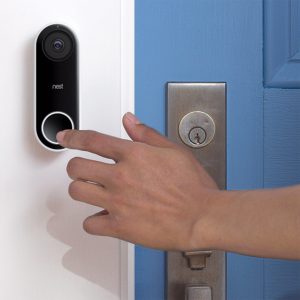 The Nest Hello smart doorbell is more than just a camera attached to a traditional doorbell. It also functions as an alert system, starting with sending video from a 160-degree diagonal field of view to the Nest app when someone approaches. This can be helpful to track deliveries, including capturing evidence in case of front-porch package snatchers. Nest Aware subscribers can store all video in the cloud. Additionally, you can communicate through the app, or play back one of the recorded messages to make strangers believe someone is home even when you’re not. The device requires a bandwidth of 800–2,000 kbps for streaming video. MSRP $229.
The Nest Hello smart doorbell is more than just a camera attached to a traditional doorbell. It also functions as an alert system, starting with sending video from a 160-degree diagonal field of view to the Nest app when someone approaches. This can be helpful to track deliveries, including capturing evidence in case of front-porch package snatchers. Nest Aware subscribers can store all video in the cloud. Additionally, you can communicate through the app, or play back one of the recorded messages to make strangers believe someone is home even when you’re not. The device requires a bandwidth of 800–2,000 kbps for streaming video. MSRP $229.
Get more information on this product ->
 You don’t have to be a Spielberg or Scorsese to set up the perfect exterior shot. The Ring Spotlight Cam line of security cameras can record scenes from the front, back or side of your home. Both the wired and battery models host 1080p HD cameras with a 140-degree field of view. Recording begins when motion is detected, including turning on two LED lights, which also can be set to a schedule. The battery model holds two 6,000 mAH removable, rechargeable Ring batteries. Or, invest in the solar version, which comes with a Ring Solar Panel to continuously charge batteries. Wired and battery models MSRP $199 each; Solar $229.
You don’t have to be a Spielberg or Scorsese to set up the perfect exterior shot. The Ring Spotlight Cam line of security cameras can record scenes from the front, back or side of your home. Both the wired and battery models host 1080p HD cameras with a 140-degree field of view. Recording begins when motion is detected, including turning on two LED lights, which also can be set to a schedule. The battery model holds two 6,000 mAH removable, rechargeable Ring batteries. Or, invest in the solar version, which comes with a Ring Solar Panel to continuously charge batteries. Wired and battery models MSRP $199 each; Solar $229.
Get more information on this product ->
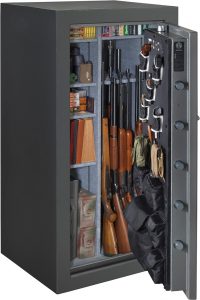 When it comes to securing your firearms, having a reliable locking system is critical. Equally important is how they’re stored. Stack-On’s Total Defense gun safe allows owners to customize the interior with three adjustable barrel rests, including a U-shaped insert, and five adjustable shelves, which can accommodate between 36 and 40 guns. The factory-installed door organizer contains zippered pouches, MOLLE-compatible components and sewn-in gun holsters. The locking system consists of seven solid-steel live-action locking bolts partnered with three deadbolts. Choose from a backlit biometric, backlit electronic or three-number combination lock. MSRP $999.
When it comes to securing your firearms, having a reliable locking system is critical. Equally important is how they’re stored. Stack-On’s Total Defense gun safe allows owners to customize the interior with three adjustable barrel rests, including a U-shaped insert, and five adjustable shelves, which can accommodate between 36 and 40 guns. The factory-installed door organizer contains zippered pouches, MOLLE-compatible components and sewn-in gun holsters. The locking system consists of seven solid-steel live-action locking bolts partnered with three deadbolts. Choose from a backlit biometric, backlit electronic or three-number combination lock. MSRP $999.
Get more information on this product ->
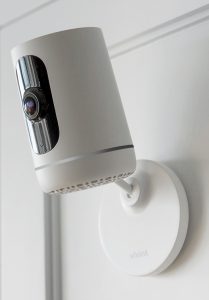
 Whether you want to monitor childcare providers, watch over children staying home alone or document what’s happening while you’re away, Ping, an indoor camera by Vivint, produces a clear image. The 1080p video stream films a 155-degree view, including infrared night vision, and can serve as a motion-activated security camera when positioned near doors. However, these are not silent movies. Ping offers two-way talk and one-touch callout so family members can remain in communication. Vivint Smart Home subscribers use the Ping system to save footage to the cloud and arrange custom mobile notifications for specific activities, from intruder alerts to confirmation that homework is underway. MSRP $199.
Whether you want to monitor childcare providers, watch over children staying home alone or document what’s happening while you’re away, Ping, an indoor camera by Vivint, produces a clear image. The 1080p video stream films a 155-degree view, including infrared night vision, and can serve as a motion-activated security camera when positioned near doors. However, these are not silent movies. Ping offers two-way talk and one-touch callout so family members can remain in communication. Vivint Smart Home subscribers use the Ping system to save footage to the cloud and arrange custom mobile notifications for specific activities, from intruder alerts to confirmation that homework is underway. MSRP $199.
Get more information on this product ->

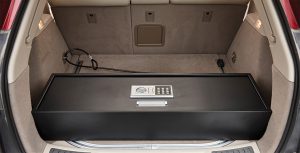 Our vehicles sometimes become mobile storage units, holding tools, electronic devices and any number of other items we need to take on the road. However, opportunistic thieves see cars as easy access to such goodies. The Trunk Safe from SnapSafe helps guard personal and professional gear. The heavy-duty storage case is constructed of 13-gauge steel and topped with a 6-gauge steel door, secured by a digital lock with a key backup. It’s large enough (42”W x 7”H x 13”D) to hold a variety of items, including weapons. Internal hinges combined with gas shocks cushion the ride. MSRP $350.
Our vehicles sometimes become mobile storage units, holding tools, electronic devices and any number of other items we need to take on the road. However, opportunistic thieves see cars as easy access to such goodies. The Trunk Safe from SnapSafe helps guard personal and professional gear. The heavy-duty storage case is constructed of 13-gauge steel and topped with a 6-gauge steel door, secured by a digital lock with a key backup. It’s large enough (42”W x 7”H x 13”D) to hold a variety of items, including weapons. Internal hinges combined with gas shocks cushion the ride. MSRP $350.
Get more information on this product ->
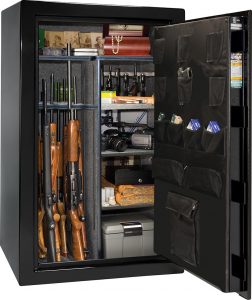 Liberty Safe incorporates multiple security precautions in its USA Series safes, titled in part because they’re manufactured in the USA. One layer consists of patent-pending 4-inch-wide military-style locking bars, which proved to be several times stronger than other safes in pry tests. That works in conjunction with the company’s two-piece roll-form body. An integrated Z-bar placed in the door is another anti-pry mechanism. An internal hard plate protects against lock drilling. The USA Series is available in three sizes varying in width. MSRP starting at $899.
Liberty Safe incorporates multiple security precautions in its USA Series safes, titled in part because they’re manufactured in the USA. One layer consists of patent-pending 4-inch-wide military-style locking bars, which proved to be several times stronger than other safes in pry tests. That works in conjunction with the company’s two-piece roll-form body. An integrated Z-bar placed in the door is another anti-pry mechanism. An internal hard plate protects against lock drilling. The USA Series is available in three sizes varying in width. MSRP starting at $899.

Get more information on this product ->
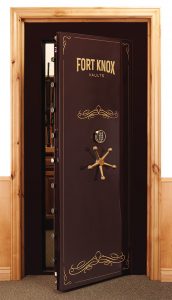 Vaults
VaultsSafes should be able to protect valuables against catastrophes as well as bad guys, and that’s why Fort Knox Vaults are designed to withstand extreme heat along with man-made mayhem. The company’s Inferno Shield 90 has been tested to survive approximately 350 degrees. The vaults also feature C-rated fireboard insulation on all sides and behind hinges to prevent hotspots. Together with a heat-sensitive fire seal and built-in dead air space barrier, the vault can sustain 1,680 degrees for up to 90 minutes. Models offer a variety of options, including different body thicknesses, corner bolts, door organizers and dehumidifiers. MSRP starting at approximately $1,300.

Get more information on this product ->
See this story in the Summer 2018 FOP Journal issue.
State-of-the-Art Policing
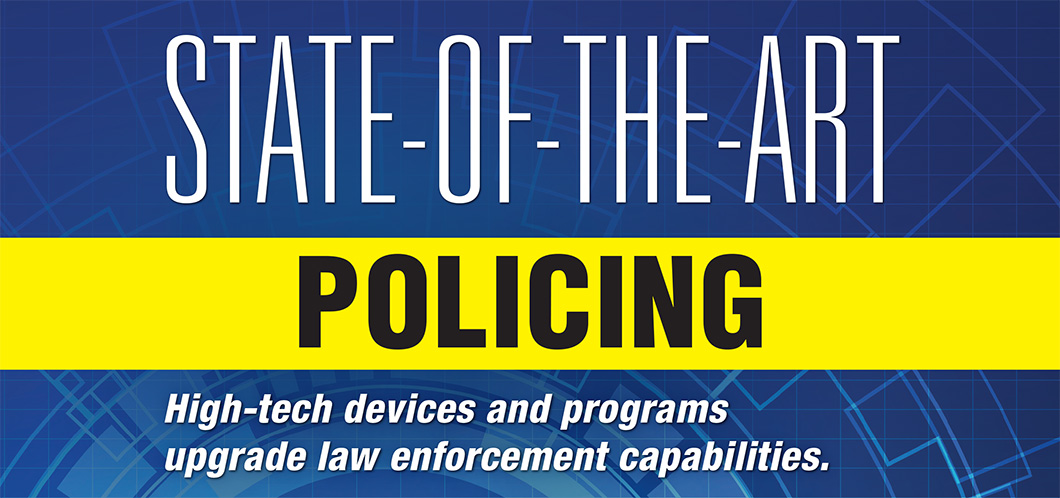
Are you a total tech geek? Do you know more about the newest smartphone than your Gen-Z children? Perhaps you’ve built a personal computer or purchased a collection of electronic gadgets, from self-guided vacuums to 4K televisions streaming high-definition programs to smart appliances that control thermostats and even track groceries. For many, the appeal of technology is that it can conduct certain operations and functions faster and more accurately than humans, and that’s partly why law enforcement has embraced high-tech tools.
What’s more, the tech community has come to recognize the unique needs within law enforcement. Hardware designers, along with software and application developers, continue to create products specifically to aid officers in their mission to protect and serve. And best of all, even if you’re not a technophile, you don’t have to understand exactly how they work to reap the benefits in speed and convenience.
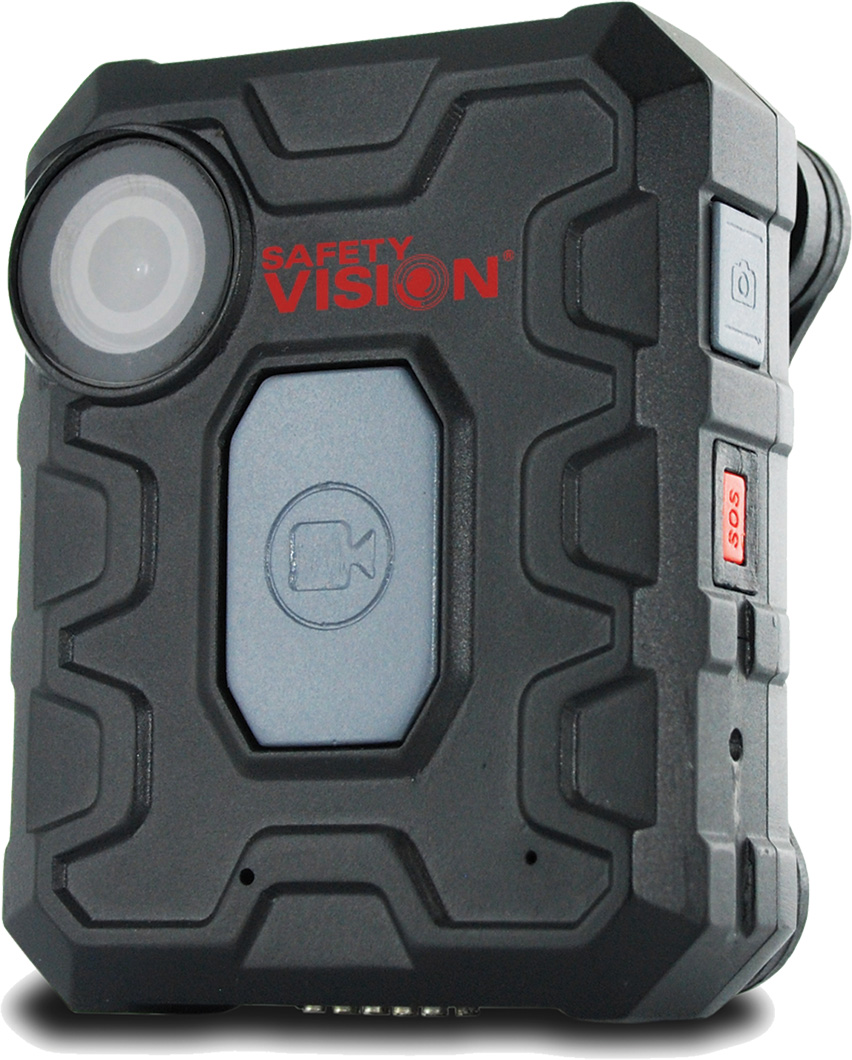 Prima Elite, a body-worn camera by Safety Vision, strives to paint a complete picture from the officer’s point of view. Among the technical highlights are 64 gigabytes of internal storage, 1080P video resolution and an easy touch-and-go recording mechanism. From a tactical standpoint, the camera captures as many incident details as possible with a 135-degree field of view and pre-event recording capability. Downloaded videos can only be accessed via an authorized computer. MSRP $595.
Prima Elite, a body-worn camera by Safety Vision, strives to paint a complete picture from the officer’s point of view. Among the technical highlights are 64 gigabytes of internal storage, 1080P video resolution and an easy touch-and-go recording mechanism. From a tactical standpoint, the camera captures as many incident details as possible with a 135-degree field of view and pre-event recording capability. Downloaded videos can only be accessed via an authorized computer. MSRP $595.
Get more information on this product ->
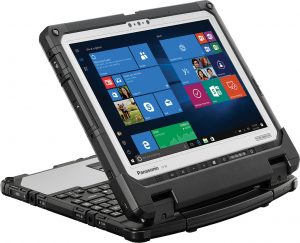 Convenience is the highlight of the latest generation of Toughbook laptops from Panasonic. Toughbook 33 was designed specifically with the mobile professional in mind. Its monitor is 50 percent brighter and 15 percent larger than most other devices in its class, and it has three times the resolution. Plus, the 3:2 screen accommodates easy-to-read computer-aided dispatch notifications. The monitor detaches to become a tablet, able to go anywhere. To protect against would-be cyber intruders, an infrared webcam combines with Windows Hello software to activate a biometric user authentication. Additional options include a serial port, barcode and contactless SmartCard CAC readers. Battery life runs 10 hours. MSRP $3,649.
Convenience is the highlight of the latest generation of Toughbook laptops from Panasonic. Toughbook 33 was designed specifically with the mobile professional in mind. Its monitor is 50 percent brighter and 15 percent larger than most other devices in its class, and it has three times the resolution. Plus, the 3:2 screen accommodates easy-to-read computer-aided dispatch notifications. The monitor detaches to become a tablet, able to go anywhere. To protect against would-be cyber intruders, an infrared webcam combines with Windows Hello software to activate a biometric user authentication. Additional options include a serial port, barcode and contactless SmartCard CAC readers. Battery life runs 10 hours. MSRP $3,649.
Get more information on this product ->
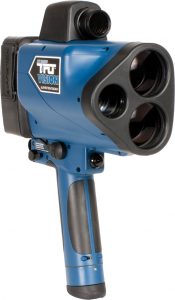 Clocking speeders with the Laser Technology Inc. 20/20 TruVISION laser is not only reliable and user-friendly, but its data storage capabilities also serve for accurate recordkeeping. AdapTec automatically adjusts for clear image capture as far away as 450 feet. Multiple zooming options home in on license plates, which can then be paired with the company’s Automatic Number Plate Recognition tool. Operators will appreciate color-coded graphic icons on the touch screen as well as buttons. The photo/video laser can be either handheld or mounted on a tripod. MSRP $6,995.
Clocking speeders with the Laser Technology Inc. 20/20 TruVISION laser is not only reliable and user-friendly, but its data storage capabilities also serve for accurate recordkeeping. AdapTec automatically adjusts for clear image capture as far away as 450 feet. Multiple zooming options home in on license plates, which can then be paired with the company’s Automatic Number Plate Recognition tool. Operators will appreciate color-coded graphic icons on the touch screen as well as buttons. The photo/video laser can be either handheld or mounted on a tripod. MSRP $6,995.
Get more information on this product ->

From traffic violations to major investigations, there’s always a report to file. The Mark43 Records Management System offers agencies an opportunity to organize, analyze and retrieve reports and related files with greater efficiency. The system provides standard reports and office programs, but also operations for investigative cases, including a dashboard for case tracking, full case audit history and an active master entity sync. Specialized functions have been written for booking and jail, including configurable holding areas and intake questionnaires as well as personnel tracking. To ensure proper chain of evidence, the Mark43 system includes a mobile app for barcode scanning and ID capture, and it automatically generates a custodial property report. MSRP varies.
Get more information on this product ->
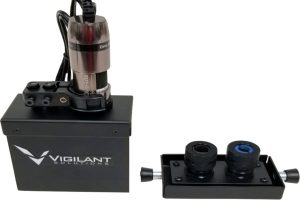 Forget about waiting days or even weeks for ballistics reports. The BallisticSearch Image Capture Station from Vigilant Solutions gets the process started at the scene. The compact (less than 8 inches tall), lightweight (a mere 1.34 pounds) device can go just about anywhere an internet connection can be secured. While onsite, the BallisticSearch Image Capture Station creates 5 MP ultra-sharp, multi-angled 3D models of discharged cartridge cases. Then users can initiate a comparison against the BallisticSearch nationwide gallery. MSRP unavailable.
Forget about waiting days or even weeks for ballistics reports. The BallisticSearch Image Capture Station from Vigilant Solutions gets the process started at the scene. The compact (less than 8 inches tall), lightweight (a mere 1.34 pounds) device can go just about anywhere an internet connection can be secured. While onsite, the BallisticSearch Image Capture Station creates 5 MP ultra-sharp, multi-angled 3D models of discharged cartridge cases. Then users can initiate a comparison against the BallisticSearch nationwide gallery. MSRP unavailable.
Get more information on this product ->
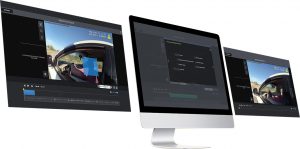 It’s great when the public pitches in with tips, information and digital files such as photos, videos and messages. But those requests can be a lot to sort through. The Axon Citizen evidence collection system streamlines the process. From the field, invite witnesses to submit their media via the Axon Capture mobile app, compatible with Android and iOS devices. As soon as the files are received, the program initiates a virus screening, then instantly categorizes them, ensuring searchability, and stores them in Evidence.com. An audit trail tracks officer identification, incident, time, place and community member. MSRP unavailable.
It’s great when the public pitches in with tips, information and digital files such as photos, videos and messages. But those requests can be a lot to sort through. The Axon Citizen evidence collection system streamlines the process. From the field, invite witnesses to submit their media via the Axon Capture mobile app, compatible with Android and iOS devices. As soon as the files are received, the program initiates a virus screening, then instantly categorizes them, ensuring searchability, and stores them in Evidence.com. An audit trail tracks officer identification, incident, time, place and community member. MSRP unavailable.
Get more information on this product ->
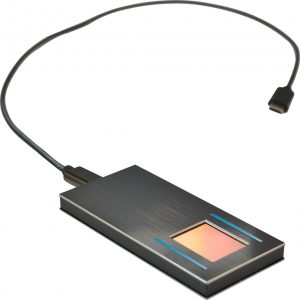 The newly released Nomad 30 Pocket Reader from Crossmatch allows law enforcement professionals to scan fingerprints at the scene with capacitive thin-film transistor technology for rapid identification. A bright blue indicator light and haptic feedback confirm effective operation. Its lightweight design makes for easy one-handed handling, which enables users to maintain safe distances from suspects and limit contact. It is FAP 30 PIV certified and programmed to interface with the Crossmatch ArcID Mobile app with a USB connection. MSRP $250.
The newly released Nomad 30 Pocket Reader from Crossmatch allows law enforcement professionals to scan fingerprints at the scene with capacitive thin-film transistor technology for rapid identification. A bright blue indicator light and haptic feedback confirm effective operation. Its lightweight design makes for easy one-handed handling, which enables users to maintain safe distances from suspects and limit contact. It is FAP 30 PIV certified and programmed to interface with the Crossmatch ArcID Mobile app with a USB connection. MSRP $250.

Get more information on this product ->
 Never underestimate the importance of dependable radio contact. The Harris XL-185P Portable converged LTE land mobile radio is capable of utilizing a variety of frequencies, including VHF, UHF, 700/800 or 900 MHz, to ensure optimal connections. It’s open standards-based, Verizon certified and Band-14 ready. Advanced noise cancellation keeps interference to a minimum, and the instant recall-and-replay option makes sure you don’t miss calls. The radio’s shell is a ruggedized aluminum that meets a number of industry standards, including for explosive atmospheres and contamination by fluids. MSRP unavailable.
Never underestimate the importance of dependable radio contact. The Harris XL-185P Portable converged LTE land mobile radio is capable of utilizing a variety of frequencies, including VHF, UHF, 700/800 or 900 MHz, to ensure optimal connections. It’s open standards-based, Verizon certified and Band-14 ready. Advanced noise cancellation keeps interference to a minimum, and the instant recall-and-replay option makes sure you don’t miss calls. The radio’s shell is a ruggedized aluminum that meets a number of industry standards, including for explosive atmospheres and contamination by fluids. MSRP unavailable.

Get more information on this product ->

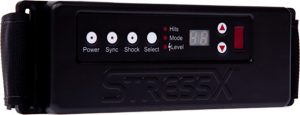
For simulated training to be effective, situational conditions must be as realistic as possible, and that includes participants realizing if and when they’ve been hit. That’s why SBTactical developed the irVest and StressX Belt combination. The training vest incorporates 10 sensors to detect if the wearer has been hit during simulated scenarios. The StressX Belt takes that data and, in real time, delivers a noticeable shock. That instantaneous acknowledgement empowers individuals to quickly assess circumstances and practice decision-making under mental and physical stress. MSRP $895 each.

Get more information on this product ->
 Ask any computer engineer or IT expert what’s going to be the next great technological development and almost unanimously they’ll say artificial intelligence (AI). In fact, they’ll say AI is already making an impact, and Veritone’s aiWARE is evidence of how it’s assisting law enforcement departments. The AI system can search different data and sources by face, objects, spoken word, logos and other recognizable factors. It can speed up identification from previous video recordings and arrest photos, as well as catalog metadata and structured datasets. Another key feature is secured multi-agency collaboration of digital evidence. MSRP varies.
Ask any computer engineer or IT expert what’s going to be the next great technological development and almost unanimously they’ll say artificial intelligence (AI). In fact, they’ll say AI is already making an impact, and Veritone’s aiWARE is evidence of how it’s assisting law enforcement departments. The AI system can search different data and sources by face, objects, spoken word, logos and other recognizable factors. It can speed up identification from previous video recordings and arrest photos, as well as catalog metadata and structured datasets. Another key feature is secured multi-agency collaboration of digital evidence. MSRP varies.

Get more information on this product ->
See this story in the Summer 2018 FOP Journal issue.
Line-of-Duty Deaths: The Whole Picture

Each year, hundreds of law enforcement deaths are classified as line-of-duty deaths (LODDs). Although we understand that ours can be a deadly occupation, no one wants to see any of these losses occur. Not all LODDs are felonious, but each one has a farther-reaching impact than the public may realize. Often these deaths cause questioning of departmental policies, officer safety protocols, training, local crime, racial concerns and other issues. This article will examine various contributing factors to these deaths and how agencies can take steps to mitigate them, as well as discuss how LODDs affect departments, communities, legislators and families.
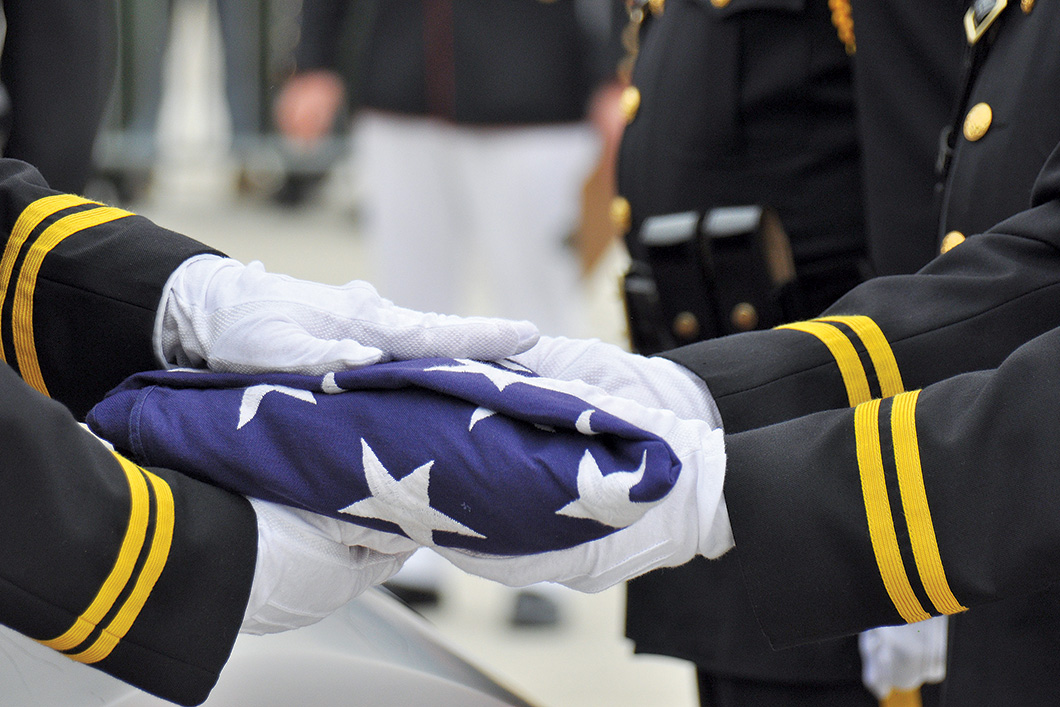
The definition of an LODD may vary throughout the U.S., both anecdotally and legally when it comes to paying benefits. For this article, an LODD is the loss of an officer by felonious, accidental or natural causes. Some may also place suicides under this definition. When examining the facts behind these deaths, authors often use numbers, percentages and other quantifiable information that tends to confuse and distract people from the actual problem. Concepts that further exacerbate these discussions are correlational and causational facts. Simply because two or more events occurred at the same time (correlational) does not mean that one event caused the other to occur (causational). Also, quantitative data is often used without the associated qualitative data, which, when combined with media outlets reporting on unverified information, typically leads to the public being misled on the facts.
Trusted information on LODDs can be found from a variety of sources, including the National Law Enforcement Officers Memorial Fund, the International Association of Chiefs of Police, the Officer Down Memorial Page, and the Law Enforcement Officers Killed and Assaulted Program of the Federal Bureau of Investigation. However, the intent of this article is not to argue percentages or numbers, but to bring awareness to the causes and possible solutions to the problems. While the majority of reported LODDs are caused by gunfire, auto crashes and job-related illness, the pain and anguish they create radiates through the community at different levels. This suffering is especially deep for those who are directly affected, such as the officer’s family, close friends and colleagues. There are also those who are indirectly affected, such as the community and government officials.

When does “duty” stop or start? Do all LODD policies cover the officer who is coming to work or going home?
Although the differences between the major types of LODDs are obvious to most, they raise thought-provoking questions that may suggest changes in an agency’s procedures.
Felonious cause: The leading cause of death in this category is gunshots, which may be difficult to reduce even with some of the best training available. Because a subject’s true intent varies in each situation, an officer’s problem-solving abilities are put to the test. When this type of death occurs, one of the first results is a review of the tactics, techniques, policies and training the department has in place. Except for ambushes, most felonious deaths involve a chance to make a conscious decision to change the outcome of the scenario. While blame lies with the suspect, simply falling back on the mentality of “Bad people just do bad things” cannot prevent future losses. Agencies should ensure that officers are not failing to de-escalate, or even escalating, situations. Are there officers who tend to constantly be involved in use-of-force incidents? What kind of protocols are followed? Emotionally charged calls can get the best of an officer, but the ability to manage those emotions is one of the many attributes that separate them from the public. The key here is why officers may unconsciously or consciously escalate situations. Have they become complacent? Are they overthinking the situation or dealing with issues at home that prevent them from fully thinking about their responsibilities?
Accidental causes: Automobile crashes lead this category and can be a result of numerous reasons, but in most cases, they are totally avoidable. Yes, the urge and necessity of aiding a fellow officer or responding to a high-priority call is vital. However, if the responding officer does not make it to the call alive, did they really help? This scenario has happened plenty of times. This is where a supervisor is best utilized as an objective voice to reassure responding officers of the need to arrive alive. Do officers attend in-service scenario training involving driving vehicles? Why is this assessment and teaching of techniques so important at the academy level, but not throughout the officer’s career as bad habits are formed?
Natural causes: Preexisting health conditions that no one was apparently aware of, even the officer, are the main problem here. This scenario questions the department and the individual officer as to their true level of medical readiness for duty. There is no difference in liability between putting an officer on the street who is not tactically ready and an officer who is not medically ready. Are agencies providing annual physicals with sound metrics to identify possible medical problems? Medical screening was obviously important when officers reported to the basic academy, so was that just for the sake of liability? Please note that being physically fit and medically ready are not the same. A pending arterial blockage to the heart is not readily identifiable by a fitness test alone. Although not everyone is motivated to obtain a thorough annual physical, being made aware of unforeseen health problems is priceless. I recall a colleague in my department who was not enthusiastic to take his annual medical screenings; however, when he was diagnosed with prostate cancer, he had a new perspective. Fortunately, early diagnosis and treatment were both beneficial.
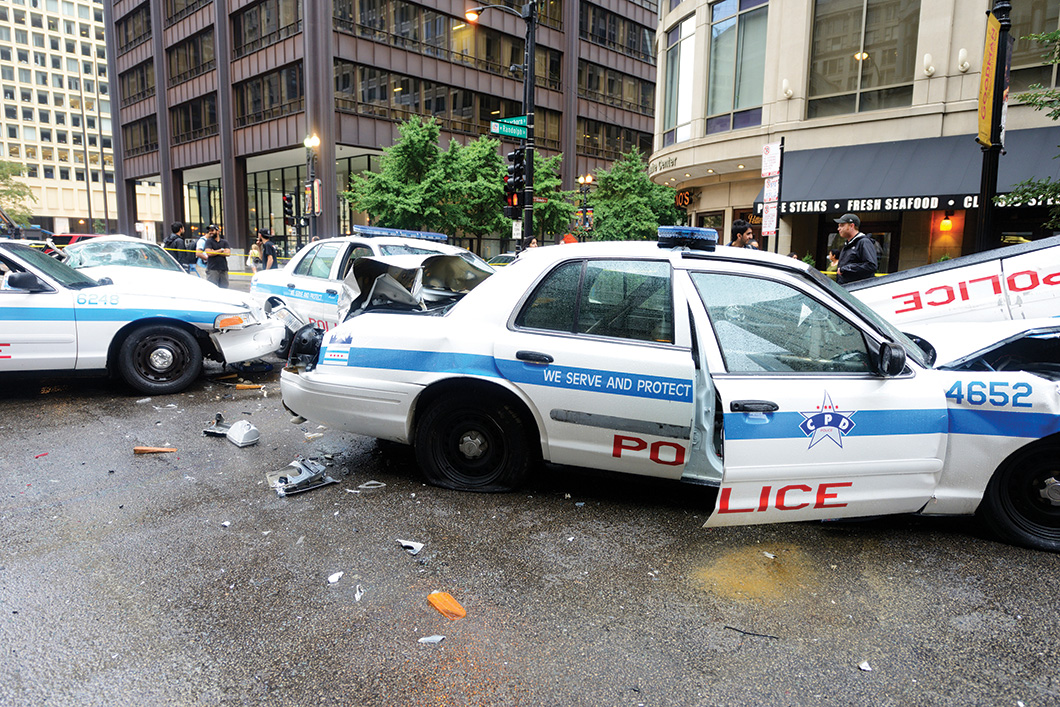
What impact do LODDs have on a community? At the operational and strategic level, administrators, the mayor and other local officials must deal with the legal issues as well as the personal emotions of an LODD. In a felonious death, officials also must ensure that the community feels safe. In some cases, state legislators become involved, not only by offering condolences but by creating changes to legislation concerning law enforcement deaths — for example, increasing penalties for those who kill police or expanding benefits for surviving families.
At the fundamental level, the impact an LODD has on colleagues, close friends and especially the family of the fallen officer is significant. An agency loses an officer and while their position can be refilled, the person cannot be replaced. Fellow officers experience a roller coaster of emotions when an LODD occurs, occasionally pondering the realization of how dangerous the job can be and that the next time it may be them. FOP member Adam Rosenberg (Connecticut Lodge #33), a sergeant with the Connecticut State Police, shares that the CSP sends a notification to the entire agency about the death, placing important emphasis on the need to take care of the family and for troopers to take care of themselves. Rosenberg highlighted the recent death of a fellow trooper in March 2018, which sent shockwaves through the department: “When a trooper with over 19 years of service dies, so close to being eligible to retire, and has young children, it’s devastating.”
All this grief is real and long-lasting, but too often the fallen officer’s family can get lost in the chaos. They are the ones who live with this daily loss and cope with the absence of their loved one. The spouse may now be faced with raising children alone, and the children struggle to deal with losing a parent too early. The family fights through various stages of grief to create some normalcy in their lives. What is being done for them? How do other officers make sure that the family is receiving the help they need (financially, emotionally and psychologically)? Is there a constant and concerted effort to ensure that those families always feel part of the law enforcement family? Are families and officers provided mental health care after traumatic events? Is a departmental chaplain or psychologist available to them? FOP member Ralph Hoffman (Florida Lodge #33), a retired Nassau County Police detective lieutenant, recalls how his department provided this type of assistance: “Our Employee Assistance Office was where officers or their families could speak with licensed psychologists about individual or family problems. The service was free, anonymous and really helpful to a lot of people in the department.” Hopefully all agencies have this type of service readily available for their officers in the event that tragedy strikes unexpectedly.
Proactively, how many chiefs have an “all call” with families? This is where the chief can have an open dialogue with families without the officers present. Hosting this type of event regularly (such as biannually) provides an open environment where concerns or recent events in the department are addressed, and allows spouses to understand the occupation. It also opens the door to discussing home life and the stress associated with the occupation. Spouses can be great resources to understand the stressors of law enforcement and its impact on the family. A discussion of ideas and possibilities to mitigate stress at the family level is always beneficial. Maybe the family does not understand the job or their spouse’s role and they want clarification. Maybe the spouse is noticing changes in the officer at home and wants to seek help for something the officer would not do on their own. An open relationship with the chief can help facilitate solutions to these problems.
What about officers who have survived a near-death experience and are dealing with post-traumatic issues, or just the ups and downs of life? Psychological health is just as important as physical health, if not more important, but is it a topic emphasized in agencies? Failing to successfully cope with the “trifecta of stress” (operational, organizational and personal stressors) can adversely affect one’s psychological health. This cluttered mind, with no clear thought process, can exacerbate complacency and lead to horrific outcomes. However, people do not always possess self-awareness, especially when contending with their own stressors, so it takes a colleague or friend to intervene when they see these abnormal behaviors. While most will be in denial that anything is wrong, those behaviors could lead to, or be early signs of, suicidal ideation. Therefore, remember that it requires the collective effort of each agency to recognize and address their own strengths and weaknesses in order to improve overall operations.
Dr. Michael B. Fortney has been with the FBI for over 20 years, working as a police officer and then in the intelligence and biometric fields. His military experience includes 10 years as an enlisted infantry Marine and a naval intelligence officer. He has also served as an adjunct lecturer at West Virginia University. Dr. Fortney holds a bachelor’s degree in criminal justice, a master’s in business administration and a Ph.D. in psychology, and graduated from the 222nd class of the FBI National Academy. He is a member of the Fraternal Order of Police, the FBI National Academy Associates and the American Psychological Association.

FOP Memorial photos courtesy of Lynn Cronquist. See this story in the Summer 2018 FOP Journal issue.
Saluting the Fallen: Police Week 2018
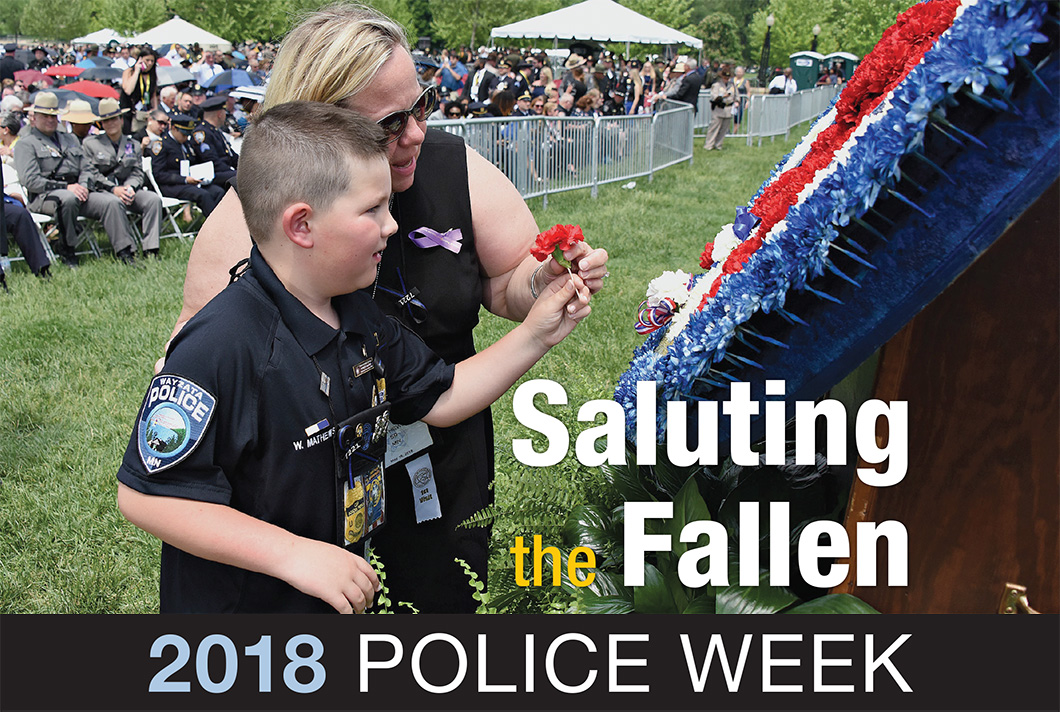
| ARIZONA Paul LazinskyARKANSAS Timothy A. Braden Keith B. Bradford Sr.* Kevin C. Mainhart Patrick N. Weatherford CALIFORNIA COLORADO DELAWARE FLORIDA GEORGIA ILLINOIS INDIANA IOWA KENTUCKY LOUISIANA MAINE MARYLAND MICHIGAN MINNESOTA MISSISSIPPI MISSOURI MONTANA NEBRASKA NEVADA NEW JERSEY NEW MEXICO NEW YORK |
NEW YORK (continued) Matthew J. Gay* Charles G. Gittens Jr.* Michael E. Glazer* Charles R. Gunzelman* Kevin M. Haverly Demetrias Hopkins* Wayne A. Jackson* Cheryl D. Johnson* Robert J. Johnson Robert W. Kaminski* Charles M. Karen* Stephen T. Kubinski Craig E. Lehner Luis A. Lopez* Shaun M. Mahoney* Steven D. McDonald Denis R. McLarney* James W. Monahan* Robert A. Montanez* Dennis Morales* Patrick P. Murphy* Edmund P. Murray* Terrence S. O’Hara Donald J. O’Leary Jr.* Louis R. Pioli* Michael V. Quinn* Ronald A. Richards* Peter O. Rodriguez* Kenneth W. Rosello* John A. Russo* Jacqueline C. Schaefer* Marci Simms* Andrew L. Siroka* Harold J. Smith* Scott V. Stelmok* Traci L. Tcak-Czajkowski*NORTH CAROLINA Meggan L. Callahan Veronica S. Darden Jay R. Memmelaar Jr. Wendy L. Shannon Justin J. Smith NORTH DAKOTA OHIO OKLAHOMA OREGON PENNSYLVANIA SOUTH CAROLINA TENNESSEE TEXAS VIRGINIA WASHINGTON WEST VIRGINIA WISCONSIN WYOMING FEDERAL PUERTO RICO |
*The officer’s death occurred in a previous year but was determined to be a line-of-duty death in 2017.
Photos courtesy of Lynn Cronquist. See this story in the Summer 2018 FOP Journal issue.
Ready to Roll

 You can’t avoid obstacles in the roadway if you can’t see them, especially in the dark of night. FLIR’s updated PathFindIR II utilizes thermal imaging to detect and reveal cloaked objects four times faster than standard automobile headlights. Through a partnership with Autoliv, this newest model has incorporated a nighttime pedestrian detection feature that can be used to automatically display alarms when it senses a person in or near the vehicle’s path. MSRP starts at $2,495.
You can’t avoid obstacles in the roadway if you can’t see them, especially in the dark of night. FLIR’s updated PathFindIR II utilizes thermal imaging to detect and reveal cloaked objects four times faster than standard automobile headlights. Through a partnership with Autoliv, this newest model has incorporated a nighttime pedestrian detection feature that can be used to automatically display alarms when it senses a person in or near the vehicle’s path. MSRP starts at $2,495.
Get more information on this product ->
 Squad cars house a variety of gear that needs to be within reach, which can make for a crowded interior. Making space is the purpose of Gamber-Johnson’s Ford PI Utility Short Console Box Kit. Mount a computer to the top and offset the position to allow for a convenient and comfortable posture. USB and MP3 knockouts are located on the passenger side, along with four 12-volt knockouts. A low-profile section holds radio control heads and small devices while a vertical angled section can contain full-sized radios. It even comes with a cup and pen holder. MSRP $969.
Squad cars house a variety of gear that needs to be within reach, which can make for a crowded interior. Making space is the purpose of Gamber-Johnson’s Ford PI Utility Short Console Box Kit. Mount a computer to the top and offset the position to allow for a convenient and comfortable posture. USB and MP3 knockouts are located on the passenger side, along with four 12-volt knockouts. A low-profile section holds radio control heads and small devices while a vertical angled section can contain full-sized radios. It even comes with a cup and pen holder. MSRP $969.
Get more information on this product ->
 Versatility can be a key strategic advantage, such as when an unmarked car suddenly needs to notify others of its presence. XStream I is an interior mounting warning light by Federal Signal and can be placed according to driver preferences, including the dash, headliner or as a window mount. It’s available as a single or dual-head model, each equipped with a light head, two suction cups, bail and pivot brackets, and mounting hardware. XStream I also features Federal Signal’s Solaris LED reflector and SpectraLux multicolor LED technology. Additionally, operators can choose from 25 flash patterns. MSRP unavailable.
Versatility can be a key strategic advantage, such as when an unmarked car suddenly needs to notify others of its presence. XStream I is an interior mounting warning light by Federal Signal and can be placed according to driver preferences, including the dash, headliner or as a window mount. It’s available as a single or dual-head model, each equipped with a light head, two suction cups, bail and pivot brackets, and mounting hardware. XStream I also features Federal Signal’s Solaris LED reflector and SpectraLux multicolor LED technology. Additionally, operators can choose from 25 flash patterns. MSRP unavailable.
Get more information on this product ->
 MOUNTED FOR DUTY
MOUNTED FOR DUTYLaw enforcement vehicles pull double duty as mobile computer stations. The Havis Products Vehicle Specific Console With Internal Printer Mount keeps laptops secured under a variety of driving conditions and situations. Designed for either the 2015–2018 Chevrolet Tahoe Police Pursuit Vehicle or the 2015–2018 Chevrolet Suburban, the single-piece console measures 13 inches wide and accepts standard Brother PocketJet 6 and 7 printers. Two 12-volt sockets with wire and fuse are mounted to the front top panel. The console also includes an internal front electrical equipment mounting shelf. If necessary, the shelf’s side trim panels can be removed to allow additional access. MSRP $555.11.
Get more information on this product ->
 STASH & CARRY
STASH & CARRYSturdy doesn’t have to mean heavy. Released this past summer, the Pelican Air Case line is 40% lighter than its predecessors. Molded out of lightweight, next-generation HPX resin, these protective cases can hold a cadre of items of varying weights and sizes. Choose from nine travel-ready sizes, or customize it to fit your needs. Use the versatile TrekPak Divider system of waterproof, closed-cell-foam-laminated corrugated panels to create compartments. Or add Classic Pick N’ Pluck Foam to cushion gear. The cases have been roll-tested over 900 meters, and are crush- and dust- proof. MSRP $216.02–$367.28.
Get more information on this product ->
 LIGHT TO GO
LIGHT TO GOWith 2,800 lumens, the new Whelen Pioneer LiFe 28 super-LED portable area light can brighten the darkest environments. Operators can alternate between the floodlight lens and the 8-degree TIR spotlight. An adjustable ratcheting mechanism allows users to create a 180-degree range. The built-in lithium ion phosphate battery engages LiFePO4 technology, and has been shown to produce more than two hours at full intensity and up to five hours in battery saver mode. According to tests, the battery reaches full charge in three to four hours and is rated for more than 2,000 charging cycles. MSRP $1,225.
Get more information on this product ->
 BALLISTIC BARRIERS
BALLISTIC BARRIERSWhether sitting behind the wheel or using the car door as a shield, you want assurance that it will prevent bullets from penetrating. The ‘B’-Kit Vehicle Door Armor by Hardwire Armor Systems’ Vehicle Armor division adds a layer of ballistic protection to exteriors. The patented design secures officers from lethal force of a 12-gauge slug as well as lessening the potential impact in a crash. The companion Transparent Window Insert extends that ballistic barrier. MSRP $993; Door & Window Insert Package $2,328.
 Get more information on this product ->
Get more information on this product ->
 SAFE TRANSPORT
SAFE TRANSPORTIt’s a K-9 officer’s duty to keep their four-legged partner safe, including while riding in the car. The newly improved K9 Containment Insert from Owens Products, an officer-owned company, was specifically designed with feedback from experienced K-9 professionals. The insert allows the animal extra safety. For example, the .125 mill-finished aluminum floor pan runs the entire width, from door to door, to avoid gaps or seams where paws or legs could get trapped. The front door slides for easy operation and is secured with a stainless steel latching handle. Both front and rear panels contain 1-inch holes so the driver’s view remains unobstructed. MSRP $1,876.

Get more information on this product ->
 POWER PLAY
POWER PLAYEngineers at Lind Electronics designed the Auto Power Adapter to work with most computers and boost performance while it’s charging in the car. It accepts input voltages from 11-16 volt DC or 12-volt DC sources. The DC jack accommodates either a cigarette lighter input cable or a bare wire (stripped and tinned) input cable. It also offers output short-circuit, overcurrent and internal over-temperature protections. Customizable options are available. The adapter comes with a three-year warranty, which covers failures and replacement of missing or damaged cables with snap-in connections. MSRP $99.95–$139.95.

Get more information on this product ->
Read this story in the Spring 2018 issue of FOP Journal.
Follow the Money

Figuring out how criminals conduct business is a key part of investigations. Tracking down identity thieves, money launderers, organized crime groups and many other offenders requires detectives to trace transactions and decipher the intricacies of finance. However, more than half of the law enforcement agencies surveyed by PricewaterhouseCoopers in 2016 stated that they lacked the personnel with the appropriate skills to investigate and prosecute economic crimes.
Therefore, officers who combine accounting expertise with their policing and investigative experience can multiply their professional opportunities with local departments, state and federal agencies, and even in the private insurance and financial sectors as fraud investigators. “From the law enforcement side, you have already built skills in investigation with people and understand what courts are looking for,” says FOP member Jesse Gossman, a detective in the Fort Lauderdale Police Department economic crimes unit who earned a master’s degree in accounting from Florida Atlantic University in 2017. “That really helps when investigating fraud. It’s not just about numbers; you have to interview people and be able to read them.”
For knowledge that can earn career dividends, check out these higher-education programs.
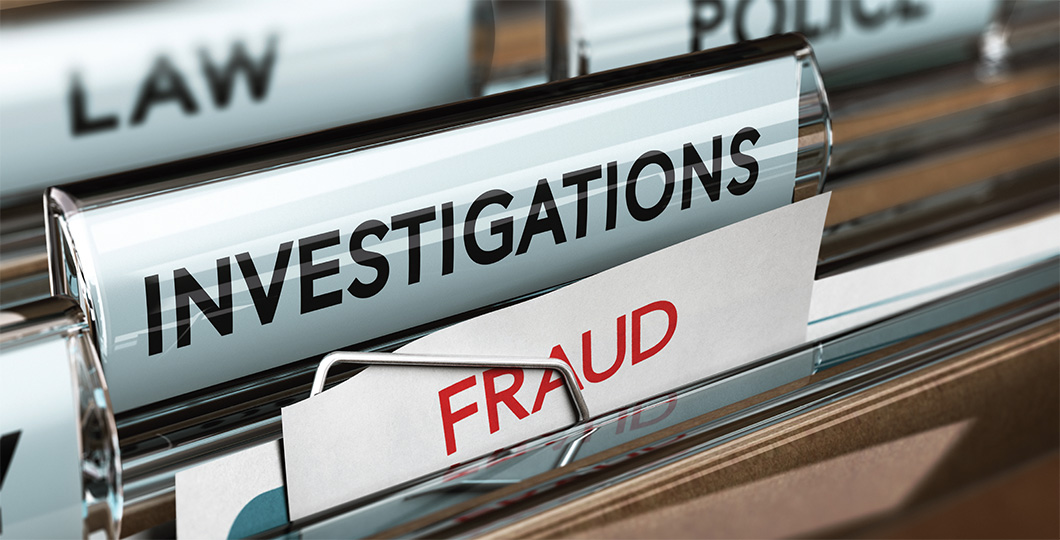
www.utica.edu
Degree: Bachelor of Science in Fraud and Financial Crime Investigation
Course sampling: Economic Crime Theory; Corruption and Organized Crime
Key components: Utica is one of the first universities in the nation to offer a full undergraduate degree in fraud and financial crime investigations (FCCI). The program’s interdisciplinary structure combines criminal investigation, accounting and computer skills. Participants can select between fraud prevention and detection or financial investigation concentrations.
Faculty insight: “[This] program is one of the few criminal justice-oriented programs that is designed to equip graduates with the skills to investigate criminal and civil offenses in the area of ‘white collar’ crime in both public and private sectors.” — Don Rebovich, Ph.D., coordinator, FFCI Programs
 www.uiu.edu
www.uiu.edu
Degree: Bachelor of Science in Accounting
Course sampling: Federal Taxation; Auditing
Key components: Before you can chip away at the financial details of a case, you first have to understand the language and systems standard to the accounting profession and financial institutions. That’s the focus of an accounting major at Upper Iowa University. Classes are available at the Fayette campus and select education centers, as well as online and through a self-paced degree option.
Faculty insight: “Law enforcement professionals add value to the classes because they have the real-world experience that serves as a teaching lesson to us all. They have seen and dealt with the issues that forensic accountants evaluate and investigate in the business world.” — Dana Leland, Ph.D., adjunct instructor
www.fau.edu
Degree: Executive Master of Accounting with Concentration in Forensic Accounting
Course sampling: Interviewing for Forensic Accountants and Auditors; Advanced Accounting Information Systems
Key components: In this two-year online program, field-experienced faculty delve into fraud, litigation support, money laundering investigation and expert testimony. Applicants must hold a bachelor’s degree, but 10% of current students are CPAs.
Faculty insight: “I use case studies I actually worked on. I have them look at what the accounting produced and violated, and then look at the external controls and analyze what the people involved believed.” — Jay Leiner, CFE, Ph.D., professor and FOP member (Florida Lodge #32)
www.webster.edu
Degree: Master’s in Forensic
Accounting
Course sampling: Legal Procedure, Substantive Law and Professional Ethics in Forensic Accounting; Special Topics in Litigation Accounting
Key components: The program consists primarily of evening classes at Webster’s St. Louis campus. Coursework covers many of the legal elements of forensic accounting, including procedures and analytics, in addition to functional aspects, such as auditing and valuation.
Faculty insight: “This is a comprehensive program. Part of the program is to apply forensic practices, not just going over accounting theory.” — Rich Dippel, JD, MBA, CPA, Business Department chair and associate professor
 www.tiffin.edu
www.tiffin.edu
Degree: Bachelor in Accounting or Criminal Justice with Forensic Accounting Minor
Course sampling: Analysis of the Accounting Process; Accounting Information Systems
Key components: In this cross-functional minor for both accounting and criminal justice majors, accounting students examine legal and investigative procedures, while criminal justice students gain a better understanding of transactional practices. As a criminal justice instructor and detective sergeant with the Seneca County Sheriff’s Department, FOP member Donald Joseph is a regular guest speaker in classes. “I explain how to do a timeline presentation to prosecutors. I also show what documents are needed and how search warrants are utilized,” he says.
Faculty insight: “The goal is for more people to get into investigative-related areas with financial fraud.” — Rhonda Gilreath, assistant professor of accounting
 www.pnw.edu
www.pnw.edu
Degree: Graduate Certificate in Forensic Accounting and Fraud Investigation
Course sampling: Fraud Data Analysis; Advanced Fraud Investigation
Key components: Applicants must hold an undergraduate degree and have completed at least one introductory accounting course. Enrollees must pass four graduate courses that address both legal procedures and fraud prevention.
Faculty insight: “My favorite course to teach is the data analysis course because it allows me to demonstrate to my students how software can assist forensic investigators in their work.” — Maureen Francis Mascha, Ph.D., CPA, associate professor of accounting and Forensic Program coordinator
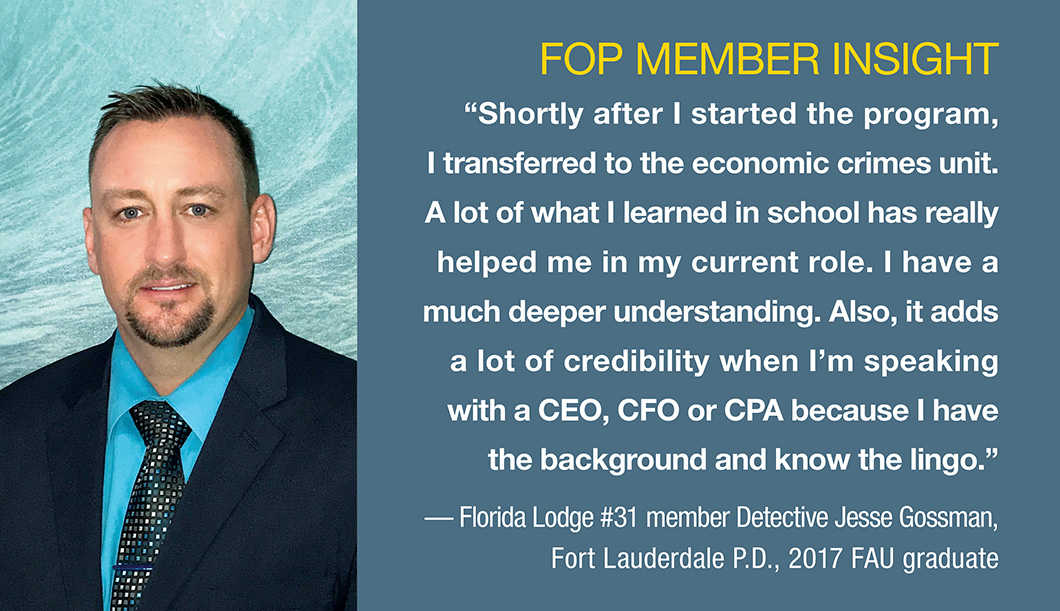
Click here for further insights from FOP member Jesse Gossman about the benefits of studying forensic accounting.
Read this story in the Spring 2018 issue of FOP Journal.
Member Interview: Forensic Accounting
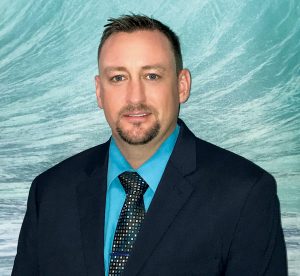 After Detective Jesse Gossman earned his bachelor’s degree in public safety administration, he knew he wanted to take his education to the next level. However, he wasn’t sure a traditional path in criminal justice or law school was in his future. Instead, the detective wanted to study a subject that would broaden his career possibilities, both within and outside of law enforcement.
After Detective Jesse Gossman earned his bachelor’s degree in public safety administration, he knew he wanted to take his education to the next level. However, he wasn’t sure a traditional path in criminal justice or law school was in his future. Instead, the detective wanted to study a subject that would broaden his career possibilities, both within and outside of law enforcement.
“When it came time to look at graduate programs, I wanted to see what’s out there to further my interests and give me the most options,” says Gossman, member of Florida Lodge #31 and a 10-year veteran with the Fort Lauderdale Police Department.
With that as his motivation, Gossman decided to expand on his interest in financial crimes and graduated in August 2017 with an executive master of accounting with a concentration in forensic accounting from Florida Atlantic University (FAU).
Why did you choose FAU?
FAU is local and I liked the aspect that you can attend courses in person [because] I learn better when I’m in classes in person. Also, it was nice that it was flexible with my schedule changing. I knew I didn’t want to be penalized if I couldn’t make it to class. They allow you to view the courses and lectures online and have the option to show up to class.
What were your favorite courses?
I enjoyed the federal tax course because they’re similar to reviewing laws. Tax codes are similar to looking at criminal statutes and I can apply my experience.
In your opinion, what is the relationship between accounting and law enforcement?
I think the skill set accountants have is that they understand the numbers, but that doesn’t necessarily translate into investigations. Accountants have to build skills with people and investigation skills as well as with the legal side and what is expected in the courtroom. That’s foreign to accountants. From the law enforcement side, it’s the opposite. You have already built skills in investigation with people and understand what courts are looking for. That really helps when investigating fraud. It’s not just about numbers; you have to interview people and be able to read them.
Have you been able to apply what you learned to the job?
Shortly after I started the program, I transferred to the economic crimes unit. A lot of what I learned in school has really helped me in my current role. I have a much deeper understanding. Also, it adds a lot of credibility when I’m speaking with a CEO, CFO or CPA because I have the background and know the lingo.
Do you think having a background in accounting has made you a better law enforcement professional?
To investigate these crimes, you almost need to have a good accounting knowledge base. You need to be well-versed in IT as well because, from the criminal perspective, everything is digital.
Has the emergence of cryptocurrencies changed how you investigate economic crimes?
Cryptocurrencies are very big, and I think that’s where this is going. You have to keep up on the latest technology. There are always changes and that is one of the issues because, as law enforcement, we’re often behind the power curve.
Do you have any plans for additional education?
I’m hoping to continue on. I have a few credits I need to qualify for the CPA exam.
What advice would you offer law enforcement professionals who might be considering a degree in forensic accounting or fraud investigation?
For people who have a desire, economic crimes is one of the most challenging crimes to investigate because it’s always changing. But educating myself and moving forward is worthwhile.
For more about FAU, plus other forensic accounting and fraud investigation degree programs, read “Follow the Money.”
Springtime Staples
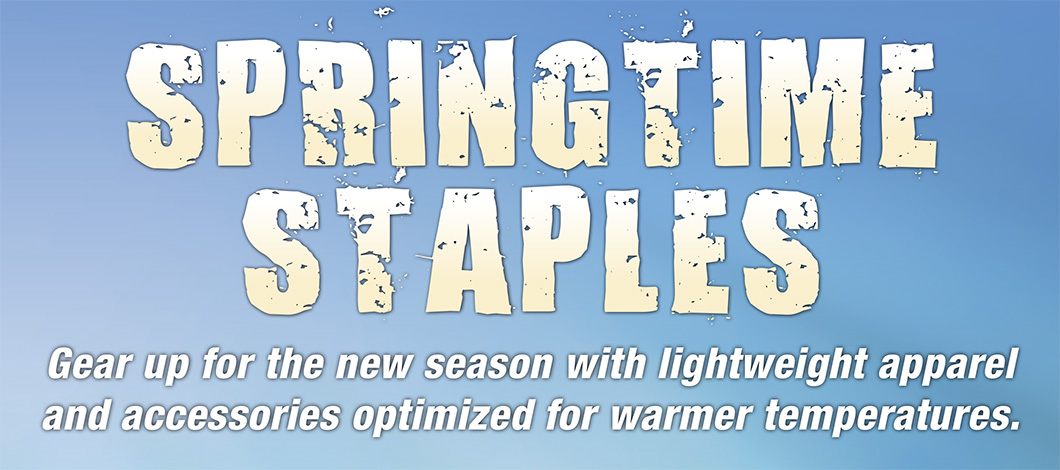
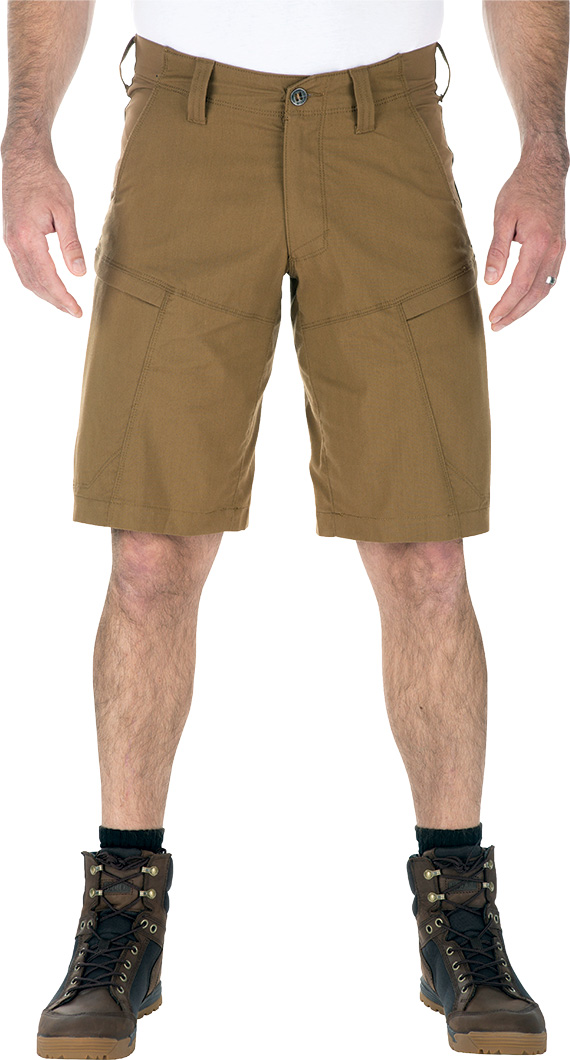 Ideal for tactical, casual or covert wear, 5.11 Tactical’s Apex short is suited to warmer days on duty. Both durable and comfortable, the short is composed of the same 6.4 oz. Flex-Tac mechanical stretch Teflon-treated canvas as its pant counterpart. It also delivers similar functional details, but in a smaller package. There’s ample pocket space and plenty of holders designed for magazines, knives, handcuff keys and other gear. Available in black, TDU green, dark navy, battle brown and khaki. Sizes 28–44. MSRP $69.99.
Ideal for tactical, casual or covert wear, 5.11 Tactical’s Apex short is suited to warmer days on duty. Both durable and comfortable, the short is composed of the same 6.4 oz. Flex-Tac mechanical stretch Teflon-treated canvas as its pant counterpart. It also delivers similar functional details, but in a smaller package. There’s ample pocket space and plenty of holders designed for magazines, knives, handcuff keys and other gear. Available in black, TDU green, dark navy, battle brown and khaki. Sizes 28–44. MSRP $69.99.
Get more information on this product ->
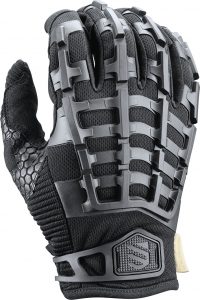 Combining protection and performance, the Fury Prime glove by Blackhawk! is a lightweight and durable option for days when added support is needed for more hands-on duty. The glove is composed of durable synthetic materials, featuring sonic-welded TPR overlay for top-of-hand protection, padding on the thumb and palm to protect against unexpected impact and a silicon grip print on the palm for dexterity. Despite its aggressive and rugged exterior, the glove fits comfortably, like a second skin, and is equipped with touchscreen-compatible fingertips so you can use your cellphone or tablet without having to remove your glove. Available in black, coyote tan and urban gray. Sizes S–XL. MSRP $38.95.
Combining protection and performance, the Fury Prime glove by Blackhawk! is a lightweight and durable option for days when added support is needed for more hands-on duty. The glove is composed of durable synthetic materials, featuring sonic-welded TPR overlay for top-of-hand protection, padding on the thumb and palm to protect against unexpected impact and a silicon grip print on the palm for dexterity. Despite its aggressive and rugged exterior, the glove fits comfortably, like a second skin, and is equipped with touchscreen-compatible fingertips so you can use your cellphone or tablet without having to remove your glove. Available in black, coyote tan and urban gray. Sizes S–XL. MSRP $38.95.
Get more information on this product ->
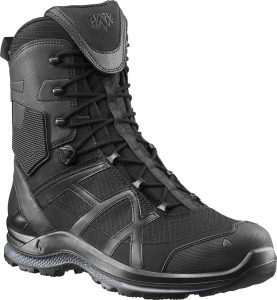
 Being out on patrol is unpredictable. You could be walking your beat one minute and then pursuing a suspect in the next. That’s why it’s important to have reliable, non-bulky footwear suited for any situation. Haix had this in mind when it created its Black Eagle Athletic 2.0 T, a high, side-zip boot that combines the look and feel of a tactical boot with the technology of a running shoe. The result is a highly breathable boot featuring a durable, shock-absorbing heel with built-in support and a special rubber tread design with slip-resistant soles, meaning that you can go from a stroll to a sprint comfortably, without losing your footing. The boot also includes Haix’s Climate System, which keeps feet cool indoors and out. MSRP $169.
Being out on patrol is unpredictable. You could be walking your beat one minute and then pursuing a suspect in the next. That’s why it’s important to have reliable, non-bulky footwear suited for any situation. Haix had this in mind when it created its Black Eagle Athletic 2.0 T, a high, side-zip boot that combines the look and feel of a tactical boot with the technology of a running shoe. The result is a highly breathable boot featuring a durable, shock-absorbing heel with built-in support and a special rubber tread design with slip-resistant soles, meaning that you can go from a stroll to a sprint comfortably, without losing your footing. The boot also includes Haix’s Climate System, which keeps feet cool indoors and out. MSRP $169.
Get more information on this product ->
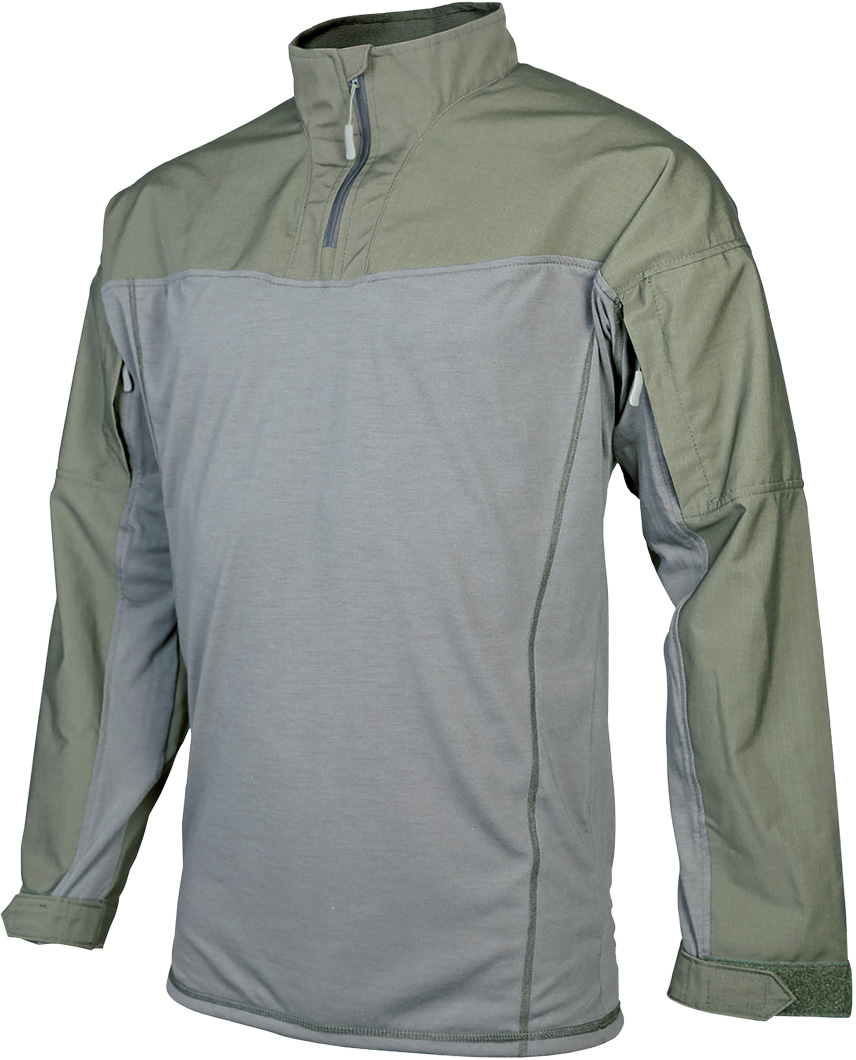
 New to Tru-Spec’s popular 24-7 Series is the Responder Shirt. Long-sleeved and lightweight, it’s constructed of patented drirelease fabric designed to regulate skin temperature, keep the body cool and wick sweat when temperatures rise. The polyester-cotton blend is treated with FreshGuard, a built-in natural odor neutralizer system that prevents bacteria growth and keeps you feeling fresh after long days in the field. Other functional details include durable rip-stop sleeves and yoke for abrasion resistance; vertical, inward-facing zippered pockets on the upper sleeves; and adjustable hook and loop cuffs. The shirt pairs perfectly with the brand’s 24-7 Xpedition pants. Available in black, navy and ranger green. XS–5XL. MSRP $73.95.
New to Tru-Spec’s popular 24-7 Series is the Responder Shirt. Long-sleeved and lightweight, it’s constructed of patented drirelease fabric designed to regulate skin temperature, keep the body cool and wick sweat when temperatures rise. The polyester-cotton blend is treated with FreshGuard, a built-in natural odor neutralizer system that prevents bacteria growth and keeps you feeling fresh after long days in the field. Other functional details include durable rip-stop sleeves and yoke for abrasion resistance; vertical, inward-facing zippered pockets on the upper sleeves; and adjustable hook and loop cuffs. The shirt pairs perfectly with the brand’s 24-7 Xpedition pants. Available in black, navy and ranger green. XS–5XL. MSRP $73.95.
Get more information on this product ->
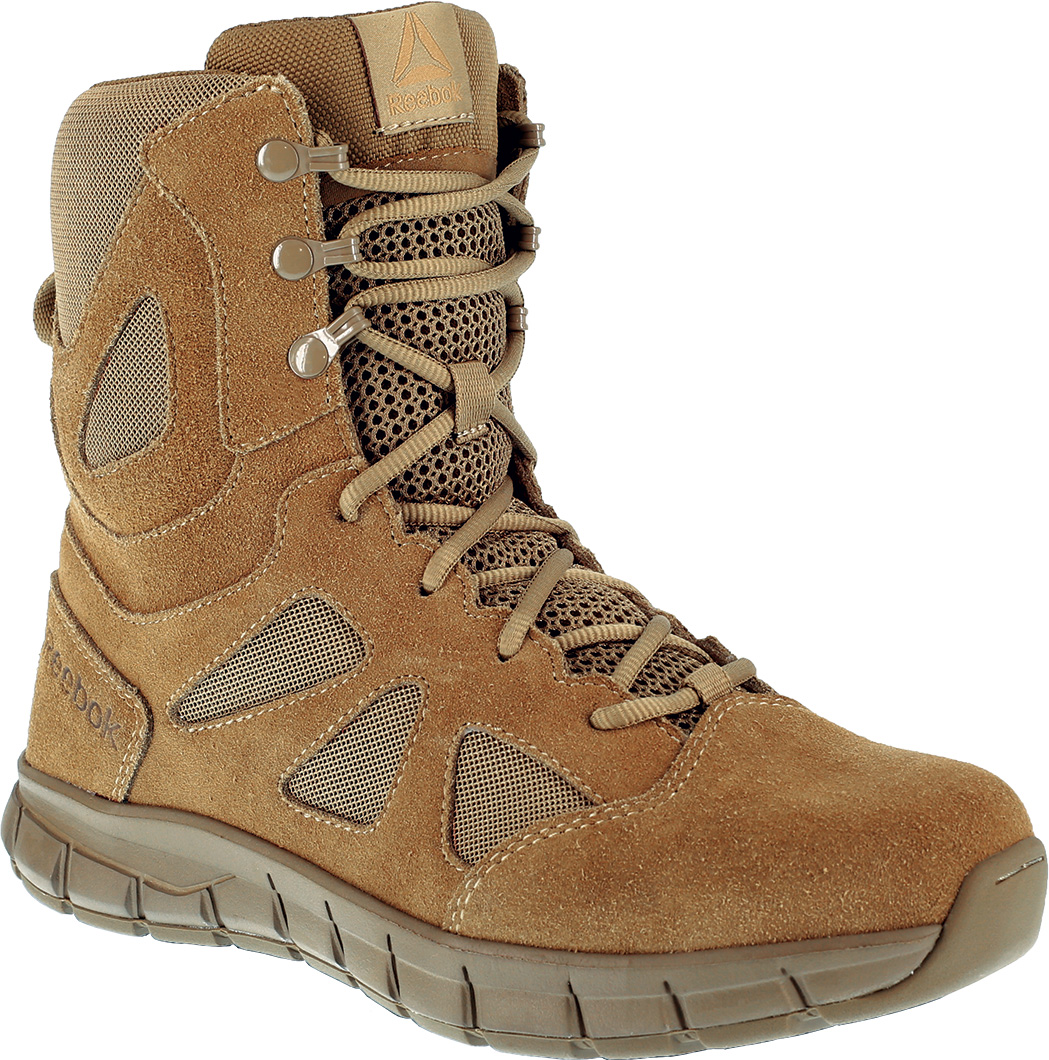 Building on the success of the Reebok Sublite Cushion Tactical series, licensed by Warson Brands, this season the company is introducing its lightweight cushioning technology to military footwear. The new RB8808 tactical boot is available in a coyote brown colorway that meets the Army’s regulations on the wear and appearance of uniforms (AR670-1). Expect the same lightweight and comfortable wear as in previous versions of the boot, made possible by a Sublite foam midsole and MemoryTech massage footbed, but with upgrades. The RB8808 was built with soldiers in mind and features an added lace garage to tuck away laces when blousing pants, a full rubber outsole with rope guard for traction and durability, and an upper made of cattle hide leather for breathability. MSRP $150.
Building on the success of the Reebok Sublite Cushion Tactical series, licensed by Warson Brands, this season the company is introducing its lightweight cushioning technology to military footwear. The new RB8808 tactical boot is available in a coyote brown colorway that meets the Army’s regulations on the wear and appearance of uniforms (AR670-1). Expect the same lightweight and comfortable wear as in previous versions of the boot, made possible by a Sublite foam midsole and MemoryTech massage footbed, but with upgrades. The RB8808 was built with soldiers in mind and features an added lace garage to tuck away laces when blousing pants, a full rubber outsole with rope guard for traction and durability, and an upper made of cattle hide leather for breathability. MSRP $150.
Get more information on this product ->
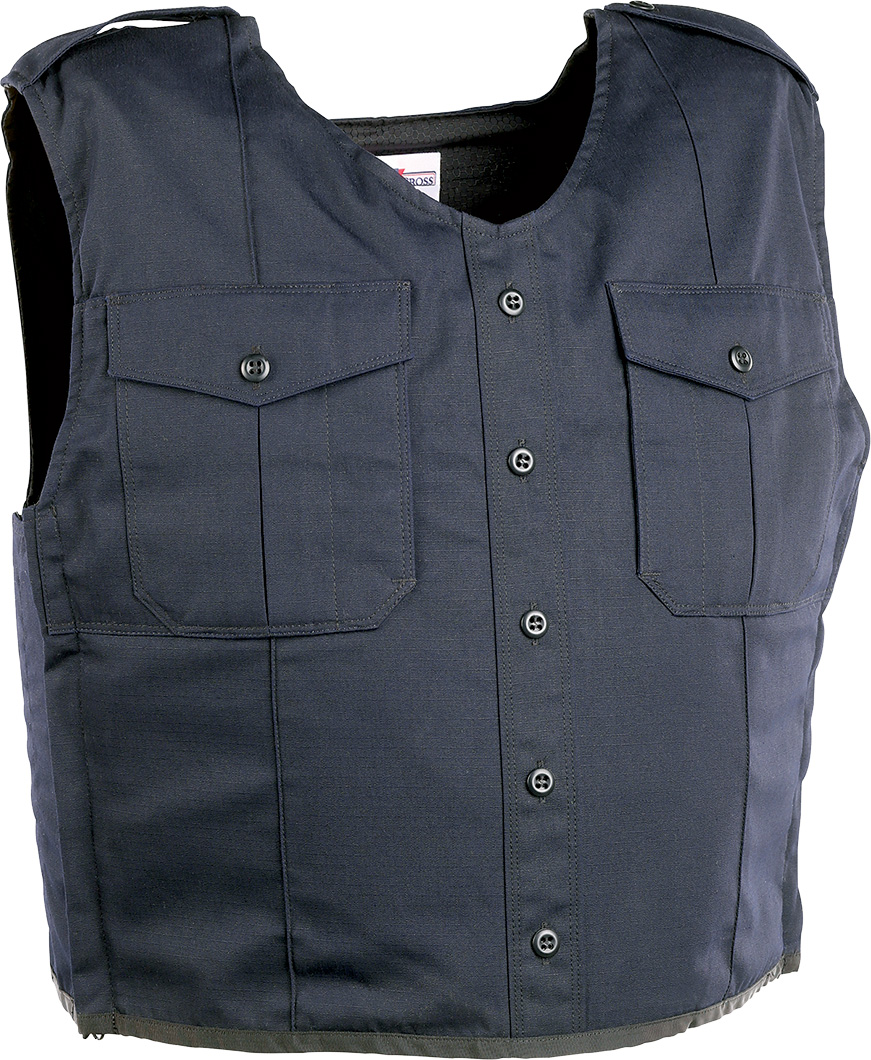
 Sold by tactical gear and uniform distributor Galls, the AeroShell External Armor Cover vest provides superior ballistic protection without compromising the professional look of a uniform. Unlike bulky bulletproof vests of yesteryear, the AeroShell sits on top of the uniform, rather than underneath. The slim, innovative design features an adjustable side panel made of shell fabric with easy access Velcro and zipper closures for a comfortable and secure fit, in addition to a wide neck opening so it’s easy to put on and take off. A special Shift-Loc strap system holds the armor panel securely for minimal movement and shifting. For added convenience, the vest has a hidden MAP pocket feature to house documents and room for wire communications pass through. Available in black, navy, tan and white, with military creases optional, in short to extra-long styles. XS–4XL. MSRP $117.90.
Sold by tactical gear and uniform distributor Galls, the AeroShell External Armor Cover vest provides superior ballistic protection without compromising the professional look of a uniform. Unlike bulky bulletproof vests of yesteryear, the AeroShell sits on top of the uniform, rather than underneath. The slim, innovative design features an adjustable side panel made of shell fabric with easy access Velcro and zipper closures for a comfortable and secure fit, in addition to a wide neck opening so it’s easy to put on and take off. A special Shift-Loc strap system holds the armor panel securely for minimal movement and shifting. For added convenience, the vest has a hidden MAP pocket feature to house documents and room for wire communications pass through. Available in black, navy, tan and white, with military creases optional, in short to extra-long styles. XS–4XL. MSRP $117.90.
Get more information on this product ->
Read this story in the Spring 2018 issue of FOP Journal.
Saluting the Fallen – 2017 Police Week
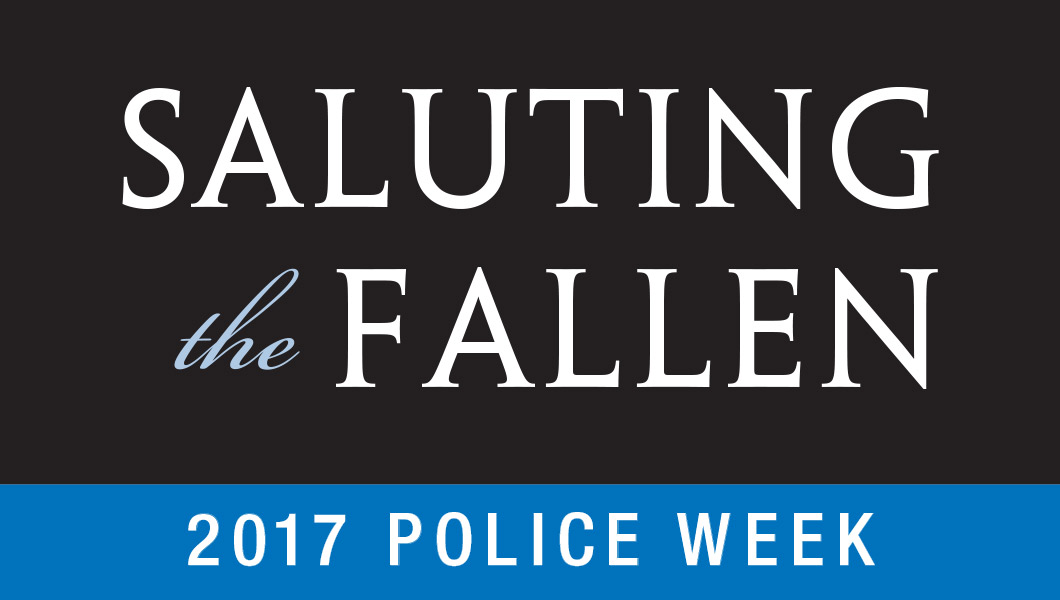
| ALABAMA Kenneth Bettis ALASKA ARIZONA ARKANSAS CALIFORNIA COLORADO FLORIDA GEORGIA ILLINOIS INDIANA IOWA KANSAS KENTUCKY LOUISIANA MARYLAND MASSACHUSETTS MICHIGAN MISSISSIPPI MISSOURI NEBRASKA NEW JERSEY NEW MEXICO NEW YORK |
NEW YORK (continued) Barry Galfano* Fred Ghussin* Edward Gilpin* John Goggin* James Guida* Claire Hanrahan* Kevin Hawkins* Robert Helmke* Michael Henry* Alick Herrmann* William Holfester* Richard Holland* Steven Hom* Richard Jakubowsky* John Kristoffersen* Frank Macri* Anthony Maggiore* David Mahmoud* John Marshall* Vito Mauro* Gary Mausberg* Jacqueline McCarthy* Michael McHugh* Brian Mohamed* Michael Morales* Robert Nicosia* Carlos Ocasio* Edwin Ortiz* Robert Oswain Jr.* Patrice Ott* Angelo Peluso Jr.* Covel Pierce* Francis Pitone* Timothy Pratt Gerald Rex* Roberto Rivera* Michael Ryan* Stephen Scalza* Joseph Seabrook* Christopher Strucker* Paul Stuewer Martin Tom* Paul Tuozzolo Perry Villani* Robert Williamson* Richard Winter* Kerry Winters Sr. George Wong* Robert Zane Jr.* NORTH CAROLINA NORTH DAKOTA OHIO OKLAHOMA OREGON PENNSYLVANIA SOUTH CAROLINA TENNESSEE TEXAS UTAH VIRGINIA WASHINGTON WEST VIRGINIA WISCONSIN FEDERAL GUAM PUERTO RICO |
* The officer’s death occurred in a previous year but was determined to be a line-of-duty death in 2016.



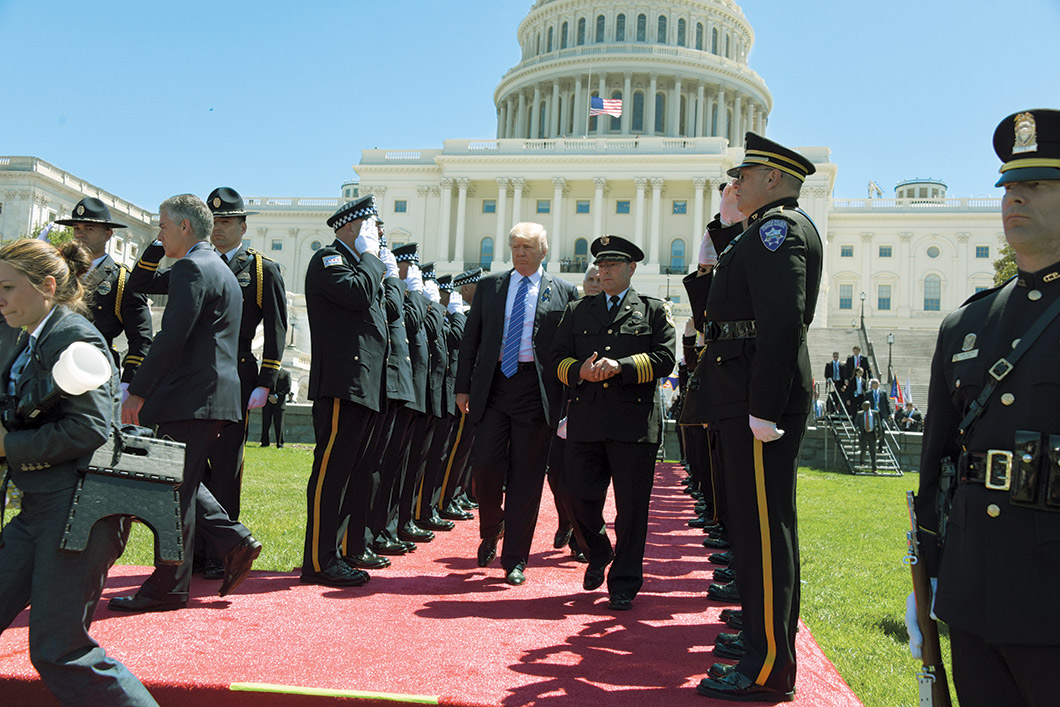
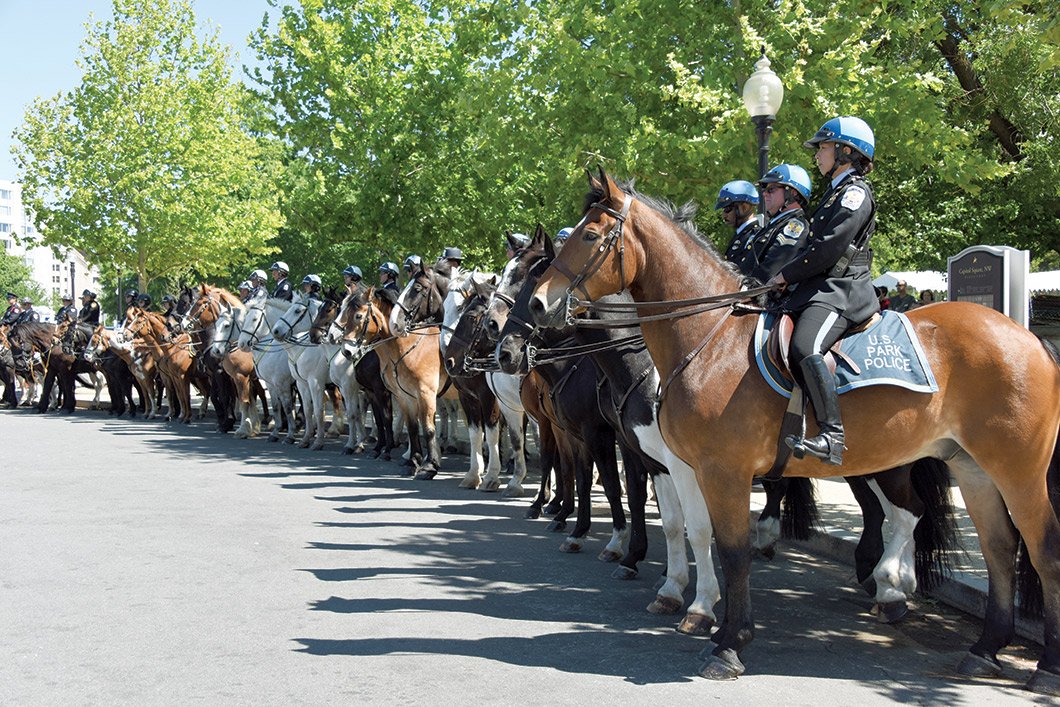



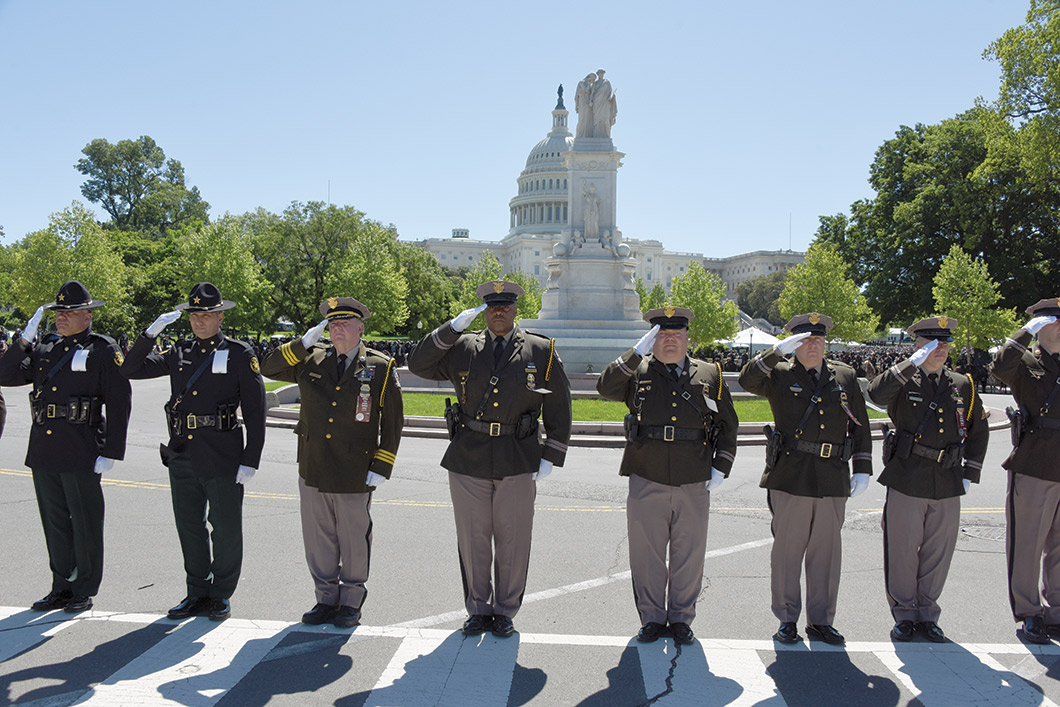
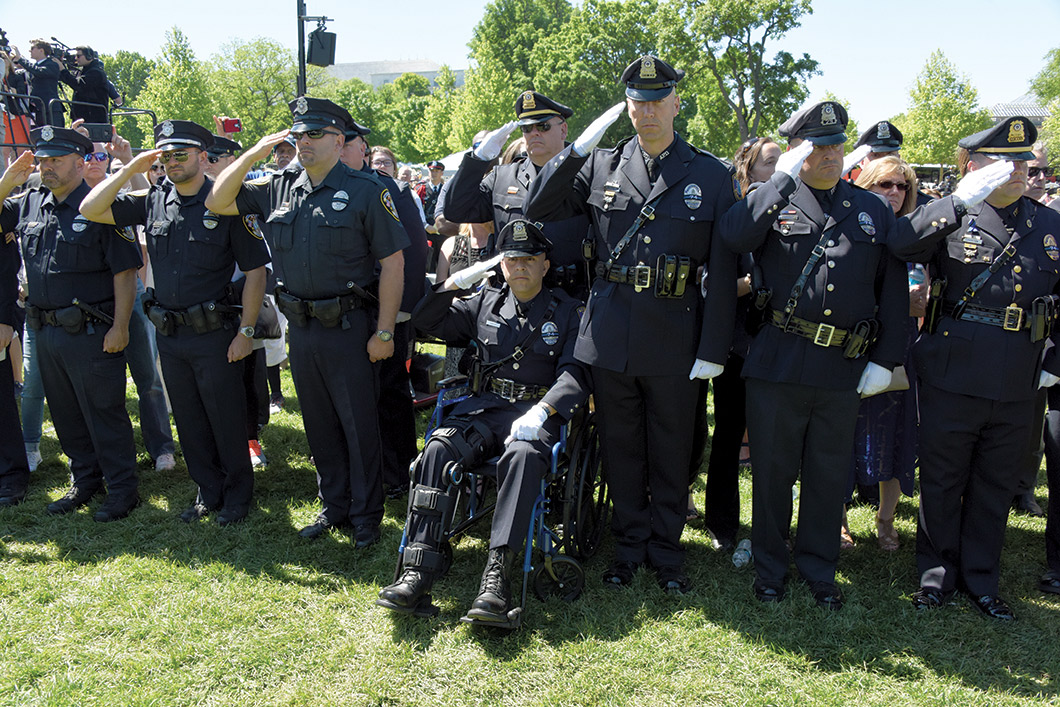
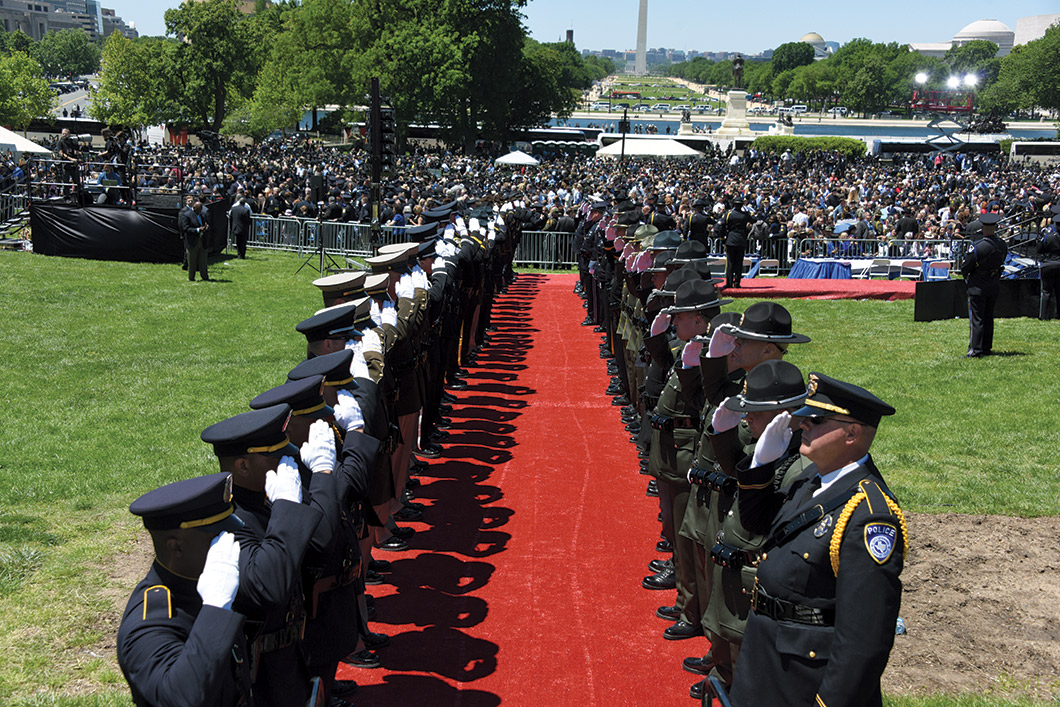


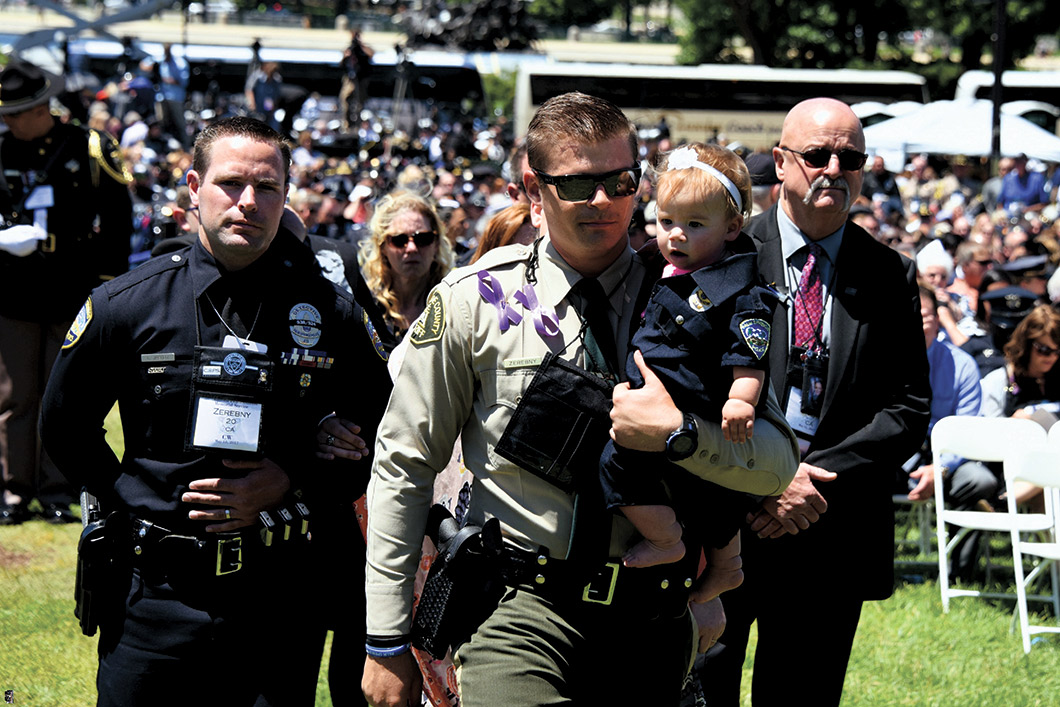






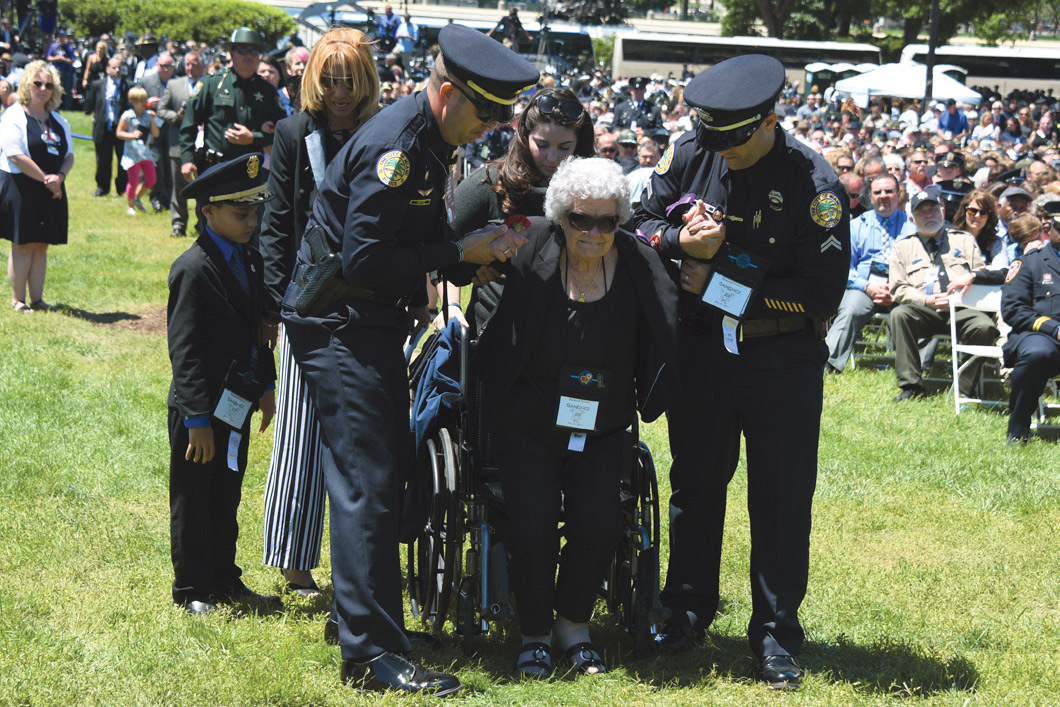


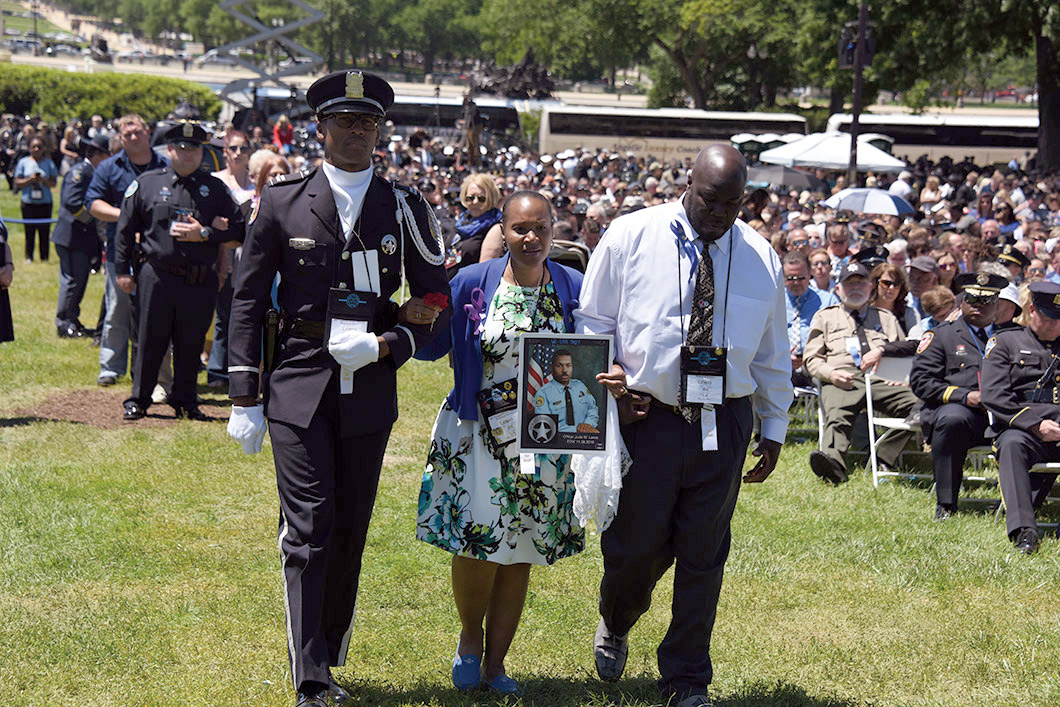











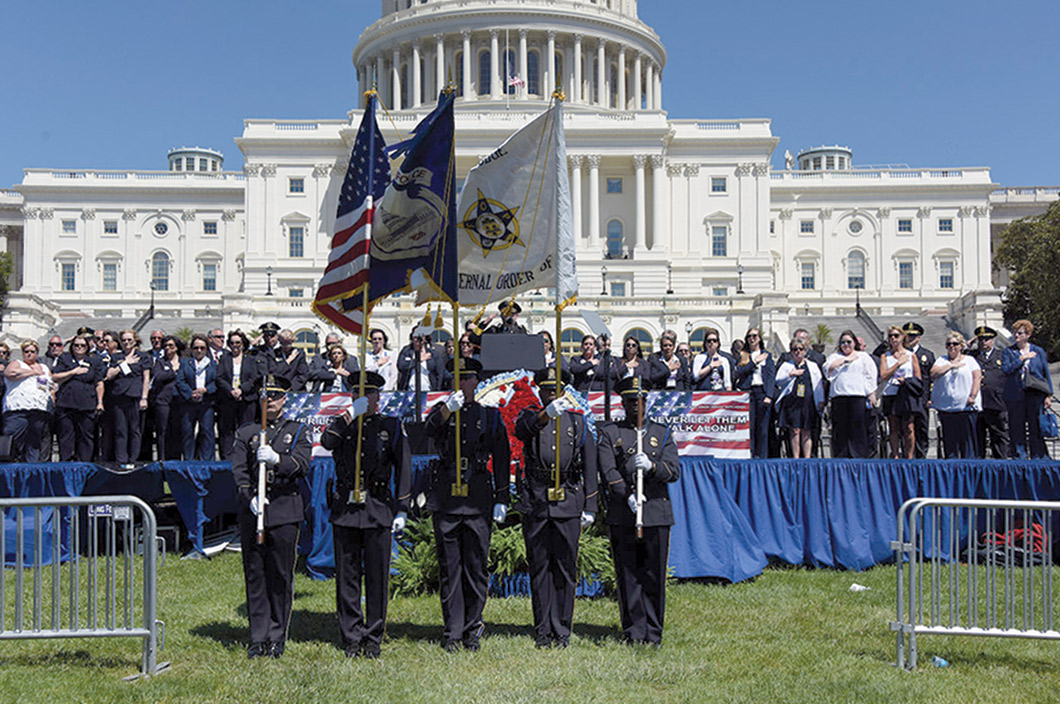
Photos courtesy of Lynn Cronquist. See this story in the Summer 2017 FOP Journal issue.
Advanced Alternatives
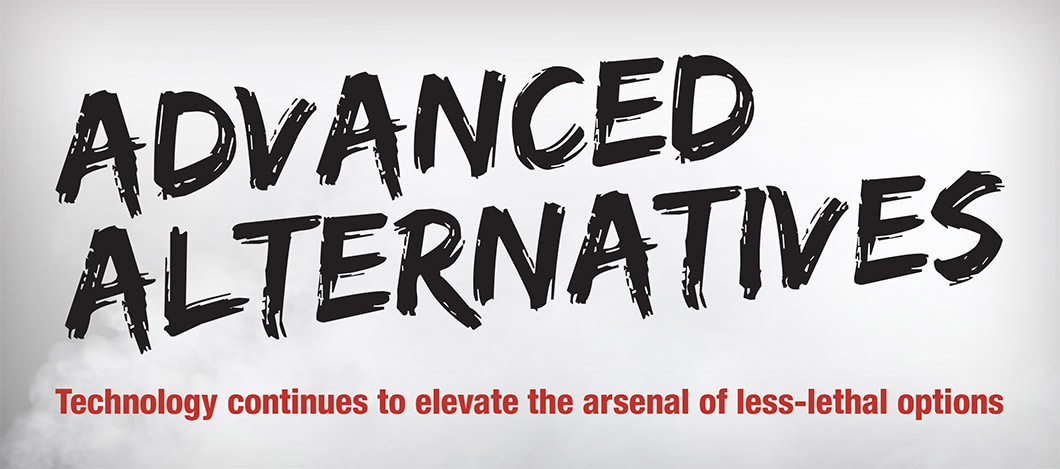
PEPPERBLASTER II
STREAMLINED DEPLOYMENT
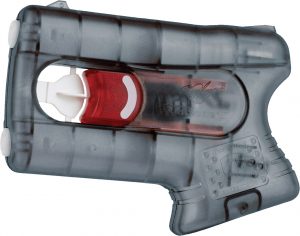 The PepperBlaster II by Kimber America is an upgraded version of its popular pepper spray launcher. This newer model’s patented jet projector technology enables shooters to fire off not one, but two continuous streams of highly effective pepper spray up to 13 feet. Even better, the technology is not affected by cold, heat, wind or direction, and the spray travels at 112 mph. MSRP $39.95.
The PepperBlaster II by Kimber America is an upgraded version of its popular pepper spray launcher. This newer model’s patented jet projector technology enables shooters to fire off not one, but two continuous streams of highly effective pepper spray up to 13 feet. Even better, the technology is not affected by cold, heat, wind or direction, and the spray travels at 112 mph. MSRP $39.95.
Get more information on this product ->
TCP
NEAR OR FAR
 The new PepperBall TCP is a compact launcher that enables users to cover various distances. A familiar, pistol-like design relies on CO2 or nitrogen cartridges within the magazine to send PepperBalls accurately up to 65 feet. Load in the new PepperBall VXR shaped projectiles, and you can increase the reach up to 150 feet. This semi-auto less-lethal pistol conveniently fits on a duty belt or attaches to any MOLLE platform. MSRP $449.
The new PepperBall TCP is a compact launcher that enables users to cover various distances. A familiar, pistol-like design relies on CO2 or nitrogen cartridges within the magazine to send PepperBalls accurately up to 65 feet. Load in the new PepperBall VXR shaped projectiles, and you can increase the reach up to 150 feet. This semi-auto less-lethal pistol conveniently fits on a duty belt or attaches to any MOLLE platform. MSRP $449.
Get more information on this product ->
MISSION SAFE MUNITIONS
SITUATIONS-SPECIFIC
 Mission Less Lethal Technologies devises less-lethal products that address multiple scenarios. Mission Safe Munitions payloads include OC, CS, PAVA, blends and specialty projectiles that permit users to choose what application works best. For example, use it to make a high kinetic impact, safely break glass from a distance or even leave a strategic marking. MSRP varies per product.
Mission Less Lethal Technologies devises less-lethal products that address multiple scenarios. Mission Safe Munitions payloads include OC, CS, PAVA, blends and specialty projectiles that permit users to choose what application works best. For example, use it to make a high kinetic impact, safely break glass from a distance or even leave a strategic marking. MSRP varies per product.
Get more information on this product ->
AUTOLOCK X3 HG EXPANDABLE BATON
READILY RELIABLE
 Monadnock, a brand of The Safariland Group, revealed its new AutoLock X3 HG Expandable Baton at the SHOT Show in February. Although smaller in size — the open length is 19.75 inches and closed length is 8.75 inches — the shaft has a larger diameter, which offers more surface contact area. Also enhancing performance is the updated cam and stainless steel ball-bearing design for reliable locking. The Super Grip handle is wrapped in a Santoprene material, while the integrated nose cap allows for smooth holstering. MSRP $196.
Monadnock, a brand of The Safariland Group, revealed its new AutoLock X3 HG Expandable Baton at the SHOT Show in February. Although smaller in size — the open length is 19.75 inches and closed length is 8.75 inches — the shaft has a larger diameter, which offers more surface contact area. Also enhancing performance is the updated cam and stainless steel ball-bearing design for reliable locking. The Super Grip handle is wrapped in a Santoprene material, while the integrated nose cap allows for smooth holstering. MSRP $196.
Get more information on this product ->

CROSSFIRE TECHNOLOGY GEL DELIVERY
KEEPS FIRING
The SABRE Crossfire Technology Gel Delivery offers operators nearly universal application with deployment from multiple directions and angles. The flip-top firing mechanism enables quick access, and the product withstands high temperatures and hydrostatic pressure. The gel is a water-soluble capsicum oleoresin with ultraviolet marking dye. MSRP $15 per unit.
Get more information on this product ->

TRMR-LE TACTICAL TRAINING DEVICE
TARGETED TECH
AMTEC Less-Lethal Systems’ TRMR-LE Tactical Training Device is a reloadable, non-lethal training grenade. Sturdy construction and easy-to-understand instructions make this an invaluable tool. Capable of up to 250 uses before replacement, the TRMR-LE is effective as a stun mechanism or a dispersal unit for irritants. The twist-to-arm system prevents accidental discharge. MSRP $250.
Get more information on this product ->
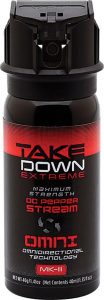
TAKE DOWN EXTREME
POWER GEL
Mace Security International is a hallmark brand in the less-than-lethal market, but this isn’t the same old spray introduced generations ago. Take Down Extreme provides ultimate stopping power. Its omnidirectional technology allows engagement from any angle, even upside down, without compromising stream consistency or interruption in spray power. Also, its powerful capsicum oleoresin gel ensures adherence to the subject for maximum effect. MSRP $16.99.

Get more information on this product ->
THE ALTERNATIVE
DOUBLE DUTY
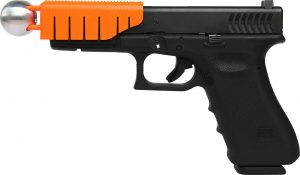 An officer’s duty belt or tactical vest is already crowded with gear, so carrying a separate less-than-lethal weapon can be less than convenient. The Alternative by Alternative Ballistics solves that situation with a patented system that converts a duty handgun into a less-than-lethal weapon. Affix the system to the gun’s muzzle to deploy a blunt-force munition. Immediately afterwards, the firearm returns to lethal-force capabilities with a fresh round cycled in. The Alternative is available for several 9mm models and makes. MSRP: $50.
An officer’s duty belt or tactical vest is already crowded with gear, so carrying a separate less-than-lethal weapon can be less than convenient. The Alternative by Alternative Ballistics solves that situation with a patented system that converts a duty handgun into a less-than-lethal weapon. Affix the system to the gun’s muzzle to deploy a blunt-force munition. Immediately afterwards, the firearm returns to lethal-force capabilities with a fresh round cycled in. The Alternative is available for several 9mm models and makes. MSRP: $50.

Get more information on this product ->
Read this story in the Summer 2017 issue of FOP Journal.
Brave the Heat

Summer days are an invitation to enjoy the great outdoors, but when the sun’s rays crank up the heat, it can make for a miserable time on patrol. The last thing you need is to be weighed down or for your uniform to trap the heat. These selected duty apparel products feature breathable fabrics, allow for ease of movement and are ready to endure a lot of wear and tear.
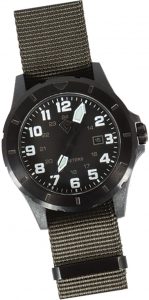
RIDGELINE CARBON FIELD WATCH
Time on Your Side
A duty watch doesn’t have to add bulk to what you already wear on the job. The Ridgeline Carbon Field Watch by First Tactical is made with a lightweight carbon resin PA housing; the medium-sized face and 12.5mm thickness further streamline its appearance. Although crafted for tactical purposes with its durable webbing band and Super-LumiNova hands, stylistically, the watch blends in with casual wear as well as with any uniform. MSRP $169.99.
Get more information on this product ->
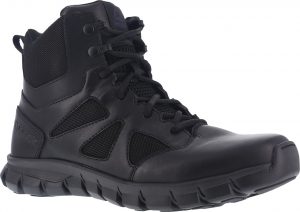 SUBLITE CUSHION TACTICAL
SUBLITE CUSHION TACTICAL
Fancy Footwork
Police work is tough on the body, so the creators of the new Reebok Sublite Cushion Tactical Boot, licensed by Warson Brands, have calculated for the type of stress law enforcement professionals put on their feet. A MemoryTech footbed conforms around the foot for an individualized fit, while the Sublite foam midsole technology minimizes the boots’ weight. The heel and toe have rubber pads for stopping/starting power and a slip-resistant outsole maintains a grip on wet surfaces. The boot also protects the wearer against electrical hazards. MSRP $113 to $148.
Get more information on this product ->
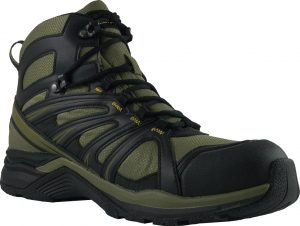
ABOOTTABAD TRAIL MID WP
Ready to Run
These rugged, quick-adjusting Altama Aboottabad Trail Runners are packed with tactical features to protect you in action, including a SOF-ROC™-wrapped arch, Panama Sole technology and highly cushioned midsole. The Rock ’n’ Roll Plate™ prevents bruising from underneath, while the molded rubber toe helps protect the foot when kicking. Waterproof membrane construction of microfiber polyurethane and nylon mesh laminate maximizes breathability and airflow. Available in coyote (tan), hunter green, gray, black and brown, as well as a low-cut (non-waterproof) style. MSRP $149.99.
Get more information on this product ->
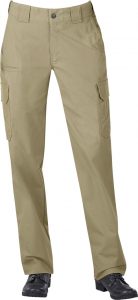
WOMEN’S TACTICAL STRETCH RIPSTOP PANTS
Form and Function
Constructed out of flexible, comfortable fabric, Dickies’ Women’s Tactical Stretch Ripstop Pants accommodate a police officer’s needs, such as a covert handcuff pocket at the center waist, an L-shaped front pocket for knife clips, plus a cellphone pocket and inset back pocket. The cargo pocket even has a built-in mag pouch. Available in black, desert sand and midnight, the pants come in a men’s cut, too. Dickies also makes the Short Sleeve Ventilated Ripstop Tactical Shirt to complete your professional look. MSRP $58.99.
Get more information on this product ->
 PURSUIT SHORT
PURSUIT SHORT
Practically Perfect
The Pursuit Short by Blackhawk! boasts large cargo pockets in addition to standard trouser pockets, so you can skip the long pants without giving up storage for accessories. Badges can be placed on the wide front belt loops. Other design elements include an action waistband that moves with the wearer to prevent binding, plus ripstop fabric treated with Teflon Shield to repel oil, water and most stains. MSRP $64.99 (28”–42” waist) or $69.99 (44”–54” waist).
Get more information on this product ->
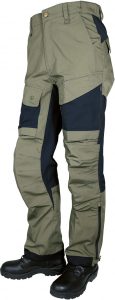
24-7 XPEDITION PANTS
Gotta Vent
These Xpedition Pants are the newest design in Tru-Spec’s 24-7 Series and have many elements to prevent the fatiguing effects of summer heat. Dual mesh zippered vents on each thigh and calf encourage a cooling airflow. Other functional favorites include one back pocket with an accessible flap and the other with a secured zipper closure, as well as boot hooks and strap adjustments with snaps on the ankle cuffs. Available in various colors. MSRP $117.95 or $154.95 (multicam/coyote color).
Get more information on this product ->
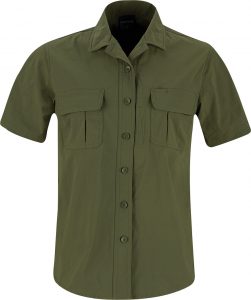 WOMEN’S SUMMERWEIGHT TACTICAL SHIRT
WOMEN’S SUMMERWEIGHT TACTICAL SHIRT
Cool It Now
Female officers will value the practical characteristics of the Women’s Summerweight Tactical Shirt by Propper. It’s cut from a lightweight fabric that’s been coated with a UPF 50 layer to protect against damaging sun exposure. Additionally, the shoulders are vented in back for extra airflow. Tactical highlights include a side-access chest pocket with hook-and-loop closure. MSRP $44.99 (short sleeve) or $49.99 (long sleeve).
Get more information on this product ->
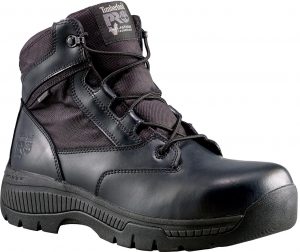
PRO VALOR 6″ DUTY SOFT-TOE WATERPROOF SIDE-ZIP
Decked Out
There’s more to taking care of your feet than just finding comfortable shoes, especially for law enforcement professionals. The Timberland PRO Valor 6” Duty Soft-Toe Waterproof Side-Zip boot features many of the same characteristics of other work boots, but with a few key additions. The footwear is treated with a blood-borne pathogen protection as well as electrical hazard protection. The mesh lining contains an antimicrobial to prevent odor buildup. It also has a wall-climb toe grip for sure footing when you find yourself going vertical. MSRP $150.

Get more information on this product ->

XPRT UNIFORMS
Fully Dressed
5.11 Tactical partnered with Cordura to create NYCO Tactical, a new fabric used in Xprt uniforms. The cotton/Cordura nylon ripstop blend features no-melt, no-drip properties and has been finished with a Teflon treatment to prevent easy staining. The durable material is complimented with comfort factors such as pants with a low-profile, adjustable waistband with spacer mesh for breathability. Or a shirt with a DuPont Kevlar-lined collar. Articulated pants and elbow pockets accommodate internal knee- and elbow pads. MSRP: pants, $199.99; shirt, $229.99

Get more information on this product ->
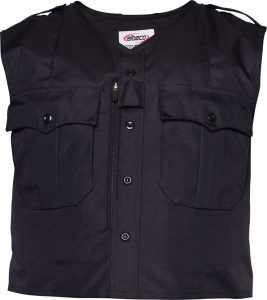
BODYSHIELD EXTERNAL VEST CARRIER
Smart Uniform
Facilitating greater freedom of movement and easier donning and doffing, Elbeco’s BodyShield Vest Carrier allows the ballistic vest to be worn outside the uniform. This machine-washable, stain-repellent vest meets modern policing needs by accommodating on-body camera and communication technology, plus it includes UPF 50 protection as well as the VSS1 Suspension System to reduce back strain. Available in midnight navy, tan and black. MSRP unavailable.

Get more information on this product ->
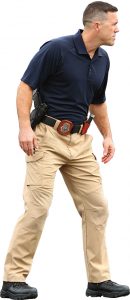
ELITE OPS TACTICAL PANTS
Designed to Last
The physical aspects of police work can be tough on duty apparel, which is why Galls has emphasized durability in its Elite Ops Tactical Pants. A hybrid fabric offers a water-repellant ripstop shell that keeps the wearer dry along with a stretch waist for freedom of movement. What’s more, the knees are reinforced with abrasion-resistant fabric. Other key functional features include D-rings on each side of the waist and reinforcements on front pockets for knife and tool clips. MSRP: $54.99

Get more information on this product ->
Read this story in the Summer 2017 issue of FOP Journal.
The Study of Crime
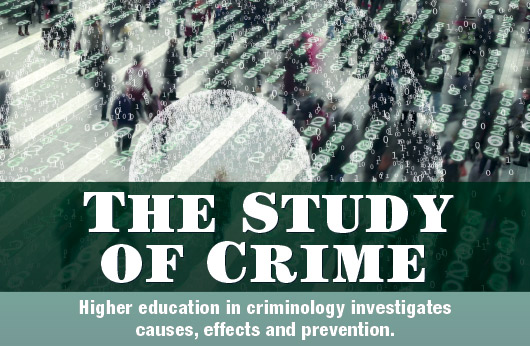
For the general public, the primary purpose of policing is to enforce the laws. Of course, those working in the field know that criminal cases aren’t always clear-cut whodunits. Officers and detectives must consider an array of factors — for example, victimology may play a role in an investigation, and a community’s cultural or economic characteristics can influence a case. The study of these broader forces is criminology, which combines principles of psychology, sociology and law to scientifically examine criminal behavior, the justice system and crime prediction and deterrence. Understanding how these dynamics affect the job of law enforcement professionals helps to improve individual, agency and government responses to crime. A degree in criminology can prepare you for a leadership role in your department or a specialized position researching and analyzing data as a criminologist, as well as offering the potential to influence policymaking or teach the next generation of peace officers.
Degree: Bachelor of Science in Criminology and Criminal Justice
Course sampling: Introduction to Corrections, White Collar Crime
Why choose it? Students benefit from experienced professors who are highly regarded in their fields, as well as input from subject-matter experts who continue to practice professionally. Topics covered include gangs, fraud, corrections and courts.
Faculty insight: “Students working within law enforcement have the opportunity to interact with scholars familiar with the realities of domestic violence, sex crimes, domestic and international terrorism, homeland security, white collar and organized crime, sophisticated money laundering, gangs and narcotics investigations.” — Rebecca Loftus, Ph.D., academic program manager and director of Israel Counter-terrorism Study Abroad Program
 “There are a variety of classes offered for the degree. The leadership development courses I have really enjoyed; they have been tremendously helpful. There are also classes on gender and crime. [They] dissect gender roles in crime, such as domestic violence or targeting females as perpetrators.”
“There are a variety of classes offered for the degree. The leadership development courses I have really enjoyed; they have been tremendously helpful. There are also classes on gender and crime. [They] dissect gender roles in crime, such as domestic violence or targeting females as perpetrators.”
Jacksonville Sheriff’s Office,
B.S. in Criminology and Criminal Justice student
 Degree: Master of Science in Criminal Justice, Criminal Behavior Concentration
Degree: Master of Science in Criminal Justice, Criminal Behavior Concentration
Course sampling: Mental Health Law in Criminal Behavior, Criminogenic Psychopathology
Why choose it? This program brings together faculty with years of practical and operational experience and students who are working professionals, creating a collaborative learning environment. The criminal behavior concentration empowers students to dissect crisis interventions, understand psychopathology and fine-tune research methods. Offered only through online courses, the concentration is formatted to allow enrollees to finish in three semesters.
Faculty insight: “Educated officers typically are exposed more to a diverse society and demonstrate better reading, writing, critical thinking and retention skills.” — Kevin Cashen, CLEE, dean, School of Criminal Justice and Social Sciences
Degree: Master of Science in Criminology
Course sampling: Contemporary Issues in Criminology, Cyber Criminology
Why choose it? Students can complete this graduate-level degree in 24 months by taking at least one course each eight-week academic period. Curriculum emphasizes analytical techniques to better predict and prevent crime, as well as to develop policing policies.
Faculty insight: “In lieu of the thesis or capstone paper, we offer students an internship. One student recently took an internship with the Colorado Bureau of Investigation (CBI). They were so impressed, they hired her. ” — Don Lindley, Ph.D., associate professor
Degree: Master’s in Criminology
Course sampling: Applied Statistics in Criminology, Prevention and Treatment of Crime and Delinquency
Why choose it? Online classes are crafted to provide the same caliber of educational opportunities offered to on-campus students. Coursework covers a breadth of topics, such as the effect of race and ethnicity on the justice system or how to incorporate organizational theories.
Faculty insight: “We view our online programs as extensions of our on-campus programs. Plus, to save our distance-learning students time and money, there are no Graduate Record Exam requirements and no out-of-state tuition fees.” — Kevin Beaver, Ph.D., director of distance learning
 “Criminology helps us evaluate what we do, how we do it and why we do it. For example, we read essays from incarcerated people about why they’re [in prison]. It was enlightening. [Incarceration] can take a family down an economic rung, and they may never recover.”
“Criminology helps us evaluate what we do, how we do it and why we do it. For example, we read essays from incarcerated people about why they’re [in prison]. It was enlightening. [Incarceration] can take a family down an economic rung, and they may never recover.”
Special Operations Division, Tampa Police Department,
Online Master’s in Criminology student
Degree: Bachelor of Science in Criminology
Course sampling: Crime and Violence in America, Directed Policing
Why choose it? Enrollees select one of four concentration options: victimology, corrections, law enforcement or forensic behavioral sciences. Working professionals can attend the off-campus program, which offers online classes and in-person receptions where faculty, administrators, students and alumni network.
Faculty insight: “We work with various law enforcement agencies through federal grants, and it’s very valuable for our students to get to interact with professionals who present to the court or district attorney’s office or juvenile justice [agencies].” — Harold Otto Schweizer, Ph.D., professor, law enforcement option coordinator and interim internship coordinator
Investing in Protection
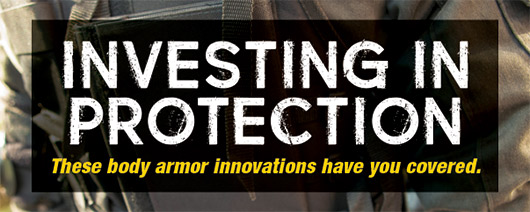 With line-of-duty deaths by gunfire up 83% in the first seven months of 2016, protecting yourself is more important than ever, and the old excuses for not donning a ballistic vest — uncomfortable, too warm, bulky — just don’t carry weight anymore. Twenty-first-century advancements in fabric, construction, materials and strength mean there’s a type of body armor available to suit every need. But with so many options to choose from, it’s important to carefully consider fit and the types of threats that you encounter most frequently in order to find the vest that’s best for you. Here’s a sampling of the latest protective products for patrol officers, all highly rated by the National Institute of Justice (NIJ), the research, development and evaluation agency of the United States Department of Justice.
With line-of-duty deaths by gunfire up 83% in the first seven months of 2016, protecting yourself is more important than ever, and the old excuses for not donning a ballistic vest — uncomfortable, too warm, bulky — just don’t carry weight anymore. Twenty-first-century advancements in fabric, construction, materials and strength mean there’s a type of body armor available to suit every need. But with so many options to choose from, it’s important to carefully consider fit and the types of threats that you encounter most frequently in order to find the vest that’s best for you. Here’s a sampling of the latest protective products for patrol officers, all highly rated by the National Institute of Justice (NIJ), the research, development and evaluation agency of the United States Department of Justice.
Concealable and Cool
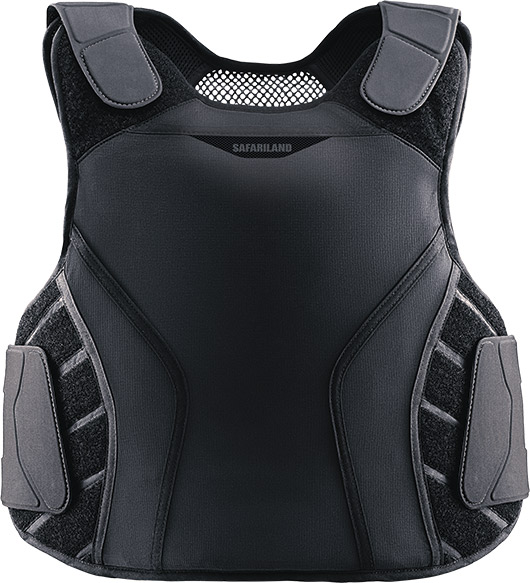 The future of ballistic carriers is already here. The P1 Covert Carrier from the Safariland Group is so ergonomically friendly and ultra-lightweight, it doesn’t even feel like a vest. Every detail is a testament to design and performance excellence. Features include four-way stretch ripstop shell fabric, removable contoured stretch straps, strategically located Velcro channels for adjustability and easy fastening, front and back plate pockets, and a Luxicool cooling space mesh liner to reduce temperatures by 3 to 4 degrees Fahrenheit for ideal comfort in intense situations. MSRP not available.
The future of ballistic carriers is already here. The P1 Covert Carrier from the Safariland Group is so ergonomically friendly and ultra-lightweight, it doesn’t even feel like a vest. Every detail is a testament to design and performance excellence. Features include four-way stretch ripstop shell fabric, removable contoured stretch straps, strategically located Velcro channels for adjustability and easy fastening, front and back plate pockets, and a Luxicool cooling space mesh liner to reduce temperatures by 3 to 4 degrees Fahrenheit for ideal comfort in intense situations. MSRP not available.
Get more information on this product ->
Seven-Point Security
 Female officers in need of a concealable soft body armor carrier turn to RISE from Angel Armor because it offers unparalleled fit, comfort and versatility for women. A fully adjustable cummerbund system allows the vest to hug the body in the places that need it most. Customizable armor ensures a superior, tailored fit, while a concealed internal front plate pocket accommodates multiple plate sizes and allows for quick vertical adjustment. Also available in male models, RISE takes protection to a higher level. MSRP $1,479 (law enforcement only).
Female officers in need of a concealable soft body armor carrier turn to RISE from Angel Armor because it offers unparalleled fit, comfort and versatility for women. A fully adjustable cummerbund system allows the vest to hug the body in the places that need it most. Customizable armor ensures a superior, tailored fit, while a concealed internal front plate pocket accommodates multiple plate sizes and allows for quick vertical adjustment. Also available in male models, RISE takes protection to a higher level. MSRP $1,479 (law enforcement only).
Get more information on this product ->
Protect Your Partner
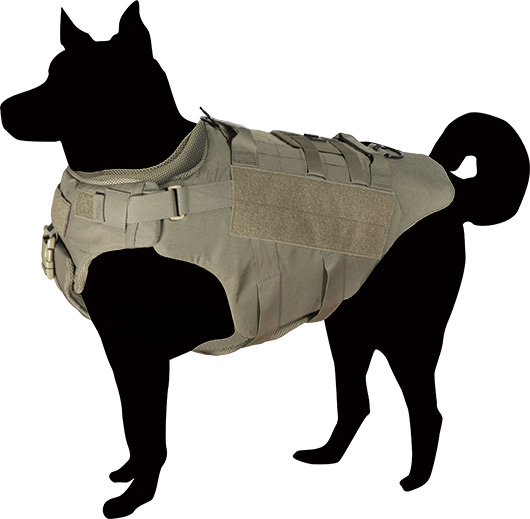 Armor Express protected more than 1,000 K-9 teams in 2015, and its TEX 10 vest offers outstanding functionality without compromising comfort and mobility. The armor provides maximum coverage for a dog’s vital organs and comes in multiple sizes to fit a range of breeds. Three buckles help ensure a proper fit and make it easy to put on and take off. Extra features include MOLLE webbing to attach flashlights or tracking devices, two D-rings for short or long leads, front and side ID badge attachment points, and a wireless camera mount. Three-dimensional spacer mesh lining helps keep your canine cool. MSRP not available.
Armor Express protected more than 1,000 K-9 teams in 2015, and its TEX 10 vest offers outstanding functionality without compromising comfort and mobility. The armor provides maximum coverage for a dog’s vital organs and comes in multiple sizes to fit a range of breeds. Three buckles help ensure a proper fit and make it easy to put on and take off. Extra features include MOLLE webbing to attach flashlights or tracking devices, two D-rings for short or long leads, front and side ID badge attachment points, and a wireless camera mount. Three-dimensional spacer mesh lining helps keep your canine cool. MSRP not available.
Get more information on this product ->
Military-Grade Armor
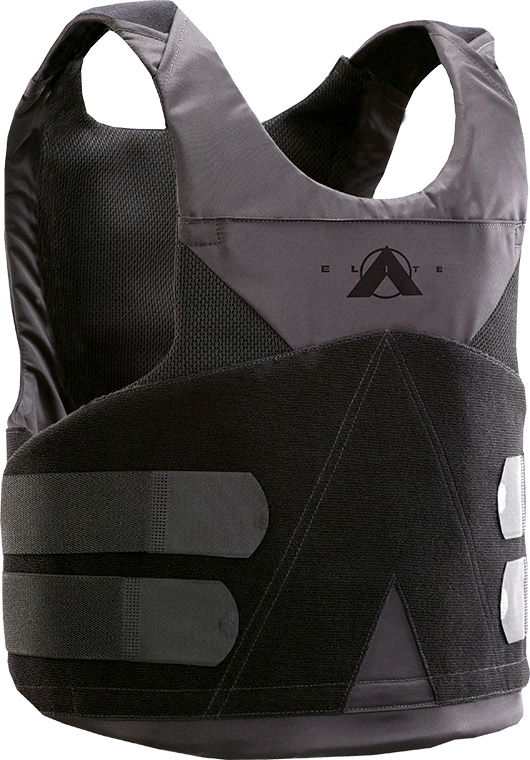 If it’s good enough for our armed forces, it’s good enough for our nation’s law enforcement officers. That’s the working theory behind the Alpha Elite Series ballistic systems from Point Blank Enterprises. Shown here inside the Elite concealable body armor vest, the Alpha Elite armor (AXII and AXIIIA models) relies on military-grade Dyneema Force Multiplier Technology to reduce ballistic threats. Point Blank engineers found this material to be extraordinarily effective against fragmentation and superbly efficient at absorbing impact energy. The Elite vest features top-loading combo plate pockets that accommodate 5”-by-8” trauma inserts as well as 6”-by-8”, 7”-by-9” or 8”-by-10” plates in front and back. MSRP $1,373 (AXII); $1,578 (AXIIIA).
If it’s good enough for our armed forces, it’s good enough for our nation’s law enforcement officers. That’s the working theory behind the Alpha Elite Series ballistic systems from Point Blank Enterprises. Shown here inside the Elite concealable body armor vest, the Alpha Elite armor (AXII and AXIIIA models) relies on military-grade Dyneema Force Multiplier Technology to reduce ballistic threats. Point Blank engineers found this material to be extraordinarily effective against fragmentation and superbly efficient at absorbing impact energy. The Elite vest features top-loading combo plate pockets that accommodate 5”-by-8” trauma inserts as well as 6”-by-8”, 7”-by-9” or 8”-by-10” plates in front and back. MSRP $1,373 (AXII); $1,578 (AXIIIA).
Get more information on this product ->
Tactical Transformation
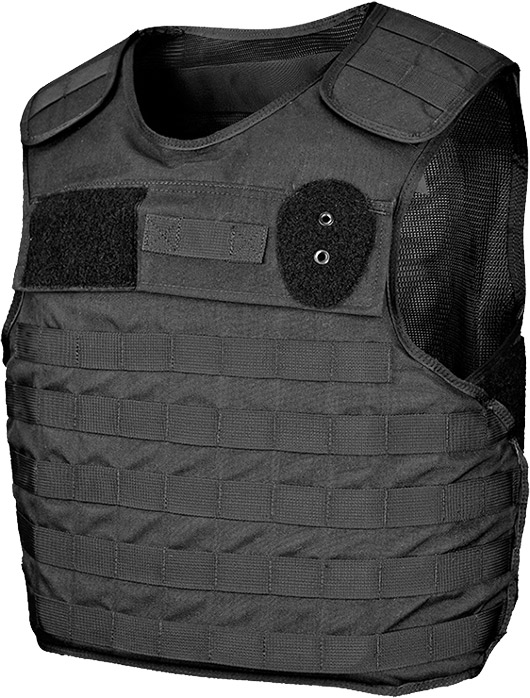 The Ready Vest from U.S. Armor lets you quickly and easily turn your concealable body armor panels into an effective yet comfortable tactical outer carrier. The Ready Vest has 10”-by-12” plate pockets in both front and back, and external MOLLE webbing to attach additional pouches and equipment. With the option to add rifle plates to the front and back faces of the carrier, you’ll be fully ready for any active-shooter threat, warrant serving, tactical containments and other quickly evolving patrol situations. MSRP $396; law enforcement price $268.
The Ready Vest from U.S. Armor lets you quickly and easily turn your concealable body armor panels into an effective yet comfortable tactical outer carrier. The Ready Vest has 10”-by-12” plate pockets in both front and back, and external MOLLE webbing to attach additional pouches and equipment. With the option to add rifle plates to the front and back faces of the carrier, you’ll be fully ready for any active-shooter threat, warrant serving, tactical containments and other quickly evolving patrol situations. MSRP $396; law enforcement price $268.

Get more information on this product ->
Durable Value
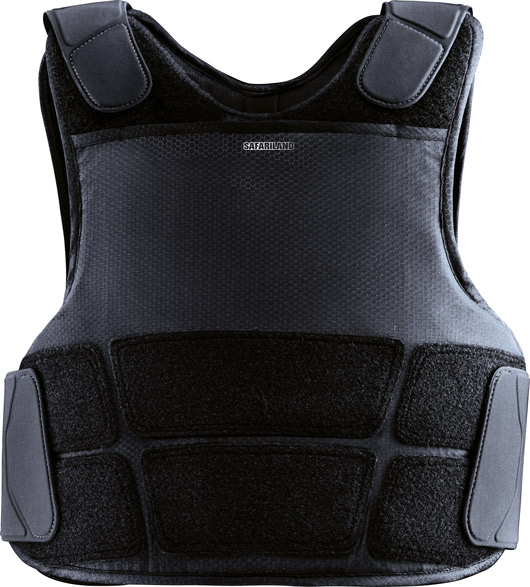 Sometimes you just need a vest that’s reliable, sturdy, and trustworthy — like a good partner. That’s what you get with the Safariland Group’s M1 Covert Carrier. This concealable ballistic vest is designed to do exactly what you need it to: protect you from a bullet and keep you as comfortable as possible so you can do your job. Made of a highly durable, washable hexagon ripstop fabric, the M1 has a high-profile hook and loop Velcro, removable contoured straps for maximum adjustability, front and rear plate pockets, and an antimicrobial wicking mesh liner to ensure comfort and mobility through all-day wear. MSRP not available.
Sometimes you just need a vest that’s reliable, sturdy, and trustworthy — like a good partner. That’s what you get with the Safariland Group’s M1 Covert Carrier. This concealable ballistic vest is designed to do exactly what you need it to: protect you from a bullet and keep you as comfortable as possible so you can do your job. Made of a highly durable, washable hexagon ripstop fabric, the M1 has a high-profile hook and loop Velcro, removable contoured straps for maximum adjustability, front and rear plate pockets, and an antimicrobial wicking mesh liner to ensure comfort and mobility through all-day wear. MSRP not available.

Get more information on this product ->
Ergonomic Edge-to-Edge Protection
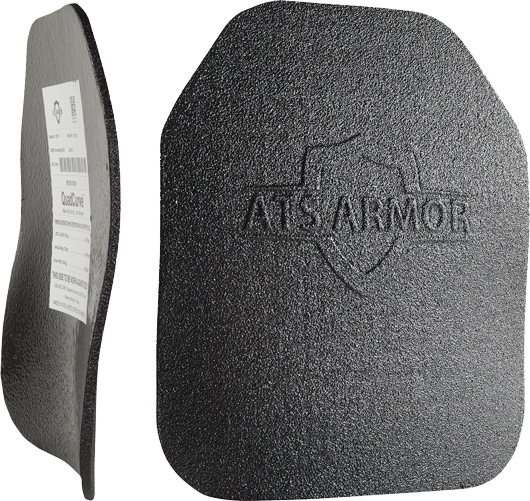 If armor isn’t comfortable, an officer is less likely to wear it. That’s why ATS Armor takes the fit and shape of its hard armor plates so seriously. The Type IIIA torso plate features ATS’ renowned QuadCurve shape, which allows the plates to fit ergonomically in either the front or back. While weighing less than a pound apiece, these plates also provide edge-to-edge protection without requiring the need for soft body armor in conjunction. “This is an important benefit of our hard armor plates because some competitors trim their plates with foam, which offers no protection from shots to the edge of the plate,” says Kim Koyle, Sales and Marketing Coordinator for ATS. MSRP $179.95 (law enforcement, military and private security contractors only).
If armor isn’t comfortable, an officer is less likely to wear it. That’s why ATS Armor takes the fit and shape of its hard armor plates so seriously. The Type IIIA torso plate features ATS’ renowned QuadCurve shape, which allows the plates to fit ergonomically in either the front or back. While weighing less than a pound apiece, these plates also provide edge-to-edge protection without requiring the need for soft body armor in conjunction. “This is an important benefit of our hard armor plates because some competitors trim their plates with foam, which offers no protection from shots to the edge of the plate,” says Kim Koyle, Sales and Marketing Coordinator for ATS. MSRP $179.95 (law enforcement, military and private security contractors only).

Get more information on this product ->
Easy On, Easy Off
 Dubbed a “crossover” vest, the Guardian Front Opening Vest from Point Blank Enterprises combines the versatility of a front-opening vest with an advanced design that offers maximum protection. The vest can fit SPEED plate varieties or Level III or IV hard armor plates (front and back), and has extra zippered and Velcro equipment pouches and pockets. A removable inner cummerbund helps get an exact fit, and adjustable shoulders and sides ensure comfortable movement. MSRP $350.
Dubbed a “crossover” vest, the Guardian Front Opening Vest from Point Blank Enterprises combines the versatility of a front-opening vest with an advanced design that offers maximum protection. The vest can fit SPEED plate varieties or Level III or IV hard armor plates (front and back), and has extra zippered and Velcro equipment pouches and pockets. A removable inner cummerbund helps get an exact fit, and adjustable shoulders and sides ensure comfortable movement. MSRP $350.

Get more information on this product ->
Razor-Thin Construction
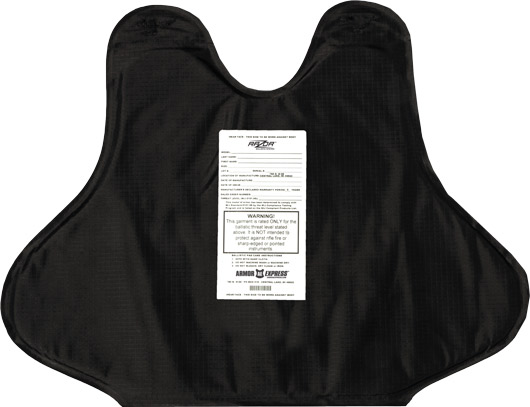 This system from Armor Express is so thin you might forget it’s there. But when it matters most, the Razor’s reinforced stopping power will halt some of the most advanced rounds available. The level II and IIIA models, like all Razor armor, are built to match the most strenuous requirements, including top-level NIJ certification. Its razor-thin construction makes it an incredibly lightweight solution, ideal for officers in extremely hot climates. MSRP not available.
This system from Armor Express is so thin you might forget it’s there. But when it matters most, the Razor’s reinforced stopping power will halt some of the most advanced rounds available. The level II and IIIA models, like all Razor armor, are built to match the most strenuous requirements, including top-level NIJ certification. Its razor-thin construction makes it an incredibly lightweight solution, ideal for officers in extremely hot climates. MSRP not available.

Get more information on this product ->
Hidden Assets

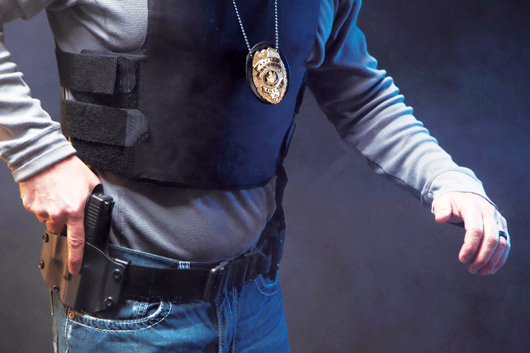 Whether you’re working undercover, packing a backup gun on duty or carrying a concealed weapon for personal protection off duty, there are many situations where you might not want to broadcast the fact. That’s when a compact firearm, safely stored in an unobtrusive yet easily accessible holster and masked by well-designed clothing, comes in handy. More and more manufacturers are expanding their catalogs to include trim, lightweight and concealable options that blend functionality with everyday comfort. Check out some of their newest and most popular designs.
Whether you’re working undercover, packing a backup gun on duty or carrying a concealed weapon for personal protection off duty, there are many situations where you might not want to broadcast the fact. That’s when a compact firearm, safely stored in an unobtrusive yet easily accessible holster and masked by well-designed clothing, comes in handy. More and more manufacturers are expanding their catalogs to include trim, lightweight and concealable options that blend functionality with everyday comfort. Check out some of their newest and most popular designs.
PETITE POWER
 The Px4 Storm Compact is yet another addition to Beretta’s Px4 series, known for its rugged components and reliable assembly. What sets this model apart is its small size, measuring less than 7 inches long and weighing in at only 27.3 ounces unloaded. The cold hammer forged barrel supports precision firing, and the rotary barrel system reduces recoil. MSRP $650.
The Px4 Storm Compact is yet another addition to Beretta’s Px4 series, known for its rugged components and reliable assembly. What sets this model apart is its small size, measuring less than 7 inches long and weighing in at only 27.3 ounces unloaded. The cold hammer forged barrel supports precision firing, and the rotary barrel system reduces recoil. MSRP $650.
Get more information on this product ->
COMFORT IN CONCEALMENT
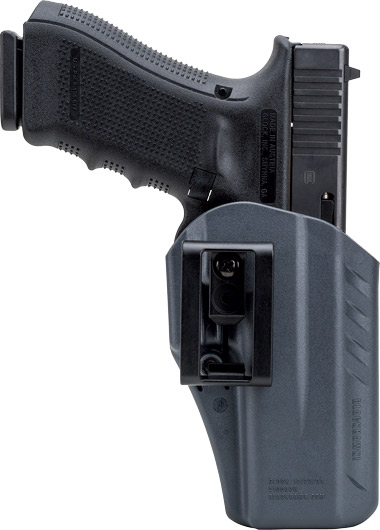 The Blackhawk! Appendix Reversible Carry (A.R.C.) Inside the Waistband (IWB) Holster allows for maximum comfort without sacrificing utility. A passive-retention system allows users to adjust the friction to their specifications. This versatile holster can be worn on either hip as well as in the appendix carry position, and comes with two cant and ride-height adjustment clips. MSRP $22.45.
The Blackhawk! Appendix Reversible Carry (A.R.C.) Inside the Waistband (IWB) Holster allows for maximum comfort without sacrificing utility. A passive-retention system allows users to adjust the friction to their specifications. This versatile holster can be worn on either hip as well as in the appendix carry position, and comes with two cant and ride-height adjustment clips. MSRP $22.45.
Get more information on this product ->
A CLASSIC UPGRADE
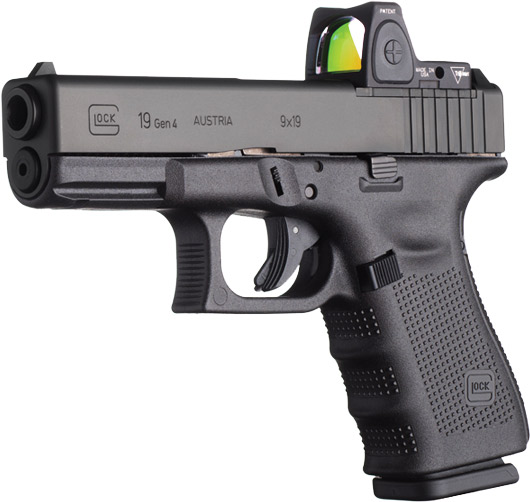 The 19 Gen4 pistol improves on the world-famous Glock design while still delivering on the quality for which the gunmaker is known. The dual recoil spring increases the operational lifespan, and the reversible enlarged magazine catch allows for either left- or right-handed shooters to handle the weapon with ease. MSRP $726.
The 19 Gen4 pistol improves on the world-famous Glock design while still delivering on the quality for which the gunmaker is known. The dual recoil spring increases the operational lifespan, and the reversible enlarged magazine catch allows for either left- or right-handed shooters to handle the weapon with ease. MSRP $726.
Get more information on this product ->
SLEEK SHOOTER
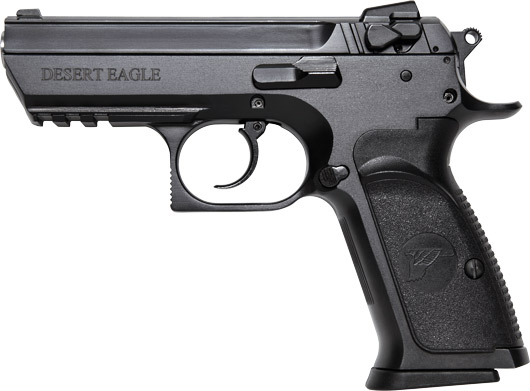 Measuring less than 4 inches long and 5.5 inches tall, the Baby Desert Eagle III, offered by Magnum Research, packs a lot of power in a compact profile. Highlights include carbon steel frame and slide. It also features a combat-style white three-dot fixed sight, and holds 10 rounds of S&W ammunition. MSRP $691.
Measuring less than 4 inches long and 5.5 inches tall, the Baby Desert Eagle III, offered by Magnum Research, packs a lot of power in a compact profile. Highlights include carbon steel frame and slide. It also features a combat-style white three-dot fixed sight, and holds 10 rounds of S&W ammunition. MSRP $691.
Get more information on this product ->
HIDDEN WARRIOR
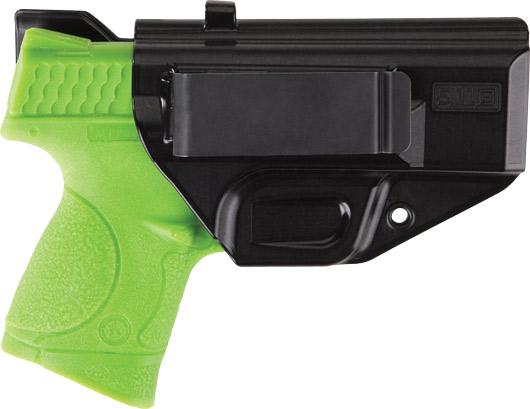 5.11 Tactical joined forces with Blade-Tech and Viking Tactics to develop the Appendix IWB Holster. The design team came up with a product that concentrates on comfort. The lightweight materials also support a secure fit, even during periods of high activity. Wear it in front or back. MSRP $29.99.
5.11 Tactical joined forces with Blade-Tech and Viking Tactics to develop the Appendix IWB Holster. The design team came up with a product that concentrates on comfort. The lightweight materials also support a secure fit, even during periods of high activity. Wear it in front or back. MSRP $29.99.
Get more information on this product ->
FASHION-FRIENDLY FORM
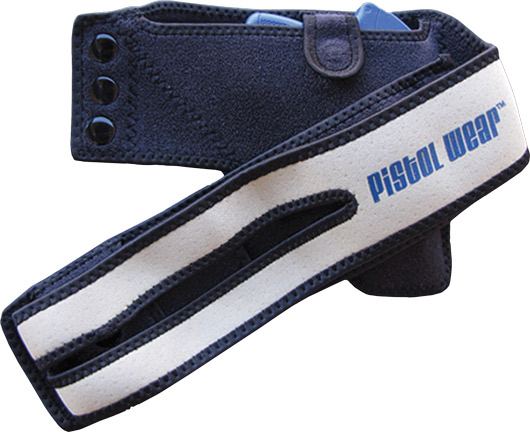 When using concealed-carry holsters, you don’t want a shirt impression to reveal what’s hiding underneath. The Trump Card Subcompact-EXT Concealment Holster by Pistol Wear features a stiff outer pouch to prevent the gun or holster from leaving a “print” under most forms of attire, from business suits to casual wear, for men or women. MSRP $44.95.
When using concealed-carry holsters, you don’t want a shirt impression to reveal what’s hiding underneath. The Trump Card Subcompact-EXT Concealment Holster by Pistol Wear features a stiff outer pouch to prevent the gun or holster from leaving a “print” under most forms of attire, from business suits to casual wear, for men or women. MSRP $44.95.
Get more information on this product ->
SAFE AND SECURE
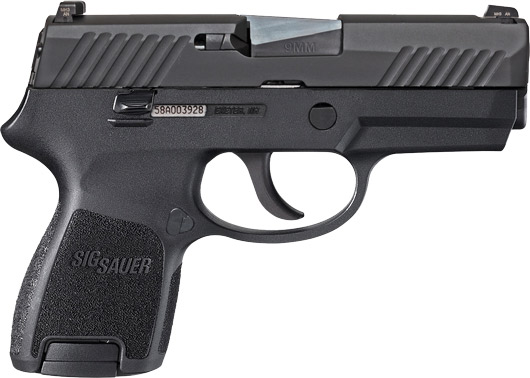 A standard five-point safety system provides both striker and disconnect safeties, plus a three-point takedown safety. This element prohibits a complete takedown without a magazine removal and slide lock. It also contains a tool-less disassembly lever. The P320 by Sig Sauer comes with small, medium or large grip sizes. MSRP $579–$679.
A standard five-point safety system provides both striker and disconnect safeties, plus a three-point takedown safety. This element prohibits a complete takedown without a magazine removal and slide lock. It also contains a tool-less disassembly lever. The P320 by Sig Sauer comes with small, medium or large grip sizes. MSRP $579–$679.

Get more information on this product ->
SIZED RIGHT
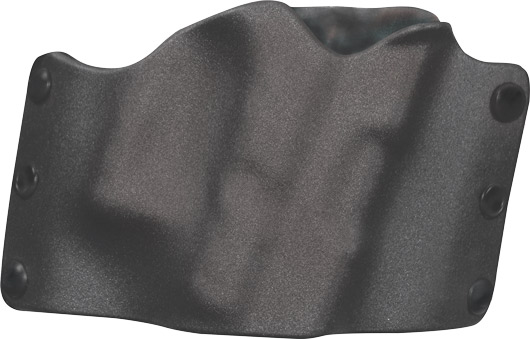 Save time and hassle by not switching holsters each time you switch firearms. Phalanx Defense Systems developed a proprietary Frame-Lock technology that allows the Stealth Operator Holster to conform around the weapon, allowing for maximum versatility. It’s available in black, coyote, OD green and even pink. MSRP $39.95.
Save time and hassle by not switching holsters each time you switch firearms. Phalanx Defense Systems developed a proprietary Frame-Lock technology that allows the Stealth Operator Holster to conform around the weapon, allowing for maximum versatility. It’s available in black, coyote, OD green and even pink. MSRP $39.95.

Get more information on this product ->
OFF THE HIP
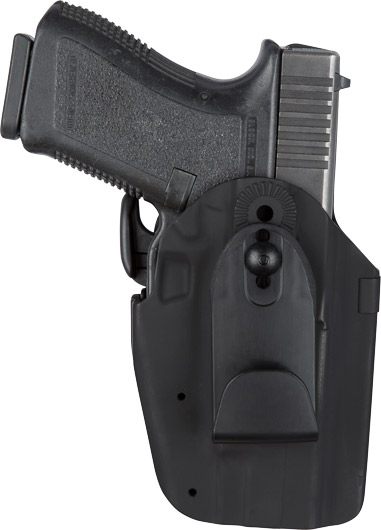 Earlier this year, Safariland debuted its 575 IWB GLS Pro-Fit Holster, specifically created to fit snugly inside the waistband of most everyday clothing. Not only does it accommodate more than 100 types of handguns, but wearers can also adjust the cant to a personalized setting. The Grip Lock System (GLS) secures the gun in the holster until the user deactivates it with their middle finger from a standard shooting grip. MSRP $55.
Earlier this year, Safariland debuted its 575 IWB GLS Pro-Fit Holster, specifically created to fit snugly inside the waistband of most everyday clothing. Not only does it accommodate more than 100 types of handguns, but wearers can also adjust the cant to a personalized setting. The Grip Lock System (GLS) secures the gun in the holster until the user deactivates it with their middle finger from a standard shooting grip. MSRP $55.

Get more information on this product ->
MAXIMUM HOLD
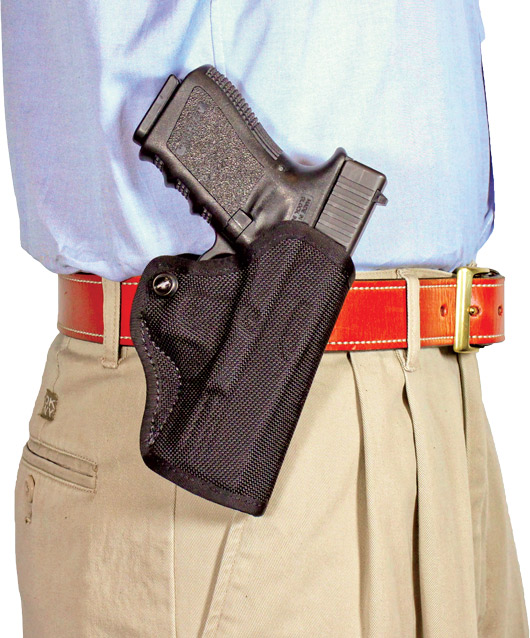 DeSantis Gunhide has added the Nylon Mini Scabbard to its catalog of holsters. This scaled-down version is created from ballistic nylon and thermo-formable materials. It holds a variety of handgun models of varying sizes. It conveniently fits to belts as wide as 1.75 inches (although some smaller guns work better with 1.5-inch belts). MSRP $33.99.
DeSantis Gunhide has added the Nylon Mini Scabbard to its catalog of holsters. This scaled-down version is created from ballistic nylon and thermo-formable materials. It holds a variety of handgun models of varying sizes. It conveniently fits to belts as wide as 1.75 inches (although some smaller guns work better with 1.5-inch belts). MSRP $33.99.

Get more information on this product ->
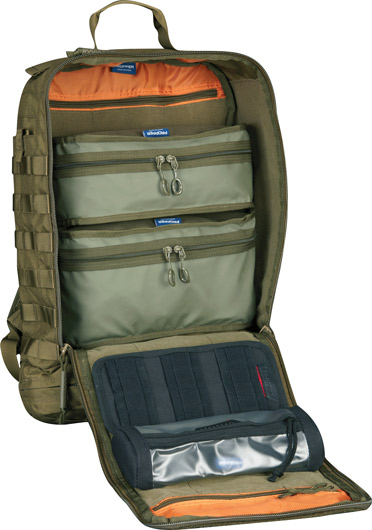 GOT YOUR BACK
GOT YOUR BACK
Casual-looking sacks can keep police gear incognito, too. The Propper U.C. Pack is lined with soft-touch loop material, which accepts all kinds of hooked items. Top openings offer hydration and cable pass-through ports while a pouch neatly tucked at the bottom offers out-of-the-way storage. MSRP $109.99.

Get more information on this product ->
Member Interview: Homeland Security and Emergency Management Studies
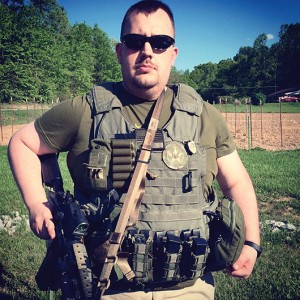 Whether it’s gathering evidence in a terrorist-related crime or assisting with rescues after Mother Nature releases her fury, having a background in homeland security or emergency management pays off for law enforcement professionals. Here, Christopher McConkey, a corrections officer and detectives liaison for the Monroe County Sheriff’s Office in Madisonville, Tennessee, and a member of FOP Lodge #21, shares why he decided to pursue a master of arts in emergency management and homeland security from Arizona State University (ASU), and how he’s applying the lessons on the job.
Whether it’s gathering evidence in a terrorist-related crime or assisting with rescues after Mother Nature releases her fury, having a background in homeland security or emergency management pays off for law enforcement professionals. Here, Christopher McConkey, a corrections officer and detectives liaison for the Monroe County Sheriff’s Office in Madisonville, Tennessee, and a member of FOP Lodge #21, shares why he decided to pursue a master of arts in emergency management and homeland security from Arizona State University (ASU), and how he’s applying the lessons on the job.
Why did you choose the ASU program?
After looking over multiple sources, Arizona State was listed as one of the top schools in the country. Also, I found that ASU was one of the more affordable schools. It was a no-brainer choosing it after combining the two [factors].
What is your favorite aspect of the program?
I actually have a couple of aspects that I like. The first is the flexibility. We do have deadlines every week, but we don’t have certain times during the week that we actually have to attend the class, like in the traditional form. We can do things at our own pace just as long as the assignments are turned in on time. And the second aspect I like is the faculty. I really like that the professors I’ve had so far are current or former law enforcement officers who have extensive training within homeland security.
Which course did you find most interesting?
I anticipate graduating in December, and after completing some of my classes, I have found that Critical Incident Stress Management has been the most interesting and informative thus far. The class is designed to help those in the law enforcement field manage stressors that can occur on a daily basis. The instructor instilled in us to explore the road of homeostasis and balance so that we, as people, could regroup from stress that occurred from a disaster or trauma.
Have you applied what you’ve learned to the job?
I learned that increased awareness and being prepared will help when a disaster happens. For example, while I was an intern with the U.S. Marshals Service for the Eastern District of Tennessee (January to May 2015), I had to check the incoming mail in a hazmat box. My main focus was to check for hazardous materials, like biological agents such as anthrax. Currently, when I go through the incoming mail at the jail, I’m checking for the same thing after all agencies statewide received a notice from the Tennessee Bureau of Investigation (TBI) to be looking for letters containing a white powdery substance. You can never be too safe or prepared when it comes to homeland security, especially with the ongoing terrorism problems.
What’s your advice to other law enforcement professionals who might be considering an education in homeland security or emergency management?
If you are considering an education in homeland security/emergency management, I would encourage you to do your due diligence and research the program that best fits you. One aspect of that would be doing an internship or going to visit an agency that interests you. Talk to peers who are currently working within the field or friends or family who are currently enrolled at a university taking this type of program. You must have a passion about helping others and putting them before yourself. You also must have a thirst for protecting our homeland.
For more information on emergency management and homeland security degree programs, check out “Be at Your Best in Case of the Worst.”
Starting a Disaster Relief Program
The Spring 2016 issue of the FOP Journal discussed the FOP’s disaster relief initiatives. If your lodge wants to prepare its own resources to lend a hand in a crisis, here are a few tips to help you get started.
Outfitting a disaster relief trailer isn’t cheap. Aside from buying the trailer itself (a 17-foot box trailer costs between $2,000 and $5,000 on eBay), your lodge will need a variety of tools, supplies and equipment at the ready. Most of the items can be stored in the trailer, but other accommodations may need to be arranged if you live in a climate with severe weather changes. All told, the initial investment may run between $50,000 and $60,000.
Here’s a sample list of items any solid disaster relief trailer should have, according to a disaster preparedness seminar taught at the 2015 National FOP Conference in Pittsburgh:
- 10’ x 10’ canopy
- 6’ folding table
- Four folding chairs
- Large cooler
- Box of trash bags
- GPS
- Grill and propane tank
- Cooking utensils
- Rakes and shovels
- All-weather work gloves
- CERT bags
- Hand tools, tape measures, hammers, etc.
- Plastic sheeting rolls
- Small generator for charging phones, radios and tools
- Power strip and heavy-duty exterior extension/power cord
- Orange spray paint to paint street names and mark houses
- First aid kit
- 20 cases of water
- Plastic cups and eating utensils
- Oil and gas for chainsaws and generators, along with gas cans
You may not need all of that equipment if your lodge decides to operate a kitchen- or food-based disaster relief trailer, but you will need to set aside additional money for buying food. In most cases, you won’t know exactly how long you’ll be needed at each event, and you’ll be relying on rough estimates for the numbers of meals you’ll be turning out daily. Buying food in bulk from a big-box retailer as close to the incident location as possible will avoid storage and spoilage issues.
For more information about how the FOP responds when disaster strikes, check out “Answering the Call.”
Safe at Home

Law enforcement professionals protect and serve on the job, but the same responsibility also applies at home. You should have full confidence that your loved ones and belongings are safe in your residence while you’re on duty, on vacation or at rest. Thanks to advances in technology, home security systems offer more options for greater protection than ever before, including strategically placed cameras to record happenings around your property, motion-detecting lights to expose dangers lurking in the shadows, and programs that handle everything from temperature control to intruder alerts via messaging to your smartphone. Here are some of the newest and most acclaimed products designed to enhance the safety of your home and family.
 COAT OF ARMS
COAT OF ARMS
The Benelli M4 Cerakote is the same M4 tactical shotgun armed forces and police agencies across the country have employed for years, but with a new coat of armor. The Cerakote coating breathes new life into this firearm, adding more corrosion, scratch and wear resistance to the weapon, up to 50 times more than other coatings. Underneath, you’ll still find the classic M4 design, with its Auto Regulating Gas Operated (ARGO) system and flexibility in attachments and ammunition. MSRP $2,399.
Get more information on this product ->
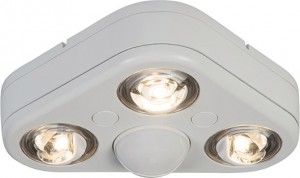 OUT-OF-SIGHT LIGHTS
OUT-OF-SIGHT LIGHTS
You don’t have to advertise your security setup to all who walk by; hidden lights can catch unwanted visitors by surprise. Revolve LED outdoor security lights sneakily attach to the undersides of eaves, so they stay out of plain view when not illuminated. Product options include a motion-sensor version and a dusk-to-dawn model, which is designed to wake up as soon as the sun sets. Choose between two or three lights per unit, as well as between 180- or 270-degree coverage. LEDs provide approximately 50,000 hours of life. MSRP $84–$99.99.
Get more information on this product ->
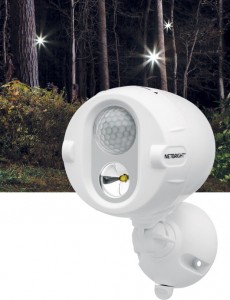 LIGHT IT UP
LIGHT IT UP
The NetBright networked wireless lighting system really brightens up a place. Like most motion-detecting spotlights, it turns on at the first sign of movement. But unlike traditional lights, NetBright’s smart solution is a linked network. When one light is triggered, the rest follow suit, so within seconds, you have a well-lit perimeter. Each light produces 200 lumens, and you can connect up to 50 lights in one network. MSRP $239.99 for six-pack.
Get more information on this product ->
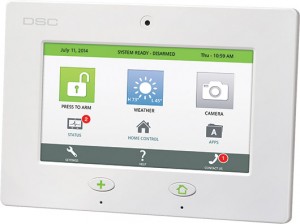 AT YOUR FINGERTIPS
AT YOUR FINGERTIPS
Smart security means maintaining control over all aspects of the system, regardless of your personal location — and that’s exactly what DSC Touch offers. Tyco Security Products has devised a 7-inch touch-screen smart panel that allows users to assess the situation on the home front remotely, thanks to an operating system based on Google’s Android that incorporates Wi-Fi, Bluetooth and Z-Wave technology. It also integrates Alarm.com for an alert system. Additionally, a built-in panel camera records images during an alarm event as critical evidence. MSRP not available.
Get more information on this product ->
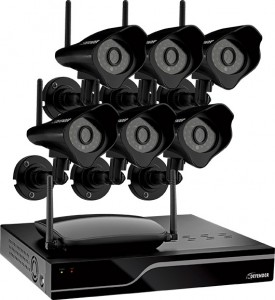 CAUGHT ON CAMERA
CAUGHT ON CAMERA
It’s impossible to have eyes everywhere, watching the inside and outside of your home every day and night — or is it? With a Defender wireless security system on the job, wireless cameras monitor activity up to 450 feet away in the daylight; the night vision, powered by 24 infrared LEDs, illuminates up to 75 feet. The Sentinel 8 CH 1TB DVR system comes with six cameras, three receivers, 10 power adapters, mounting hardware and an IR remote controller with batteries. MSRP $1,399.99.
Get more information on this product ->
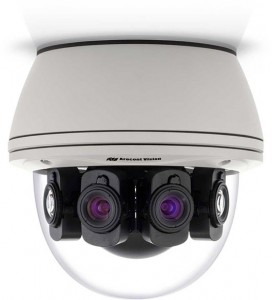 THE FULL PICTURE
THE FULL PICTURE
If one camera angle is good, wouldn’t multiple angles be better? Honored with one of Security Products magazine’s 2015 New Product of the Year Awards, the SurroundVideo G5 from Arecont Vision is a multi-sensor, multi-megapixel dome camera that provides a panoramic view. Operators can concentrate on cameras individually or blend all the images together for a more complete picture. Choose between five-, 12- or 20-megapixel resolutions for crisp, clear images. MSRP not available.

Get more information on this product ->
 CYBER SAFE
CYBER SAFE
When it comes to home protection, most people concentrate on their physical environment and may overlook safeguarding their family’s cyber presence. Sure, there are lots of security preferences you can monitor, but unless you’re super-diligent about updating them regularly, being online can open the door to nefarious activities. The new CUJO device creates another layer of protection by utilizing business-level Internet security programs for the home, defending your devices from hacking, malicious websites and unauthorized access. MSRP $99.

Get more information on this product ->
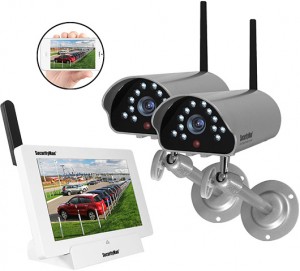 IN FOCUS
IN FOCUS
Do you have a lot of acreage to monitor? Storage structures you’d like to keep an eye on? The DIGILCDNDVR2 from SecurityMan allows users to peek in on sites up to 490 feet away with a clear line of sight. Obstacles in the way? No problem — the camera also captures images between walls up to 290 feet. Want to hear what’s going on, too? The DIGILCDNDVR2 houses a built-in microphone that records sounds up to 30 feet away. Observe it all via a portable seven-inch touch-screen LCD monitor. MSRP $429.99.

Get more information on this product ->
 MORE BANG FOR YOUR BUCK
MORE BANG FOR YOUR BUCK
The 590A1 and 590 7-Shot tactical shotguns are newly updated versions of Mossberg’s signature weapons. They each boast a seven-shell capacity with a compact 18.5-inch barrel, which traditionally only carries six rounds. Both shotguns feature an ambidextrous safety and dual extractors to work well for right- or left-handed shooters. Steel-to-steel lockup, twin-action bars and anti-jam elevators make it a safe and easy firing platform. MSRP $441–$734.

Get more information on this product ->
Preparing for a Crisis
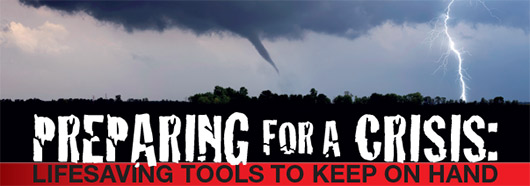
Mother Nature went rogue in 2015. Kentucky and West Virginia faced severe storms and mudslides in May. October gave Washington state its biggest wildfire season in history. Deadly tornadoes hit Texas the day after Christmas. St. Louis was ravaged by floodwaters as it welcomed the new year. These massive weather events remind us of two important facts: Emergency first responders are needed more than ever, and you should always be equipped for a disaster. Here’s some top-grade gear to have at the ready.
+ North American Rescue 50-Foot Throw Bag
 Floodwaters are no joke — they may look slow-moving at times, but river currents can sweep you away before you even realize what’s happening. If you live or work in a flood-prone area, keep one of these 50-foot throw bags in your vehicle. The Pegasus Triton rope is strong enough for multiple uses: as a throw line, a tension diagonal or a tow line for pinned kayak recovery. Its quick-dry mesh makes it great for multiple uses, too. MSRP $102.44.
Floodwaters are no joke — they may look slow-moving at times, but river currents can sweep you away before you even realize what’s happening. If you live or work in a flood-prone area, keep one of these 50-foot throw bags in your vehicle. The Pegasus Triton rope is strong enough for multiple uses: as a throw line, a tension diagonal or a tow line for pinned kayak recovery. Its quick-dry mesh makes it great for multiple uses, too. MSRP $102.44.
Get more information on this product ->
+ NITRO-PAK Urban Survival-Pak Level II
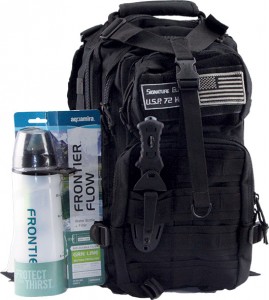 This gem from NITRO-PAK’s Signature Elite Series is chock-full of the tactical survival, evasion and escape supplies you’ll need if displaced from your home for two to five days in a major disaster. Developed by experts with hands-on military and security experience, it contains 147 essential items, including food, a Gerber Suspension Multi-Tool, an Aquamira Water Filter Bottle (treats up to 100 gallons) and a Coby AM/FM radio with earbuds. Considering it does the job of dozens of items you’d need to purchase separately, it’s a worthy investment. MSRP $439.
This gem from NITRO-PAK’s Signature Elite Series is chock-full of the tactical survival, evasion and escape supplies you’ll need if displaced from your home for two to five days in a major disaster. Developed by experts with hands-on military and security experience, it contains 147 essential items, including food, a Gerber Suspension Multi-Tool, an Aquamira Water Filter Bottle (treats up to 100 gallons) and a Coby AM/FM radio with earbuds. Considering it does the job of dozens of items you’d need to purchase separately, it’s a worthy investment. MSRP $439.
Get more information on this product ->
+ Quake Kare Deluxe Pet First Aid Kit
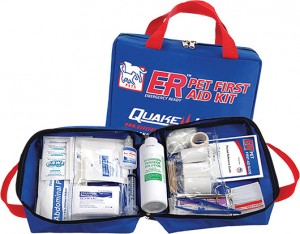 Help your furry friends when disaster strikes! This emergency-ready kit contains pet first aid items from nose to tail. You’ll find instruments, dressings, medicines and antiseptics, plus an instruction guide to help you treat common injuries quickly and correctly. MSRP $39.95.
Help your furry friends when disaster strikes! This emergency-ready kit contains pet first aid items from nose to tail. You’ll find instruments, dressings, medicines and antiseptics, plus an instruction guide to help you treat common injuries quickly and correctly. MSRP $39.95.
Get more information on this product ->
+ Etón American Red Cross FRX3 Emergency Radio
You won’t feel alone during a disaster with this device. The FRX3 AM/FM/NOAA radio not only charges your smartphone, but also automatically receives emergency weather alerts for your area, keeping you notified about hurricanes, tornadoes and severe storms. Power up with AAA batteries, use the mini-USB cable to charge the built-in rechargeable battery, set the solar panel in the sun, or spin the hand turbine for one minute to get 10 to 15 minutes of radio and LED flashlight use. A backlit digital display means you’ll always locate your radio in the dark, and there’s a red flashing beacon for emergencies. MSRP $69.99.

Get more information on this product ->
OTHER ESSENTIAL ITEMS YOU SHOULD ALWAYS HAVE IN CASE OF EMERGENCY INCLUDE:
- Bottled water (one gallon per person per day) for at least three days
- Food (canned goods, nonperishable items, high-protein snacks, comfort foods) for at least three days
- Manual can opener and Sterno for cooking
- Flashlight and extra batteries
- Candles and matches
- Battery-powered or hand-cranked radio
- Essential medications and medical items (e.g., glasses, contact lenses, syringes) for at least seven days
- Baby supplies like diapers, wipes, formula and bottles
- Pet supplies such as food, bowl, carrier, collar, leash and ID
- Blankets and clothing
- Personal hygiene items, including feminine hygiene products
- Plastic bucket with tight lid and lots of plastic bags that fit inside (makeshift toilet)
- First aid kit
- Copies of important personal documents (e.g., birth certificates, passports, insurance policies, home deed/lease) in a weather/fireproof safe or lockbox
- Family and emergency contact information
- Extra cash
- Cellphone chargers
- Books or games to pass the time
Be at Your Best in Case of the Worst
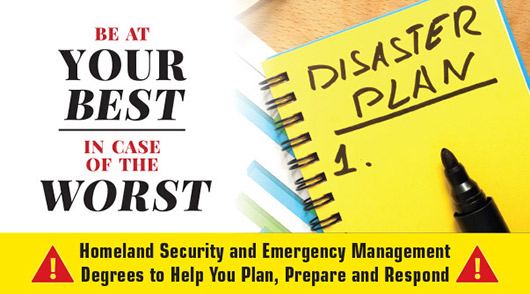
On New Year’s Day, as millions of viewers tuned in to watch the Rose Parade, what they didn’t see on camera was the increased presence of law enforcement along the route, with explosives-detection and tactical teams standing ready to respond to any terrorism event. Assessing risks for such potential attacks and planning strategic responses are key skills taught in homeland security degree programs.

After the December 2015 mass shootings in San Bernardino, California, homeland security officials stepped up protective measures for the January 1 Rose Parade in nearby Pasadena.
Of course, law enforcement professionals aren’t only called upon for human-made events. Natural disasters, such as the widespread flooding this past winter, also demand specialized training to spearhead rescue operations, develop response policies and help first responders cope with trauma. Those skills are at the core of the field of emergency management.
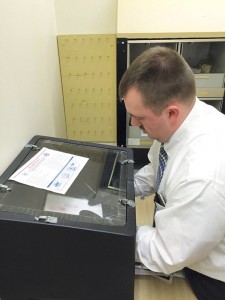
FOP member Christopher McConkey (Tennessee Lodge #21), currently earning a master’s degree in emergency management and homeland security, checks incoming mail for hazardous materials such as anthrax.
Due to escalating terrorism threats, mass shootings and catastrophic weather, the demand for homeland security and emergency management expertise is growing exponentially. “You can never be too safe or prepared when it comes to homeland security, especially with the ongoing terrorism problems,” says Tennessee FOP Lodge #21 member Christopher McConkey, a corrections officer and detectives liaison for the Monroe County Sheriff’s Office in Madisonville, who’s pursuing a master of arts in emergency management and homeland security from Arizona State University. “Increased awareness and being prepared will help when a disaster happens.”
With these skills being sought by law enforcement agencies at all levels, enhancing your abilities can be a smart career move. “If you are considering an education in homeland security/emergency management, I would encourage you to do your due diligence and research the program that best fits you,” McConkey advises. To get started, check out the following options.
 Upper Iowa University
Upper Iowa University
www.uiu.edu
Certificate: Emergency and Disaster Management
Course sampling: Principles and Practice of Hazards Mitigation; Business and Industrial Crisis Management; Psychology of Disaster
Why choose it? UIU’s certificate program allows students to gain experience in a specific area by successfully completing a group of interrelated college courses, either for academic credit toward a degree or not. Participants study the political and policy basis of emergency management, preparedness planning, and disaster response and recovery.
Eastern Kentucky University
www.eku.edu
Degree: Bachelor of Science in Homeland Security
Course sampling: Legal and Ethical Issues in Homeland Security; Risk Analysis; Homeland Security Technology
Why choose it? This College of Justice & Safety degree concentrates on three core components: critical infrastructure protection, disaster preparedness and response, and intelligence sharing and analysis. “Also, several foundational areas are emphasized that are useful in all public safety careers,” says Ryan Baggett, Ed.D., associate professor and program coordinator. “These areas include critical and creative thinking, written and oral communications, teamwork and problem solving, as well as leadership and strategic planning.”
Arizona State University
www.asu.edu
Degree: Master of Arts in Emergency Management and Homeland Security
Course sampling: Information Technology in Emergency Management; Community Resilience and Recovery; Critical Incident Stress Management
Why choose it? Offered through the College of Public Programs, this 30-credit degree draws on the experience of faculty from both the School of Criminology and Criminal Justice and the School of Public Affairs. The curriculum is designed to develop critical-thinking approaches to the multifaceted aspects related to natural and human-made disaster scenarios. It emphasizes a systems approach for a broader perspective that accounts for an all-hazards/all-threats orientation.
Northeastern University
www.northeastern.edu
Degree: Master of Science in Security and Resilience Studies
Course sampling: Security and Resilience Policy; Controversial Issues in Security Studies; International Security
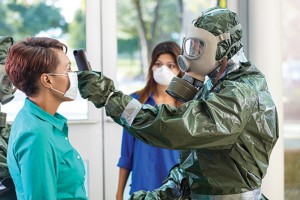 Why choose it? Participants can choose from three areas of specialization —administration, management and policy; counterterrorism; or cybersecurity policy — or work with faculty to define their own. Instructors bring real-world experience to their classes: “Our faculty consists of practitioner scholars who work in their fields every day. We have a counterterrorism expert teaching unconventional threats and a military risk manager who teaches risk management,” says Craig W. Gruber, Ph.D., an assistant teaching professor. “More than theory, our students get to practice and work with and on projects with real-world implications.”
Why choose it? Participants can choose from three areas of specialization —administration, management and policy; counterterrorism; or cybersecurity policy — or work with faculty to define their own. Instructors bring real-world experience to their classes: “Our faculty consists of practitioner scholars who work in their fields every day. We have a counterterrorism expert teaching unconventional threats and a military risk manager who teaches risk management,” says Craig W. Gruber, Ph.D., an assistant teaching professor. “More than theory, our students get to practice and work with and on projects with real-world implications.”
Long Island University
www.liu.edu
Degree: Master of Science in Homeland Security Management
Course sampling: Homeland Security and the Private Sector; Constitutional Issues in Homeland Security Management; Psychological and Sociological Aspects of Disaster and Terrorism
Why choose it? Long Island University’s Homeland Security and Terrorism Institute has earned top honors as a U.S. Department of Homeland Security Center of Excellence. The program was created to teach law enforcement professionals, first responders, military personnel, and government and public safety officials. The degree offers two tracks: homeland security or cybersecurity policy.
 Trident University
Trident University
www.trident.edu
Degree: Master of Science in Emergency and Disaster Management
Course sampling: Emergency Operations; Public Health and the Aftermath of a Disaster; Domestic Terrorism
Why choose it? This online program imparts an advanced knowledge base and practical skills to evaluate and manage the impact of a catastrophic occurrence. Enrollees may concentrate on logistics, which focuses on prioritization during a crisis, tested via simulation scenarios. “Graduates of Trident’s EDM program will have a broad understanding of the emergency situation, how to work with all direct and auxiliary support units and services, and be prepared to take part in the planning and execution of such operations,” says Mickey Shachar, Ph.D., program director.

Editor’s note: Click here for further insights from FOP member Christopher McConkey about studying homeland security and emergency management.
Surviving the “X”
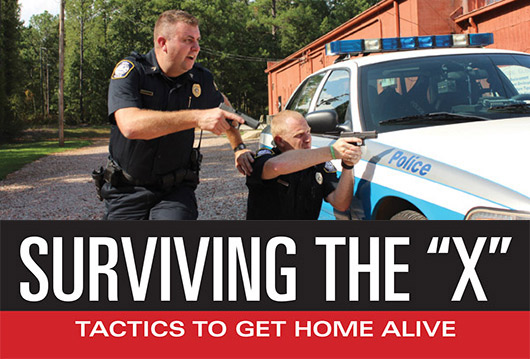 By Captain Darren Norris
By Captain Darren Norris
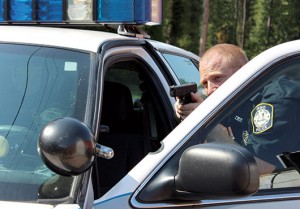 Today more than ever, law enforcement officers are confronted with a host of challenges and a multitude of threats. The outcome of every decision made by officers has the potential to be a life-changing event for everyone involved. This is especially the case when mitigating a threat that has a deadly force narrative.
Today more than ever, law enforcement officers are confronted with a host of challenges and a multitude of threats. The outcome of every decision made by officers has the potential to be a life-changing event for everyone involved. This is especially the case when mitigating a threat that has a deadly force narrative.
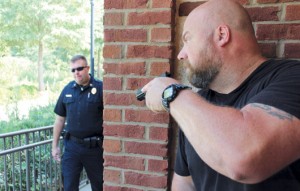 In the last couple of years, incidents stemming from officer-involved shootings have monopolized traditional and social media outlets, generating a wide range of public opinion accompanied by a host of diverse reactions — including groups like the New Black Panther Party and the Black Lives Matter movement advocating violence against law enforcement officers.
In the last couple of years, incidents stemming from officer-involved shootings have monopolized traditional and social media outlets, generating a wide range of public opinion accompanied by a host of diverse reactions — including groups like the New Black Panther Party and the Black Lives Matter movement advocating violence against law enforcement officers.
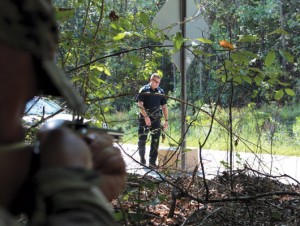 A person just has to look at the news or social media to see that deadly assaults on law enforcement officers are what appears to be a trending epidemic. The National Law Enforcement Officers Memorial Fund reports that 126 officers were killed nationwide in 2014, with the highest percentage falling victim to ambush assaults.
A person just has to look at the news or social media to see that deadly assaults on law enforcement officers are what appears to be a trending epidemic. The National Law Enforcement Officers Memorial Fund reports that 126 officers were killed nationwide in 2014, with the highest percentage falling victim to ambush assaults.
Assaults against officers are not a new phenomenon. Dating back to the 1960s and 1970s, groups such as the original Black Panther Party, Symbionese Liberation Army and the Klu Klux Klan have been responsible for a number of law-enforcement-related assaults through the use of militarized tactics. 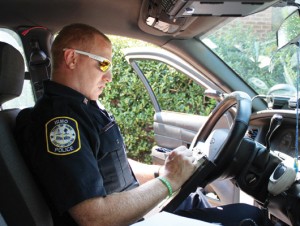 In the current environment, the bottom line is that it is officers’ responsibility to prepare themselves to mitigate and survive a violent confrontation should it arise. Further, it is every agency’s responsibility to train its officers to the highest level of readiness for duty.
In the current environment, the bottom line is that it is officers’ responsibility to prepare themselves to mitigate and survive a violent confrontation should it arise. Further, it is every agency’s responsibility to train its officers to the highest level of readiness for duty.
Anatomy of an Ambush
Simply stated, an ambush is a surprise attack on a moving or fixed target from a position of concealment. Those staging the ambush usually select a target site commonly referred to as the “X” or “kill box,” which allows them to maintain tactical dominance over their selected target. This battle-proven tactic utilizes speed, surprise and violence of action to attack before the target has an opportunity to react and defend themselves.
The Best Tactic for Preventing an Assault
Regardless of your assignment, maximize avoidance by adhering
to the following:
- Know the area or take someone who does.
- Always carry the appropriate equipment that is needed to win a fight. “Two is one, one is none”: This pertains to people and gear.
- Maintain good situational awareness. (Keep your head on a swivel.)
- Always maintain a positive mental attitude and situational control.
- Don’t get baited into a fight. Always use good tactics and wait for backup.
- Always be mindful of officer and vehicle positioning.
- Don’t lose focus of what is happening on-scene. Avoid too much focus on the ticket book, computer, etc.
- If something doesn’t feel right or look right, call for another unit.
- Remember: Time and distance are the primary advantage to winning any fight!
Ambush assaults are an age-old military tactic that troops have perfected over the years through research and development and real-world combat operations. The original concept is believed to be imitative of the stalking tactics used in the animal kingdom, where carnivorous animals — often referred to as ambush-predators or sit-in-wait predators — lie in a concealed location and attack their unsuspecting prey once they move into striking distance.
Two types of ambushes are typically used. The hasty ambush utilizes opportunity to exploit a target, while the deliberate ambush is generally a well-planned ambush on a specific target in a specific location. Ambush assaults are typically executed either as a point or area attack. The point method is an attack at a single location on a single target, whereas the area method may encompass multiple-point ambushes on multiple targets at different locations, utilizing a coordinated method to initiate the assaults.
Avoidance
One of the most dangerous potential threats to every law enforcement officer is the “It can’t happen to me” mindset. It can, so officers don’t have the luxury of being complacent, lazy or out of shape! An ambush assault, or any assault for that matter, can happen anywhere. It could be a well-planned, deliberate attack or a hasty attack in an apartment, restaurant or on roadside traffic stop. Attacks on officers are occurring while they are off duty in public spaces, as well as at their residences, with greater frequency. For example, many agencies issue officers take-home patrol cars that are proudly parked in front of their residences. Although that is a great fringe benefit of the job, it also lets people know when that officer is off duty. Look at other alternatives, such as parking the car in the garage or a place where the car is not visible from the road.
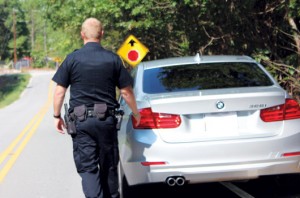 Agencies must put operational security (OPSEC) at the forefront of their policies and procedures to protect officers. For example, if someone asks if Officer Jones is on duty, what would the best response be? Instead of giving a direct yes or no answer, the person should be politely asked for their name, number and a message. It is also acceptable to advise that officers’ schedules cannot be provided due to security reasons. Regardless whether it is a dispatcher or the chief of police, security is everyone’s responsibility. People with ill intent only need to take to mobile apps such as Waze to find the location of officers on duty. Information such as the number of officers on duty or a specific officer’s schedule should never be disseminated to non-law-enforcement personnel.
Agencies must put operational security (OPSEC) at the forefront of their policies and procedures to protect officers. For example, if someone asks if Officer Jones is on duty, what would the best response be? Instead of giving a direct yes or no answer, the person should be politely asked for their name, number and a message. It is also acceptable to advise that officers’ schedules cannot be provided due to security reasons. Regardless whether it is a dispatcher or the chief of police, security is everyone’s responsibility. People with ill intent only need to take to mobile apps such as Waze to find the location of officers on duty. Information such as the number of officers on duty or a specific officer’s schedule should never be disseminated to non-law-enforcement personnel.
 Immediate Actions
Immediate Actions
Sometimes, even though officers do everything in their power to avoid a confrontation, a fight is imminent. Each officer must possess the skills, common sense and good judgment to navigate through it. As pertains to ambush assaults, the primary tactic for survival is to get off the “X.” Every second spent in the kill box decreases the officer’s chances of survival, so immediate action is required. Always have a plan of action before you need it!
What to Do in the Moment
Make a decision and
put it into action!
- Make an immediate decision to tactically withdraw, fight in place or fight through the ambush location.
- Maintain tactical safety principles.
- Use good and practical communications.
- Identify your target, and be mindful of blue-on-blue contact.
- Be self-reliant. Backup may take time to respond. If injured, stay in the fight! Never quit!
- Be ready to put basic medical survival skills to work through self-aid.
What’s In Your Training Program?
Cops are made in two places: in training and on the street through practical experience. Ongoing training is critical to officer survival, decreasing liability for the agency, and meeting the challenge of providing the best possible service to the community. There are three components that equal potential disaster for an agency and officer: 1) failure to train, 2) poor supervision and 3) violating a person’s civil rights. All training methodology should have emphasis on tactics, techniques and procedures that are relevant and legally, tactically and medically sound. Law enforcement trainers have a vital responsibility in developing and conducting effective training for officers. It is imperative that all programs are well-designed and contain some of the following:
- Case-study analysis
- Research and development on new tactics and equipment
- Well-written lesson plans
- Clear objectives and grading criteria
- Practical, realistic hands-on training scenarios
Training combined with experience will provide officers with the necessary skill sets and assist with developing split-second decision-making skills to deal with any potential threat.
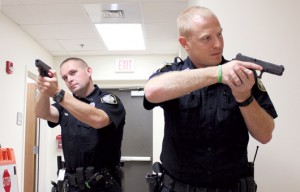 Always at the Ready
Always at the Ready
Officers must maintain a high level of readiness at all times in order to survive any violent confrontation. This is especially important when faced with an ambush-assault scenario. So how do they prepare themselves to mitigate an assault? The answer is simple: Each day, officers should challenge themselves in their training. Every officer should ask themselves if their level of physical fitness, mental preparation and tactical proficiency is at the ready and prepared to combat any threat that they encounter. All officers have a responsibility to maintain a high level of competency in order to carry out their duties. Ideally, each officer is training to a standard of unconscious competence so that their actions and reactions to life-threatening events become second nature. 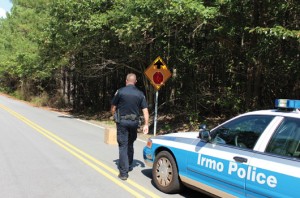 This is important because as the heart rate increases and stress is induced, the human body and mind will experience numerous physiological effects that are debilitative to the cognitive abilities of the officer. Some of these effects include tunnel vision, tachypsychia, auditory exclusion and adrenaline dump. To help control these effects, officers must conduct realistic training that will expose them to various scenarios designed to simulate real-world threats that challenge the officer’s ability to make sound decisions and execute a motor-action response to achieve a desired outcome.
This is important because as the heart rate increases and stress is induced, the human body and mind will experience numerous physiological effects that are debilitative to the cognitive abilities of the officer. Some of these effects include tunnel vision, tachypsychia, auditory exclusion and adrenaline dump. To help control these effects, officers must conduct realistic training that will expose them to various scenarios designed to simulate real-world threats that challenge the officer’s ability to make sound decisions and execute a motor-action response to achieve a desired outcome.
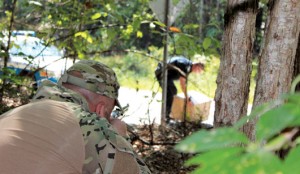 There is an abundance of available resources varying in methodologies. It is not a matter of if but when an officer’s skills will be called to the challenge in a confrontation, so remember that there are a variety of tactics available.
There is an abundance of available resources varying in methodologies. It is not a matter of if but when an officer’s skills will be called to the challenge in a confrontation, so remember that there are a variety of tactics available.
What dictates the tactics that an officer should use? There are several potential factors that must be assessed, with no definitive answer. Some experts will argue that certain tactics are better for a specific threat, but there is no need to overcomplicate any scenario. The threat could range from a physical roadside confrontation to an ambush in an alley. As a general rule, situation and terrain will dictate what tactics and resources are needed to end the threat.
Your Keys to Survival
Help ensure a constant state of readiness through:
- Mental preparation
- Proper nutrition and rest
- Physical fitness
- Carrying the appropriate, properly maintained equipment
- Tactical and weapons proficiency
- Firearms competency
Most confrontations are very dynamic in nature. Therefore, the officer’s tactical response should have the same dynamic ability to evolve as the threat does. While there are countless tactics used in the military and law enforcement, the safety principles that should accompany them are often not emphasized enough. An officer’s tactics can and will change frequently as needed. An example of this is making a passenger-side approach versus a driver-side approach while executing a traffic stop. The tactic may have differed from the norm, but the approach method and safety principles remained consistent with good officer survival techniques. Another example could be making an entry and stacking four officers on one side of the door versus two on each side. The bottom line is that decisions are made by officers to address these dangerous situations. With this in mind, the principles of tactical operations must be at the forefront of any decision, such as maintaining 360-degree security at all times or indexing your finger along the trigger guard when not discharging a weapon. Regardless of assignment, all officers should adhere to the same agency training standards and safety principles. If officers always apply these tactical safety principles, it will exponentially increase the probability of a positive outcome.
Special thanks to the Irmo (South Carolina) Police Department for its active participation in the development of this article.
About the Author
Captain Darren Norris of the Pelion (South Carolina) Police Department has over 27 combined years of military and law enforcement experience. A state-accredited law enforcement instructor since 1995, he has served in patrol, K-9, SWAT and investigations assignments throughout his career and is an active member of Midlands Lodge #1.
Warming Up to Winter
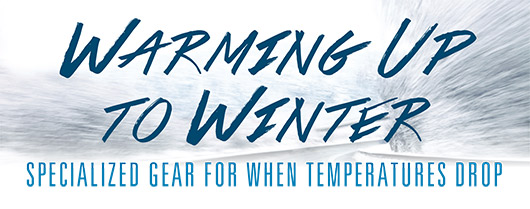 For law enforcement professionals, high-performance clothing is a necessity, because there’s no place for distractions caused by discomfort, poor fit or malfunctions. That’s true any time of year, but when winter weather hits, staying warm and dry is essential for officers conducting duties in the field. If you live and work in a region that’s susceptible to freezing wind or copious amounts of precipitation, you can’t wear just any old jacket or boot and hope to stay comfortable. The key to outsmarting Mother Nature this time of year is to look for certain clothing attributes, such as waterproof, insulated and lined. Here’s a quick sampling of beat-the-sleet items designed with the law enforcement professional in mind.
For law enforcement professionals, high-performance clothing is a necessity, because there’s no place for distractions caused by discomfort, poor fit or malfunctions. That’s true any time of year, but when winter weather hits, staying warm and dry is essential for officers conducting duties in the field. If you live and work in a region that’s susceptible to freezing wind or copious amounts of precipitation, you can’t wear just any old jacket or boot and hope to stay comfortable. The key to outsmarting Mother Nature this time of year is to look for certain clothing attributes, such as waterproof, insulated and lined. Here’s a quick sampling of beat-the-sleet items designed with the law enforcement professional in mind.
 Tru-Spec H2O Proof 3-In-1 Jacket
Tru-Spec H2O Proof 3-In-1 Jacket
Multiseason Cover-Up
Talk about bang for your buck. 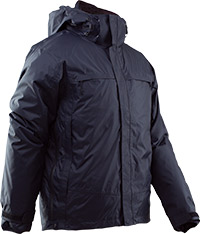 This jacket accommodates varying temperatures and weather factors. For bitterly cold days, zip in the parka lining. On mild days, skip the liner or opt to wear the Inner Cumulus jacket on its own. Together, however, the double-layered jacket is waterproof and windproof. Other features in the improved Tru-Spec H2O Proof 3-In-1 Jacket are large chest pockets with zipper closures, a detachable hood and a side zipper to grant easy access to duty belts. Sizes range from extra small to 5XL. MSRP $243.95.
This jacket accommodates varying temperatures and weather factors. For bitterly cold days, zip in the parka lining. On mild days, skip the liner or opt to wear the Inner Cumulus jacket on its own. Together, however, the double-layered jacket is waterproof and windproof. Other features in the improved Tru-Spec H2O Proof 3-In-1 Jacket are large chest pockets with zipper closures, a detachable hood and a side zipper to grant easy access to duty belts. Sizes range from extra small to 5XL. MSRP $243.95.
Get more information on this product ->
5.11 Tactical Taclite Flannel Pant
Full-Length Comfort
 If you’re already a fan of the 5.11 Tactical Taclite Pro Pant, then you’ll really appreciate the Taclite Flannel Pant. This new design highlights an integrated flannel lining that extends the garment’s wearability into harsh environments. The pant’s outer fabric remains the durable poly/cotton blend with a Teflon finish that resists staining. Closest to your skin, though, is 100% cotton flannel with a luxurious carbonized peach face. There’s also a configuration of multiple pockets and hip-mounted D-rings for convenient key or identification storage. Comes in black, khaki or dark navy. MSRP $74.99.
If you’re already a fan of the 5.11 Tactical Taclite Pro Pant, then you’ll really appreciate the Taclite Flannel Pant. This new design highlights an integrated flannel lining that extends the garment’s wearability into harsh environments. The pant’s outer fabric remains the durable poly/cotton blend with a Teflon finish that resists staining. Closest to your skin, though, is 100% cotton flannel with a luxurious carbonized peach face. There’s also a configuration of multiple pockets and hip-mounted D-rings for convenient key or identification storage. Comes in black, khaki or dark navy. MSRP $74.99.
Get more information on this product ->
Danner Gavre Boot
Firm Footing
 Are you required to patrol over rugged terrain? Maybe you simply enjoy hiking year-round. Either way, going off road on foot means maintaining sure footing with every step. Constructed to perform in mountain warfare situations, the Danner Gavre Boot can handle surfaces ranging from snowy or muddy trails to steep, slippery slopes. Offering high stability via a fully rubberized outsole and integrated polypropylene board, a keen feature for winter is the flexible lacing system. Not only does it move with each step for a consistent and comfortable fit, but the system retains flexibility in any temperature. A Gore-Tex waterproof lining protects feet from rain and snow. MSRP $200.
Are you required to patrol over rugged terrain? Maybe you simply enjoy hiking year-round. Either way, going off road on foot means maintaining sure footing with every step. Constructed to perform in mountain warfare situations, the Danner Gavre Boot can handle surfaces ranging from snowy or muddy trails to steep, slippery slopes. Offering high stability via a fully rubberized outsole and integrated polypropylene board, a keen feature for winter is the flexible lacing system. Not only does it move with each step for a consistent and comfortable fit, but the system retains flexibility in any temperature. A Gore-Tex waterproof lining protects feet from rain and snow. MSRP $200.
Get more information on this product ->
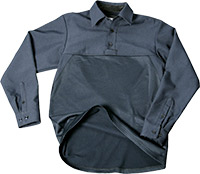
 Blauer ArmorSkin Winter Base Shirt and ArmorSkin
Blauer ArmorSkin Winter Base Shirt and ArmorSkin
Made to Move
Police officers already layer up with safety gear every day, so adding extra layers in the winter can quickly become cumbersome. While outerwear is a must during the winter months, you don’t have to exchange agility for warmth while wearing the Blauer ArmorSkin Winter Base Shirt under its ArmorSkin. The Base Shirt is lined with a moisture-wicking 215-gram microfleece for warmth that accommodates a broad range of motion and easy access to equipment. 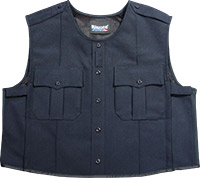 Slip on the ArmorSkin over the Base Shirt for a uniformed look. The top piece can be adjusted at both the shoulders and sides to cover protective gear. MSRP $64.99 for ArmorSkin Winter Base Shirt; $84.99 for ArmorSkin.
Slip on the ArmorSkin over the Base Shirt for a uniformed look. The top piece can be adjusted at both the shoulders and sides to cover protective gear. MSRP $64.99 for ArmorSkin Winter Base Shirt; $84.99 for ArmorSkin.
Get more information on this product ->
 Damascus Gear DZ-9 SubZero Glove
Damascus Gear DZ-9 SubZero Glove
Hand Heater
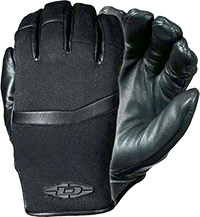 Frozen fingers impede police work, which is why gloves are a definite must-have on the job. Damascus Gear designs specifically for law enforcement and military personnel, and its DZ-9 SubZero Glove is up to the task of a high-demand job in any weather condition. The company guarantees warm hands in frigid temperatures. The pre-curved design maximizes comfort and the full-leather palms aid a sure grip. Glove sizes vary from small to XXL. MSRP $43.20.
Frozen fingers impede police work, which is why gloves are a definite must-have on the job. Damascus Gear designs specifically for law enforcement and military personnel, and its DZ-9 SubZero Glove is up to the task of a high-demand job in any weather condition. The company guarantees warm hands in frigid temperatures. The pre-curved design maximizes comfort and the full-leather palms aid a sure grip. Glove sizes vary from small to XXL. MSRP $43.20.
Get more information on this product ->
Rocky Broadhead Duty Boot
Defy the Downpour
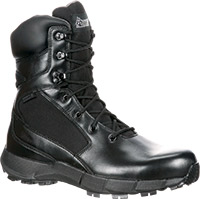 Even if you don’t walk a beat, policing is tough on the feet. It’s important to maintain happy, healthy and, most importantly, dry feet. Rocky offers a 100% guarantee that your feet will stay completely dry in its Broadhead Duty Boot. A spacer mesh allows proper ventilation to prevent sweating, plus you’ll enjoy EVA footbeds and midsoles that make these duty boots feel like athletic shoes and help fight off foot fatigue. MSRP $116.99.
Even if you don’t walk a beat, policing is tough on the feet. It’s important to maintain happy, healthy and, most importantly, dry feet. Rocky offers a 100% guarantee that your feet will stay completely dry in its Broadhead Duty Boot. A spacer mesh allows proper ventilation to prevent sweating, plus you’ll enjoy EVA footbeds and midsoles that make these duty boots feel like athletic shoes and help fight off foot fatigue. MSRP $116.99.
Get more information on this product ->
 Galls Agent LTC Jacket
Galls Agent LTC Jacket
Tough Outer Shell
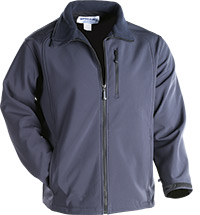 Not every region falls prey to winter’s wild whims. Maybe instead of freezing temperatures, there’s a slight chill in the air, just enough to require a jacket. That’s the ideal scenario for the Galls Agent LTC Jacket. This new design is constructed out of a waterproof polyester shell and lined with fleece. Ten-inch side zippers with snap tabs mean unobstructed access to duty gear or weapons. MSRP $39.99.
Not every region falls prey to winter’s wild whims. Maybe instead of freezing temperatures, there’s a slight chill in the air, just enough to require a jacket. That’s the ideal scenario for the Galls Agent LTC Jacket. This new design is constructed out of a waterproof polyester shell and lined with fleece. Ten-inch side zippers with snap tabs mean unobstructed access to duty gear or weapons. MSRP $39.99.
Get more information on this product ->
SealSkinz Thermal Waterproof Cap
Top It Off
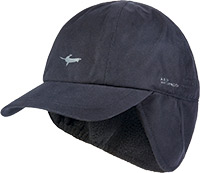 Exposing your head during rough weather can leave you wet and cold, so be sure to cover it up with a cap meant to repel moisture. The Thermal Waterproof Cap by SealSkinz has received a thermal rating of four, designating it fit for subzero climates. Made of durable, breathable and flexible material, it is also windproof. Pull-out earflaps provide extra coverage. MSRP $55.
Exposing your head during rough weather can leave you wet and cold, so be sure to cover it up with a cap meant to repel moisture. The Thermal Waterproof Cap by SealSkinz has received a thermal rating of four, designating it fit for subzero climates. Made of durable, breathable and flexible material, it is also windproof. Pull-out earflaps provide extra coverage. MSRP $55.
Get more information on this product ->
LawPro Waterproof Insulated Duty Glove
Warm to the Touch
 LawPro employed a multifaceted approach to creating its Waterproof Insulated Duty Glove. First is the HiPora liner for waterproof protection. Then there’s a Thinsulate Insulation to block out cold and trap heat. Another element is GripSkin palms to ensure a firm grasp in inclement weather. Finally, neoprene keeps air flowing, prohibiting sweat buildup, and Velcro wristbands adjust to your perfect fit. MSRP $26.29.
LawPro employed a multifaceted approach to creating its Waterproof Insulated Duty Glove. First is the HiPora liner for waterproof protection. Then there’s a Thinsulate Insulation to block out cold and trap heat. Another element is GripSkin palms to ensure a firm grasp in inclement weather. Finally, neoprene keeps air flowing, prohibiting sweat buildup, and Velcro wristbands adjust to your perfect fit. MSRP $26.29.
Get more information on this product ->
Hammacher Schlemmer Waterproof Sock
High and Dry
 Fleece jackets are great at keeping the upper body warm, but what about your lowest extremities? Hammacher Schlemmer’s Waterproof Socks have been tested to keep the heat in extremely cold temperatures, even as low as -30 Fahrenheit. Dual layers work together to stay dry, including an expedition-weight, double-velour Polartec fleece that wicks moisture away from sensitive skin. These socks must also pass a test to make sure that they prevent leaks. MSRP $54.95.
Fleece jackets are great at keeping the upper body warm, but what about your lowest extremities? Hammacher Schlemmer’s Waterproof Socks have been tested to keep the heat in extremely cold temperatures, even as low as -30 Fahrenheit. Dual layers work together to stay dry, including an expedition-weight, double-velour Polartec fleece that wicks moisture away from sensitive skin. These socks must also pass a test to make sure that they prevent leaks. MSRP $54.95.
Get more information on this product ->
Click here to enter the Beat the Sleet Sweepstakes!
Sound Advice

Think about all the noises you hear on a daily basis: sirens, motorcycle motors, loud radio calls and, of course, the potential of gunfire. Then there are the decibel blasts produced at the firing range. Repeated exposure to loud noises places law enforcement professionals (LEPs) at greater risk of hearing loss than the general public. In one survey of LEPs, more than half voiced concerns that workplace noise could likely damage their hearing, and more than three-quarters felt that hearing impairment could negatively affect their job performance. Considering that most hearing loss is permanent, it pays to invest in protective gear for your ears, such as the products below.
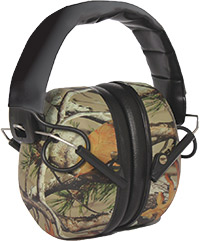 Radians 430-EHP Earmuffs
Radians 430-EHP Earmuffs
Volume Control
Whether practicing your shooting skills to become more proficient on the job or as a competitive pastime, each time the trigger is squeezed, you expose your eardrums to an explosive, potentially damaging sound. That’s why firing ranges mandate hearing protection devices. Once a noise measures at least 86 decibels, the Radians 430-EHP Earmuffs’ electronic circuit automatically kicks in to mute the impact and protect the wearer. Boasting a noise reduction rating of 26 on a 1-to-34 scale, the device also possesses an independent microphone programmed to detect and amplify low-sound levels. The battery lasts up to 200 hours. MSRP $34.99.
Get more information on this product ->
SureFire EP3 Sonic Defenders Earplugs
Sound Distinction
 Proper hearing protection shouldn’t drown out all noises. It’s crucial for officers to distinguish acceptable sounds while creating a defense against dangerous volumes. The EP3 Sonic Defenders by SureFire make this distinction for you. The earplugs allow safe-level sounds to pass through undeterred, while sounds reaching 85 decibels or louder are directed through a noise-reducing filter. Of course, comfort is a big factor, too. These devices are molded out of a soft, hypoallergenic polymer that not only provides a cushy fit, but an extended lifecycle when properly cared for. Earplugs fit conveniently under helmets and masks. MSRP $13.95.
Proper hearing protection shouldn’t drown out all noises. It’s crucial for officers to distinguish acceptable sounds while creating a defense against dangerous volumes. The EP3 Sonic Defenders by SureFire make this distinction for you. The earplugs allow safe-level sounds to pass through undeterred, while sounds reaching 85 decibels or louder are directed through a noise-reducing filter. Of course, comfort is a big factor, too. These devices are molded out of a soft, hypoallergenic polymer that not only provides a cushy fit, but an extended lifecycle when properly cared for. Earplugs fit conveniently under helmets and masks. MSRP $13.95.
Get more information on this product ->
 New Motorola Solutions Tactical Boomless Temple Transducer
New Motorola Solutions Tactical Boomless Temple Transducer
High-Tech Protection
For scenarios in which hands-free communication becomes paramount, the Motorola Solutions Tactical Boomless Temple Transducer enables officers to receive radio communication via bone vibrations guided to the inner ear canal, allowing them to be simultaneously hands-on with other tasks. The Transducer also comfortably fits under traditional hearing protection and helmets. This ensures hearing health in critical circumstances that may call for loud tactics such as stun grenades, but the versatile Transducer accommodates regular environmental noises as well. MSRP $377.
Mental Fitness
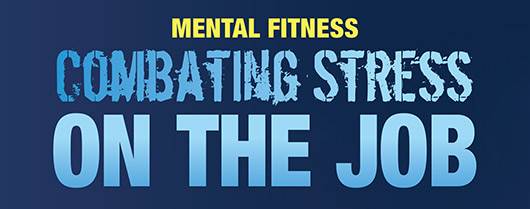
Every law enforcement officer expects to experience some stressful moments at work. Many, however, are not prepared for exactly how stressful their daily duties will be, and police culture still has trouble fully comprehending and acknowledging the pain that stress can cause.
“An officer often thinks that ‘If I tell a mental health practitioner, administration is going to take me off the street and take away my gun and put me on the desk, and that is the last thing I want to have happen,’” says Deirdre DeLong, Program Director for the Critical Incident Response Service at Fraternal Order of Police of Ohio.
Emotional wellness and safety can no longer be ignored, however. They are being pushed to the forefront of education and outreach efforts as more officers struggle with critical incidents, unstable communities, national exposure and stretched-out resources. Here are some of the most common day-to-day psychological stressors that officers are exposed to, along with expert advice on how to handle them in practical ways before they impact your personal or professional life.
ADMINISTRATIVE STRESSES
Cause: Misunderstandings between patrol and upper management. Each group may not be fully aware of where the other is coming from and what the daily grind of their job is really like.
Symptoms: It creates a lack of respect and trust between officers and leadership that manifests as an “us versus them” mentality, says DeLong. Hallmarks include tense communication, either verbal or nonverbal, or blatantly ignoring that the other exists. Anger boiling just beneath the surface can explode at seemingly unexpected moments.
Coping strategy: “Just talking to each other can ease tension,” says DeLong. One of you will have to be the bigger person, though, and invite the other to sit down, either during a slow shift or while off duty. The conversation is not a time to point fingers, but rather to ask questions and actually listen to answers. “Discuss your goals, both as individuals and as a team,” suggests DeLong. If communicating is too uncomfortable, take a moment to put yourself in each other’s shoes. Administrators need to do better at rewarding patrol officers for a job well done. Patrol officers must understand there may be some inside police politics that affect how administrators are allowed to do their jobs.
FAMILY LIFE
Cause: Inability to communicate with spouse, children or other family members.
Symptoms: Sometimes the very thing that is supposed to offer police officers respite from their careers becomes the biggest stressor in their lives. That’s because, over time, officers can become detached from their families, explains Stephanie Samuels, a psychotherapist from New Jersey who works exclusively with law enforcement and first responders. Officers spend so much time trying not to talk about their feelings that they end up going numb and begin acting out in other harmful ways. “Sometimes it’s that that they do not want to expose their loved ones with what they’ve been through, or they don’t want to have to relive the horror that they just experienced,” she says. “What ends up happening, though, is that they seek out another person to tell that stuff to and that devolves into an affair, or they turn to drugs, alcohol or some other adrenaline-seeking rush.”
Coping strategy: Getting in touch with a therapist who understands law enforcement culture is key. “These types of therapists get the thoughts, impulses, desires to act out and adrenaline-seeking behavior better than anyone,” says Samuels. “Normally, however, officers don’t contact a therapist until they’ve already acted out.” She also recommends maintaining friendships outside of law enforcement: “Officers start to lose their civilian way of thinking, so any small problem an officer is having may be exacerbated by only having law enforcement friends. Whereas a law enforcement friend may tell another officer to ‘have a drink’ at the end of a hard day, a civilian friend might ask more questions in a nonthreatening, caring way that allows the officer to just vent.”
AMBIGUITY
Cause: Continually worrying about your safety, not knowing what situations you’ll encounter.
Symptoms: For patrol officers, every shift and every call has a sense of ambiguity, says Dr. Jay Phillippi, staff psychologist at the Fargo (N.D.) VA Medical Center and also a former police officer. Officers cannot trust that they will come out of a situation safely, and over time, that can wear away at their resilience. They can become irritable and resistant to even the smallest change.
Coping strategy: Try to develop your own post-call or post-shift routine, so if something goes awry you have something stable to return to. Some examples may be heading back to the station and writing a report right away, or calling your spouse and discussing dinner plans. “You’re looking for something very well established and grounded that helps put you back in the here and now,” says Phillippi.
CONSTANT SCRUITINY
Cause: Enduring public surveillance through a 24-hour news cycle, social
media and camera phones.
Symptoms: Conducting yourself while on camera, or even feeling like you’re on camera, creates a heightened experience. Your emotions may be difficult to control, and things may feel like they’re happening faster than they already are. This can lead to overreacting, or on the flip side, indecision while on scene. Either way, officers who feel their actions are always being captured and scrutinized may eventually develop a dislike for the community that they are charged with serving, says DeLong.
Coping strategy: DeLong’s advice is to quit media cold turkey. Don’t read or watch the news, but if you just can’t help it, avoid the comments. Definitely talk with your fellow officers or administrators, but don’t get sucked into belittling the community you serve. Communicating with your family or other positive neighbors will help you keep perspective.
DEPERSONALIZATION
Cause: Exposure to too much human misery can numb your feelings toward the people you serve.
Symptoms: Officers in the throes of depersonalization may come across as wooden, stiff, rude or gruff. They may complain all the time and not show emotion or empathy when dealing with people on calls, even upstanding members of society. “When you have people complaining about you, that’s a big red flag,” says Phillippi.
Coping strategy: The best remedy for depersonalization is balance, says Phillippi. Participate in activities that are not police-related in your downtime. Embrace your family or support system to lift you up. Police administrators shouldn’t let their officers feel like they’re fighting an uphill battle alone, Phillippi cautions. If departments recognize that some of their officers are struggling with depersonalization issues, they should organize police-related activities within the community. “For example, my previous department in Moorhead, Minnesota, runs a Cops ’N Kids hockey game where members of the various law enforcement departments play a game to raise money for charity. It’s a great way to get officers involved with real people in the community so they can see real value among the people they’re serving,” says Phillippi.
OVERSPENDING
Cause: A sense of entitlement that comes from seeing people die unexpectedly, both from civilian and fellow officer deaths. Officers begin to justify living beyond their means because they think they’ll die young, too.
Symptoms: Samuels says overspending is often the result of officers stuffing their feelings inside for too long. “It’s another example of a high-risk behavior like drugs or alcohol or gambling that gives them an adrenaline rush,” she says. The problem is that it creates a vicious cycle within their family. The officer has spent so much money as a coping mechanism that they need to start working more overtime. Then, their spouse or children begin complaining that they never see the officer anymore. The officer becomes angry with their spouse or children for not respecting the amount of time he or she is spending at the job to afford their nice lifestyle. Everyone feels angry and disappointed. The officer may then buy more stuff to make everyone feel better, and the cycle perpetuates. Families get torn apart when the spouse finally decides enough is enough.
Coping strategy: Therapy will likely be necessary to break the cycle, but the officer has to be open to admitting something isn’t right and swallowing a bit of pride. “An officer will really have to hear what people are saying without being defensive,” says Samuels. It often takes the threat of divorce and losing time with children, however, before an officer will grasp the need for change, she says. Once an officer reaches that point, it’s like an automatic wake-up call in most cases. “They realize that once they’re done with this career they really want their family in their life and their behavior is affecting the long-term likelihood of that happening.”

